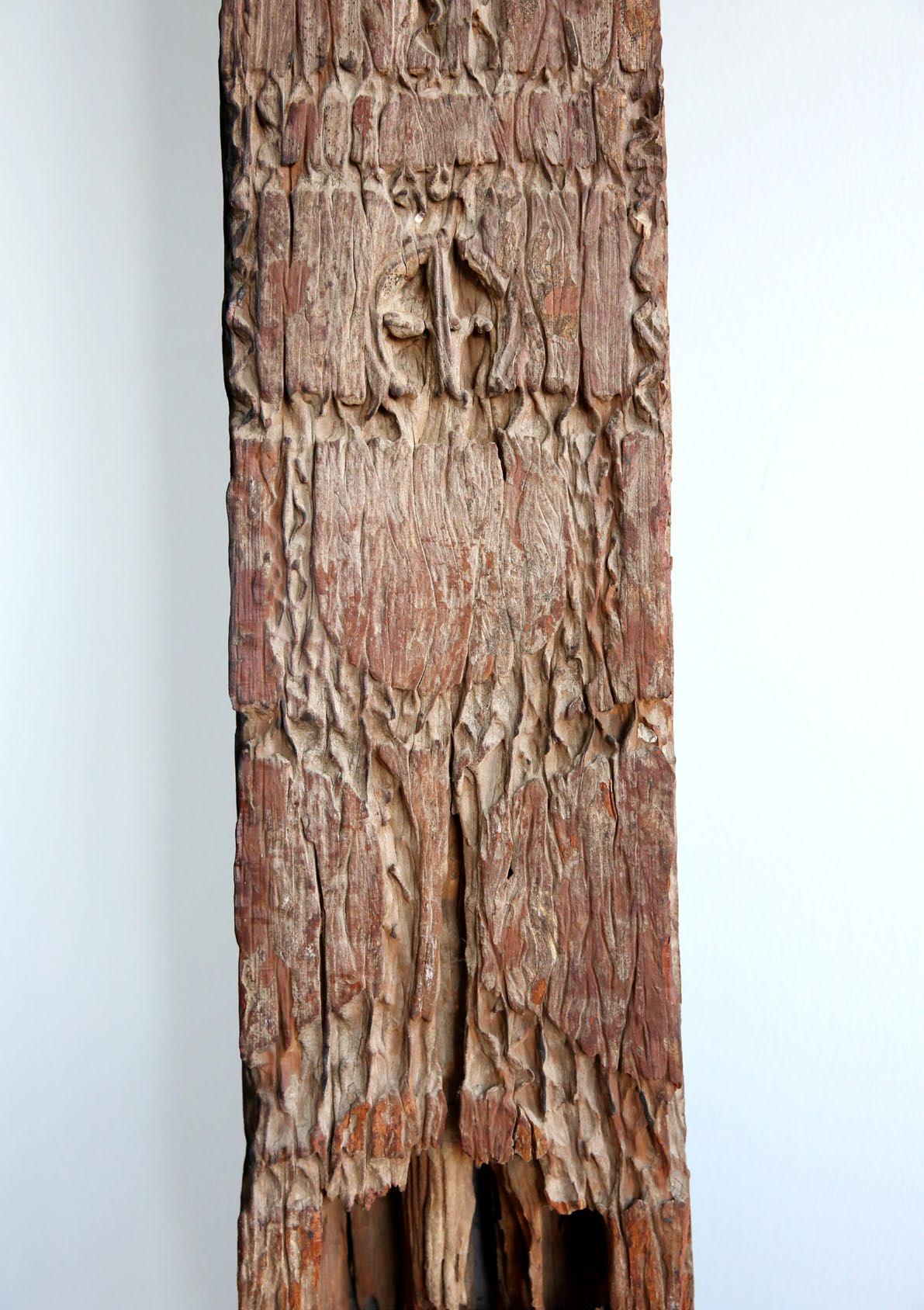Gold never gets old



Throughout history and across civilizations, gold has held a profound allure as a material for crafting works of art. Its lustrous beauty, rarity, and enduring value have made it a symbol of wealth, power, and divine status. In Asia, gold has been revered for millennia as a symbol of prosperity, purity, and spiritual enlightenment. In Hinduism, gold holds sacred significance and is associated with the gods and goddesses. In Chinese culture as a symbol of wealth, power, and immortality. In Southeast Asia, gold artifacts discovered in ancient burial sites attest to the region's rich tradition of gold craftsmanship and metallurgy.
Beyond Asia, tribal societies across Africa, the Americas, and Oceania have also incorporated gold into their artistic traditions and cultural practices. In Africa, gold has been prized for its beauty and rarity since ancient times. Gold has served as a universal symbol of beauty, wealth, and spiritual significance in the art and culture of both Asian civilizations and Tribal societies. Its enduring allure continues to inspire artists and craftsmen to create works of unparalleled beauty and meaning. Gold is not the only medium that has a mystique that transcends its material worth. From opulent textiles, beads, precious pigments, furs to exquisite ceramics, there are countless mediums that have evoked the timeless allure of opulence and grandeur...
"The Moon was but a Chin of Gold A Night or two ago And now she turns Her perfect Face Upon the World below"
Emily Dickinson
R OC k CRYSTAL w EIGHT
China
Southern Song Dynasty (1127-1279)
Diameter: 5,7 cm
Thickness: 1,3 cm
Price on request
O B j ECT P RESENTED BY: Rasti Fine Art Ltd.
M.:+852 2415 1888
E.: gallery@rastifineart.com w.: www.rastifineart.com
A rock crystal robe weight in the form of a bi-disc, the pure thickly formed stone highly polished and of clear tone with a subtle cloud inclusion
For an almost identical rock crystal robe weight in the form of a bi-disc with original silk cord from the Southern Song period see Treasures of Zhejiang: Tales Told by 100 Selected Cultural Relics, pp. 232-233, pl. 72; and for a rock crystal see Cai, Dynastic Renaissance: Art and Culture of the Southern Song, Antiquities, p. 221, pl. 89.
VETTED BY:

Goldweight mesure
Akan
Ghana/Ivory Coast
19th century
Copper and copper alloy
Diam.: 10 cm
Provenance:
Private collection, Spain
Publication:
west African Gold Ornaments.
Galeria David Serra-Fine Tribal
Art. Barcelona, june 2022, p.25
Price: 3.500 euros
O B j ECT P RESENTED BY:
David Serra
T.: +34 (0) 667525597
E.: galeria@davidserra.es w.: www.davidserra.es
VETTED BY:


China
Qianlong Mark and Period, Qing
Dynasty 1711-1799
Height: 3,9 cm
Provenance:
By repute, The Chinese Porcelain Company, New York acquired in the 1980’s
English private collection, 198090’s
Price on request
O B j ECT P RESENTED BY: Sue Ollemans
M.: + 44 (0) 7775 566 356 E.: sue@ollemans.com w.: www.ollemans.com
VETTED BY:
The simple elegant cup is attributed to the Palace workshops. In 1696 the fourth Qing Emperor k angxi. Established the Imperial Palace Glassworks in the Yangxindian, within the Imperial Palace. It was charged with making glass primarily for the Imperial Family, the works being supervised by European missionaries and the craftsmen brought to Beijing from Boshan an important source of materials for glass making. The Qianlong Dynasty being regarded as the golden period of Chinese glass production.
The archives of the Imperial Household Department of the Qing Dynasty refer to nine shades of yellow, with the opaque yellow described as Imperial Yellow.


Yellow extended beyond the emperor's attire and architecture; it also permeated the daily objects of the royal family. For instance, the emperor's utensils and the Four Treasures of the Study often favored the use of yellow. This use of color undoubtedly strengthened the connection between yellow and the concept of divine right to rule.
According to ""The Rites of Zhou,"" yellow represents the element ""earth"" in the Five Elements theory, associated with centrality, balance, and stability. Thus, yellow carries a wealth of symbolic meaning in Chinese philosophy.
Yellow, the royal color used by the emperors, represents power and authority. It is associated with the Earth Element, which symbolizes growth (The Chinese word for yellow, huang, sounds like the word for ""royal,"" and thus was chosen thousands of years ago as the exclusive color for the imperial household.
Timor, Indonesia
19th century or earlier Gold
Diam.: 7,5 cm
Price: 7000 USD
O B j ECT P RESENTED BY:
Thomas Murray
M.: + 1 415.378.0716
E.: thomas@tmurrayarts.com w.: www.tmurrayarts.com
VETTED BY:
The tribal societies of the Eastern Islands of Indonesia share multiple common cultural features. From Timor to Tanimbar and beyond the fashioning of precious metal disk pectorals to be worn as emblems of chiefly authority may be observed. Shown here is a very early example displaying the classic architecture of a “breast-like” dimple in the center and punched border decoration around the circumference hanging on its original hand-forged gold chain. A patina of this depth is likely to have taken centuries to build up.

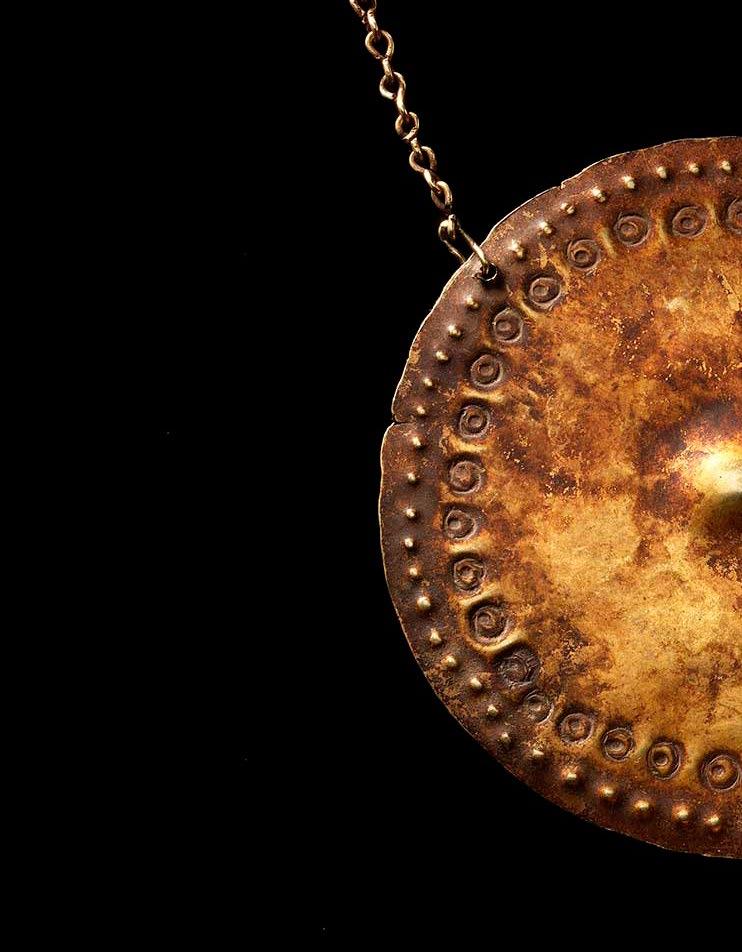

M INANG k ABAU E ARRING PAIR
Large Earring Pair, Sumbek Talingo, with wood Box Minangkabau west Sumatra, Indonesia 19th century Gold, diamonds, metal Each: 7,5 cm x 7,5 cm
Price: 9.500 USD
O B j ECT P RESENTED BY: Thomas Murray M.: + 1 415.378.0716 E.: thomas@tmurrayarts.com w.: www.tmurrayarts.com
An important pair of heirloom gold ear ornaments worn by Minangkabau women of noble class; The diamonds are rough cut, traded into Sumatra from k alimantan, Indonesian Borneo.

VETTED BY:
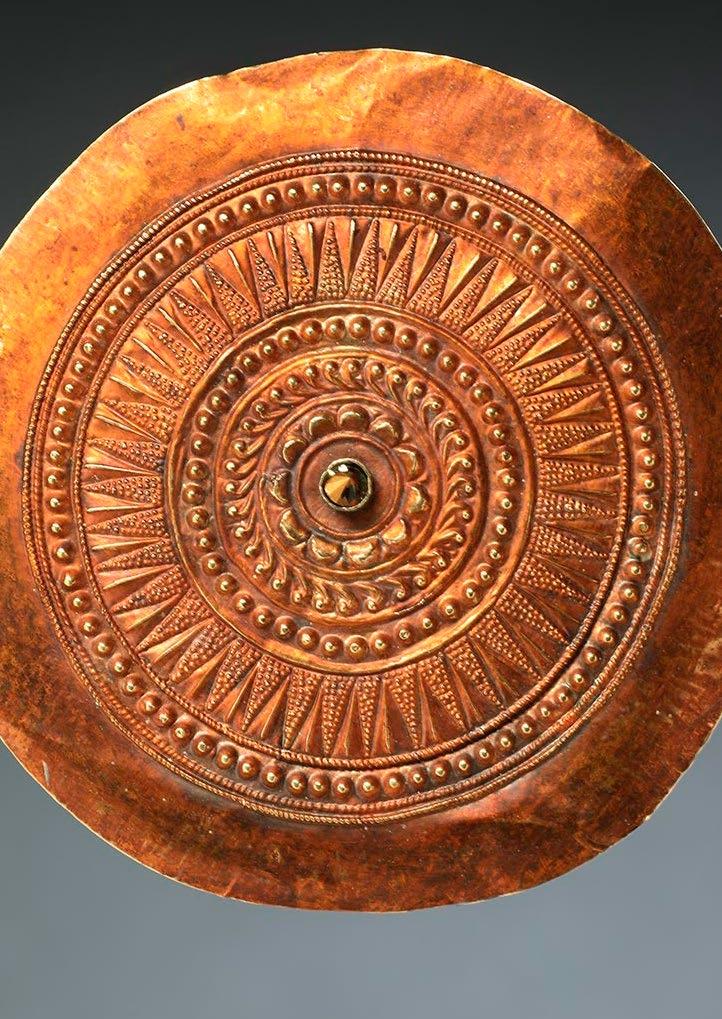
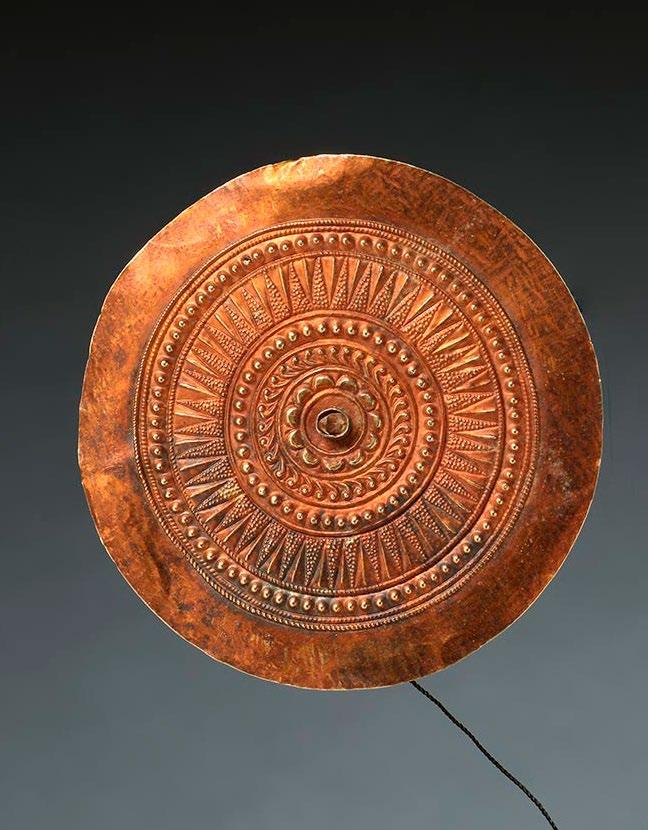
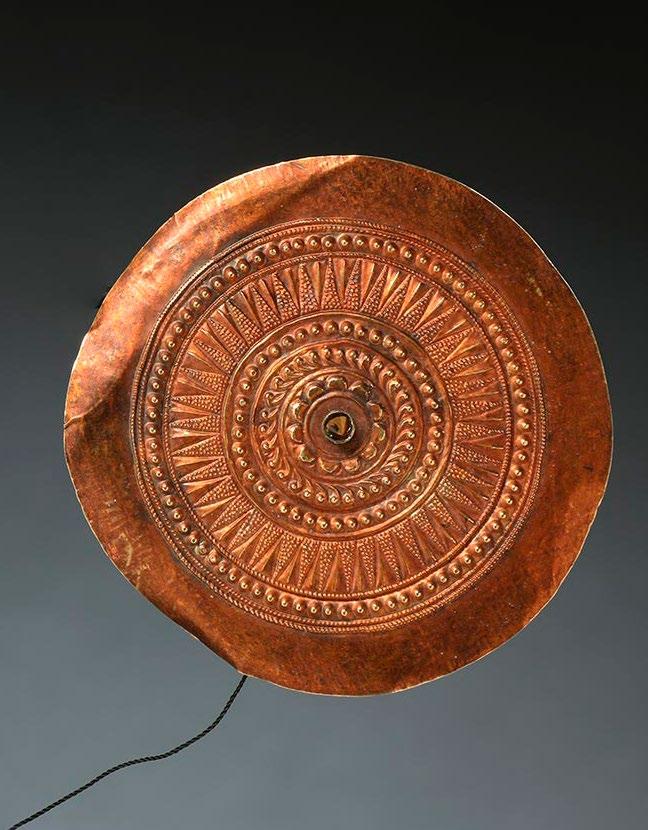
T E k E BRACELET
Chief brass bracelet Teke
Brazzaville, Congo
Diam: 8 cm
Provenance:
Brought back before 1920
Price: 500 euros
OB j ECT P RESENTED BY: Renaud Vanuxem
M.: +33 6 07 11 50 60 E.: rvanuxem@yahoo.fr w.: www.renaudvanuxem.com
VETTED BY:

T E k E TORQUE
Chief brass torque Teke Brazzaville, Congo
Diam.: 30,5 cm
Provenance:
Brought back before 1920
Price: 1.000 euros
O B j ECT P RESENTED BY: Renaud Vanuxem
M.: +33 6 07 11 50 60 E.: rvanuxem@yahoo.fr w.: www.renaudvanuxem.com
VETTED BY:

T E k E TORQUE
Chief brass torque Teke Brazzaville, Congo
Diam :29,5 cm
Provenance:
Brought back before 1920
Price: 1.200 euros
O B j ECT P RESENTED BY: Renaud Vanuxem
M.: +33 6 07 11 50 60 E.: rvanuxem@yahoo.fr w.: www.renaudvanuxem.com
VETTED BY:

"Goldfinger, he's the man The man with the midas touch
A spider's touch
Such a cold finger Beckons you to enter his web of sin But don't go in"
Goldfinger, Shirley Bassey
Chettiars Nattukottai
Tamil Nadu, South India 19th century
Inset with rubies and red stone, part of a k ali Thiru (auspicious necklace)
Length: 12 cm x 10 cm
Provenance:
Private English collection Price on request
O B j ECT P RESENTED BY: Sue Ollemans
M.: + 44 (0) 7775 566 356 E.: sue@ollemans.com w.: www.ollemans.com
VETTED BY:
The Chettiars were former salt merchants belonging to the caste of rich merchants who were once settled on the Coromandel Coast and later migrated inland. The auspicious wedding necklaces were comprised of large central pendants and several smaller ones such as this that would flank the central pendant. These pieces evoked crab claws and shells that the Chettiars wore as ornaments or would represent the hands of the bride and groom.
These necklaces were part of the dowry offered by the parents to their daughter. They were considered as auspicious and protective and under Hindu law remained undisputedly her property to be used for her protection and security.
The word Tali comes from the name of a palm tree, the talipet that in some communities is used as a single strip of palm leaf tied around the bride’s neck to serve as a marriage emblem. The use of this auspicious emblem goes back into antiquity and in Southern India marriage tokens are strung on a sacred yellow thread and tied with three knots around the neck of the bride invoking the blessings of the Trinity: Brahma, Vishnu, and Shiva.
Similar Examples. Barbier Mueller Museum, Geneva, Switzerland.
Metropolitan Museum, New York, United States of America.
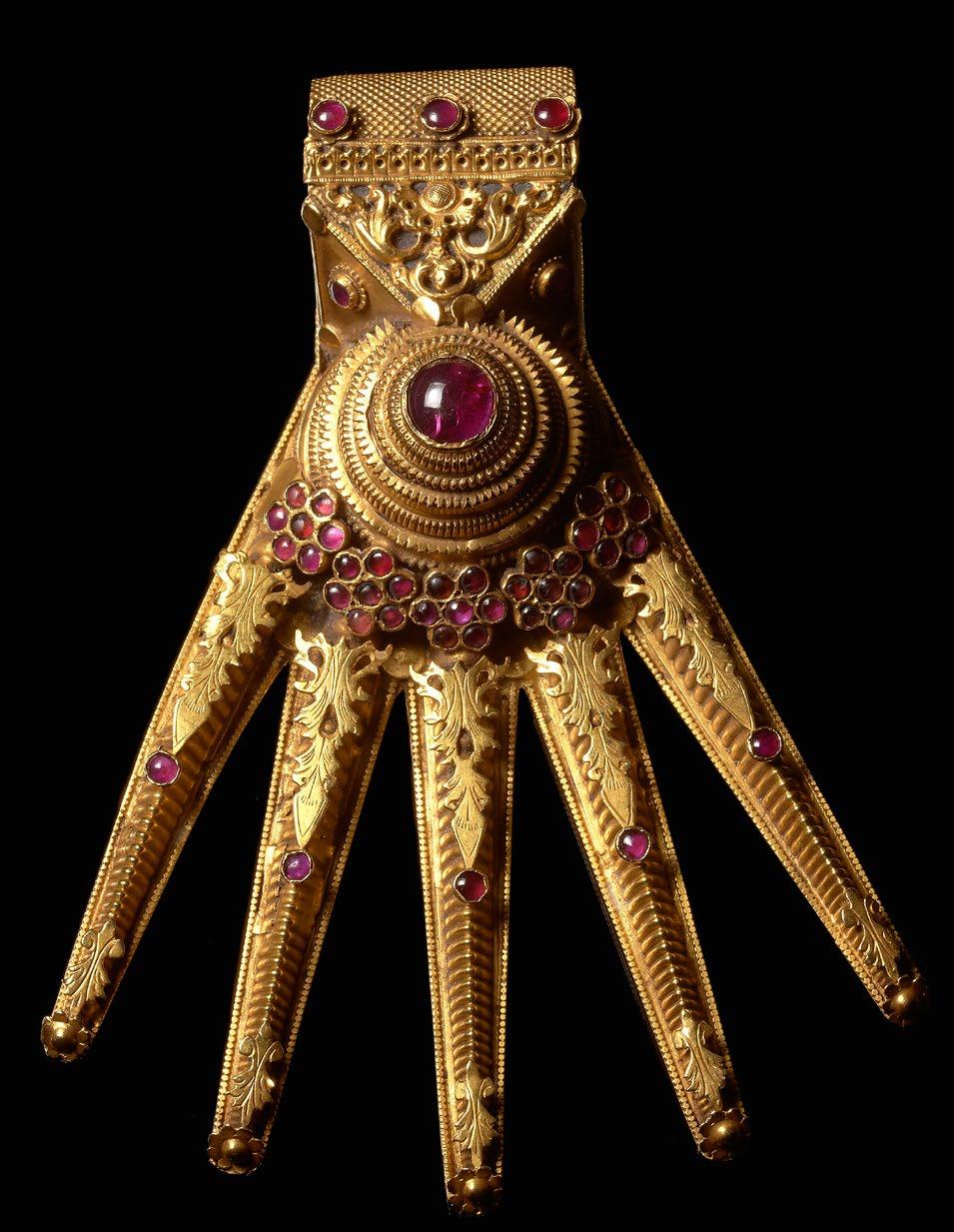
F OUR S IL k P URSES
China
19th century
Pouch: 10 cm
Strap: 70 cm
Price on request
O B j ECT P RESENTED BY:
Brandt Asian Art
M.: +44 (0)7774 989 661
E.: brandt@nildram.co.uk w.: www.brandtasianart.com
An extremely rare set of four silk purses worked in fine needlepoint with a long-life symbol above a waved border, each with string ties.
All attached to a brass ruyi formed clasp, and further brass buckle with the symbol Zhong and Xiao, meaning respect. The original silk strap has attached brass clasp with bat design.
VETTED BY:

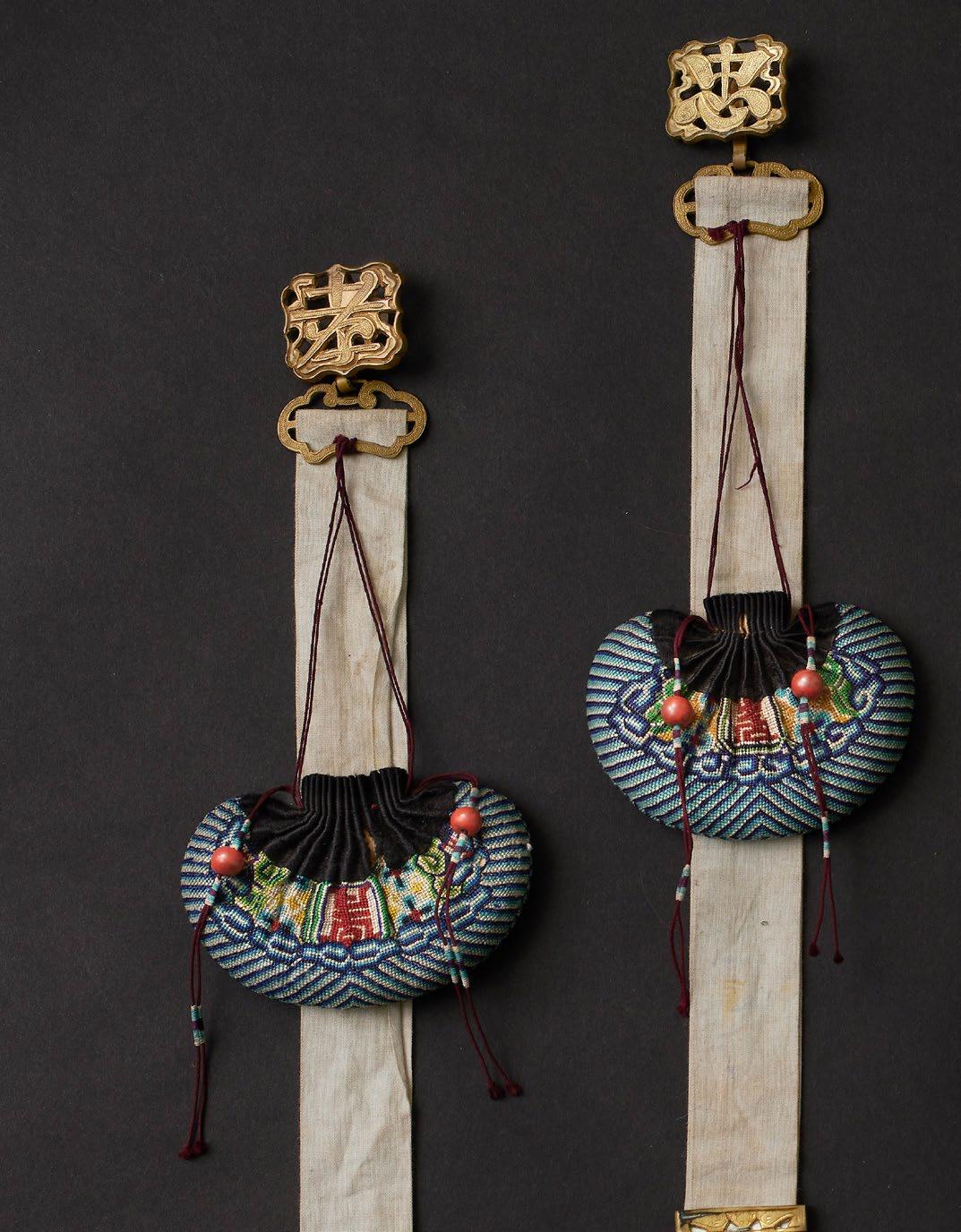

jingdezhen, China
Imperial kilns 1790-1810
Height: 6,71 cm
Mouth/lip: 0,75/1,85 cm
Cold pigment of red, green and gold colour on porcelain stopper (circa 2006)
Provenance:
john F. Ruckman
Charles V. Swain (No. 245)
Christie’s, Paris, 21 November 2008, lot 39
Hugh Moss (Hk ) Ltd
Price on request
O B j ECT P RESENTED BY:
Pavilion, London
T.: +44 (0) 7523 018239
E.: info@paviliongallery.com w.: www.paviliongallery.com
VETTED BY:
Famillé rose enamels on colourless glaze on white porcelain; of compressed, elongated apple shape with a waisted neck, flat lip and protruding, flat oval foot; moulded on each main side with an identical design of Shoulao, the God of Longevity, holding a walking staff with double gourd tied to its upper end, standing beside a deer with a lingzhi in its mouth beneath a flying bat, all set on a ground of formalized wan (ten thousand) design, the two sides with differing colour schemes, the two sides separated by a raised vertical band on the narrow sides, the neck with a band of formalized lingzhi, the ground designs, lip and foot all covered in gold enamel.
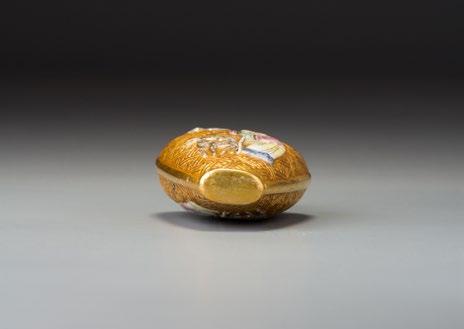

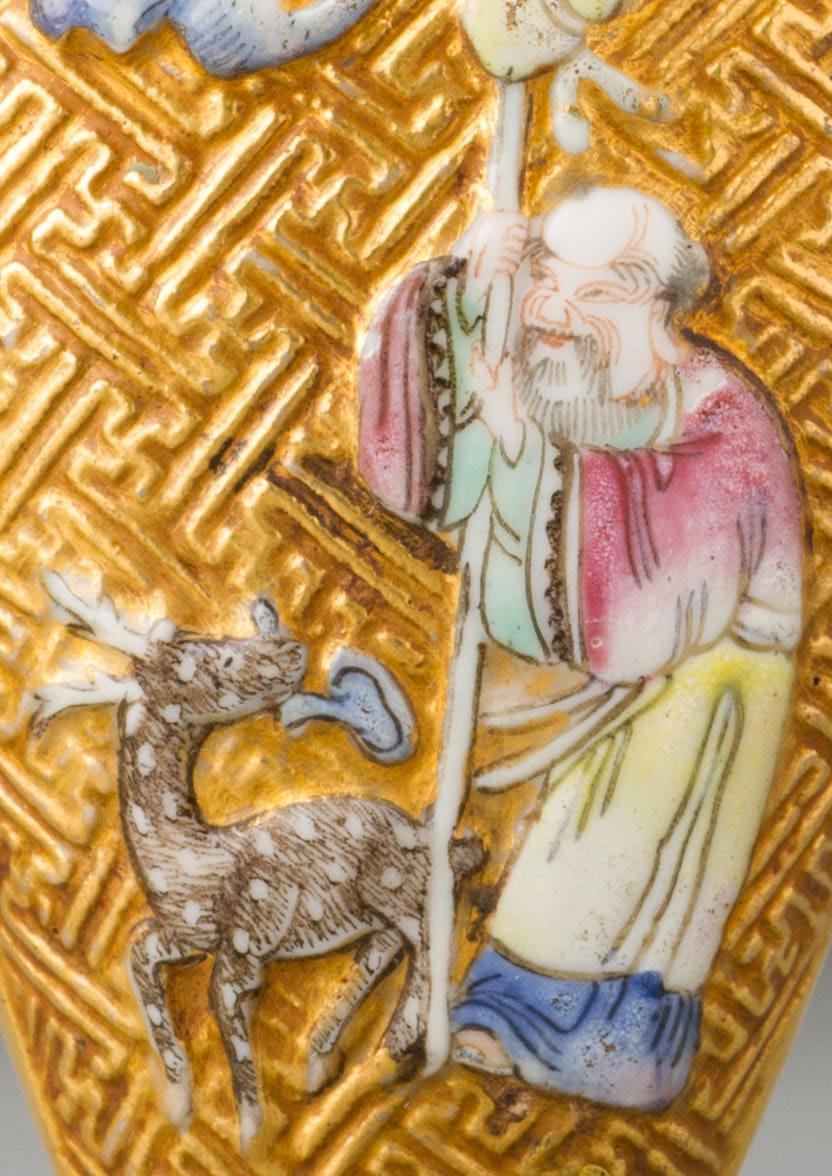




"I believe in the Golden Rule - The Man with the Gold... Rules." Mr. T
C HIEF’S C RO w N AND SCEPTER
Crown and scepter in the form of a Pith helmet and pipe Baule
Ivory coast
Early 20th century
Gilt-wood
Crown: 13 cm (h) x 33,5 (L) x 26 cm (D.)
Length: 14 cm (sceptre)
Height: 51 cm (incl. stand)
Provenance:
Private collection, Paris Price on request
Rivalry between the kings or chiefs was, and still is, common in the regions of Ghana and Ivory Coast. In this case the chief, who before flaunted with a traditional crown, clearly thought the ‘fashionable’ Pith helmet of a European colonialist or visitor would outshine the crown of his neighbouring competitor. Certainly, this giltwood version, together with a scepter in the form of a European pipe, did the job. Nowadays, Bouelé people are still seen wearing fashionable designer brand sunglasses, purses, or other accessories, all made of gilt wood.
O B j ECT P RESENTED BY:
Zebregs&Röell
+31 6 207 43671
dickie@zebregsroell.com www.zebregsroell.com
VETTED BY:
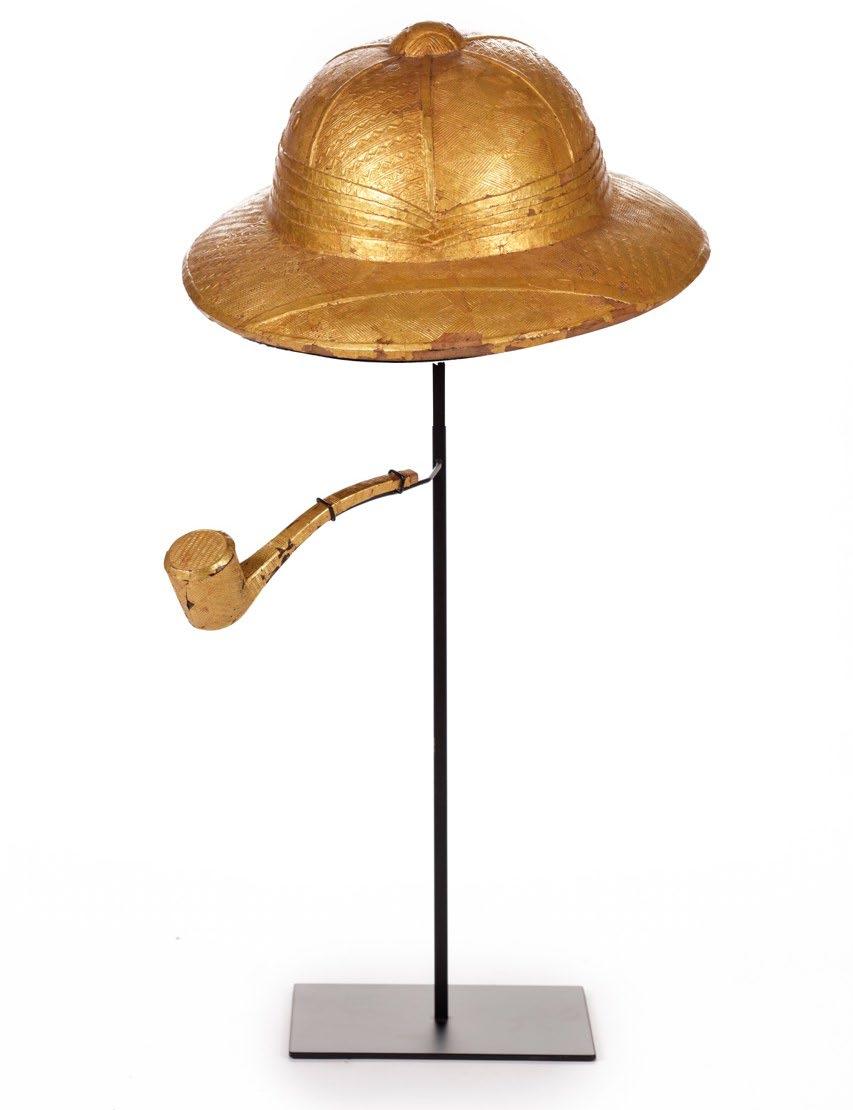
kuba
D.R. of the Congo
Early 20th century
Buffalo horn, metal
Height: 38 cm
Provenance:
Private collection, Belgium
Pascal Vernimmen, Belgium, 2022
Duende Art Projects, Belgium, 2022
Price on request
ART w OR k P RESENTED BY:
Duende Art Projects
T.:+32 485 98 20 36
E.: bruno@duendeartprojects.com
w.: www.duendeartprojects.com
Drinking horns and cups are among the many insignia that have denoted status in the highly hierarchical kuba society since the kingdom’s foundation in the 17th century. Drinking vessels fashioned from the horns of the bush buffalo were exclusively used by specific kuba noblemen as emblems of their title. The choice for this material must have been emblematic of the power of their owners. The present buffalo horn features concentric circles, geometric shapes and beadlike bands carved in high relief that elegantly follow the natural contours of the horn to its pointed tip. A cord pierced through the tip of the horn allowed it to be worn by its owner as part of his insignia. The emphasis on titleholding and the competition for and the subsequent prestige that accrues to titleholders has historically been a dominant aspect of kuba culture. Each tiled position had emblems, symbols, and praise names associated with it. This vibrant aspect of their culture was photographed in 1970 by Eliot Elisofon, observing several kuba elders that still wore extensive regalia. A warrior is wearing several undecorated buffalo horns at the back of his belt. Older examples such as the present typically feature elaborate ornamentation. Scarification was a common form of body
VETTED BY:
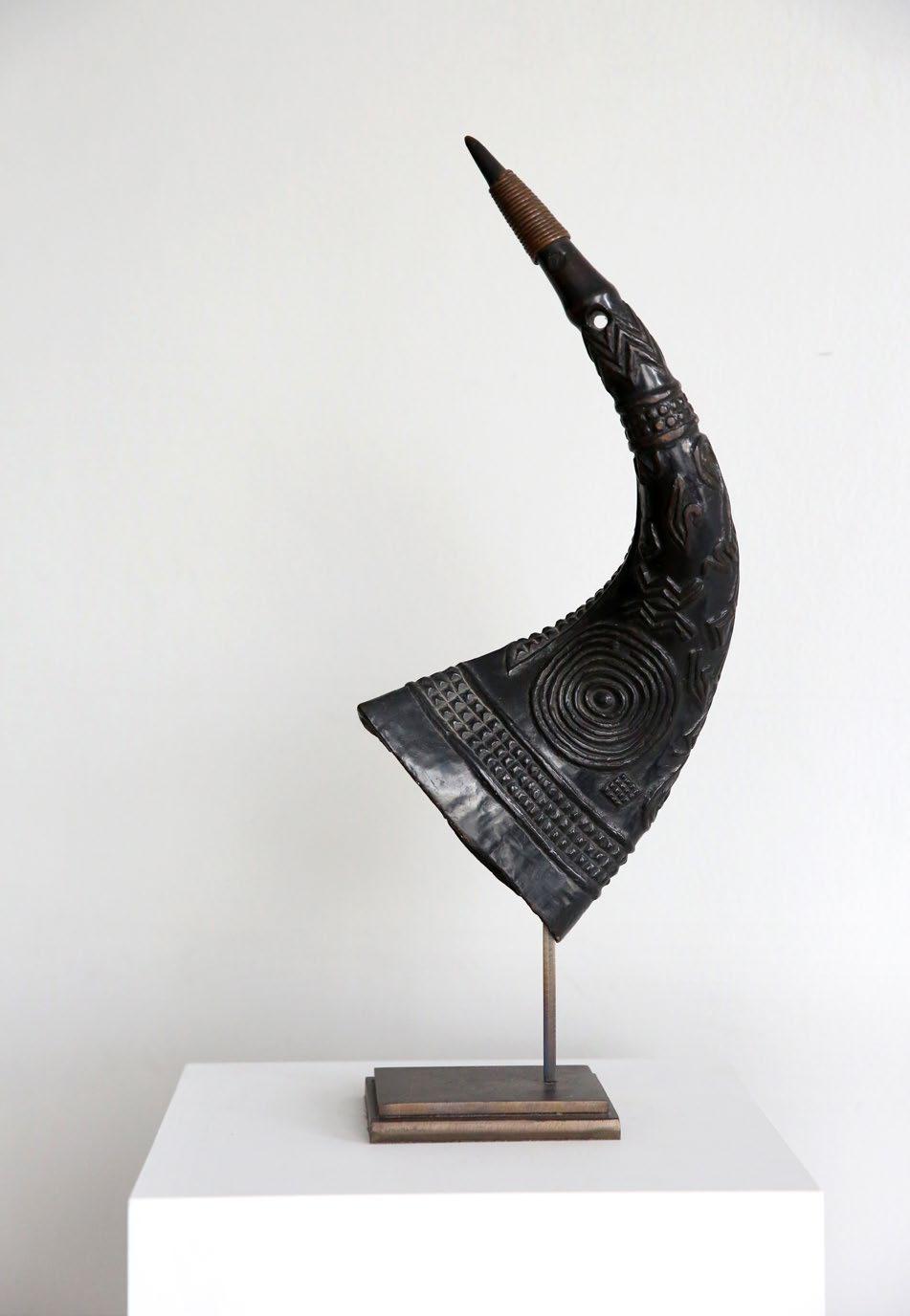
decoration among the kuba, and the designs in high relief across the surface of this drinking horn mirrored the traditional raised patterns of scarified human skin.
Eliot Elisofon visited the village of Bungamba (Bongamba, Bongaam) between Mweka and Luebo, in the kuba region in 1970. The photograph depicts a high-ranking kuba warrior wearing traditional costume, as well as symbolic adornments, for the state visit of the Nyim (king) kot a Mbweeky III. (Photo source: Eliot Elisofon Photographic Archives, National Museum of African Art, F 3 kBA 5.0.1 EE 70).

Agra, India 19th century white marble and semi-precious stones
Sq.: 62,2 cm
Height: 57 cm
Provenance:
Sotheby’s New York, 28 October 1991, lot 182 Price on request
This pietra-dura inlaid masterpiece from nineteenth century Agra was created with a masterful, painstakingly precise technique of stone marquetry. The elaborate inlay is reminiscent of the great Taj Mahal, with rich white marble and semiprecious stones, including serpentine, carnelian, red porphyry, breccia, granite, agate, lapis lazuli, blood-stone, onyx, jasper, and slate.
O B j ECT P RESENTED BY: k apoor Galleries
M.: + 1 (212) 794-2300 E.: info@kapoors.com w.: www.kapoors.com
VETTED BY:
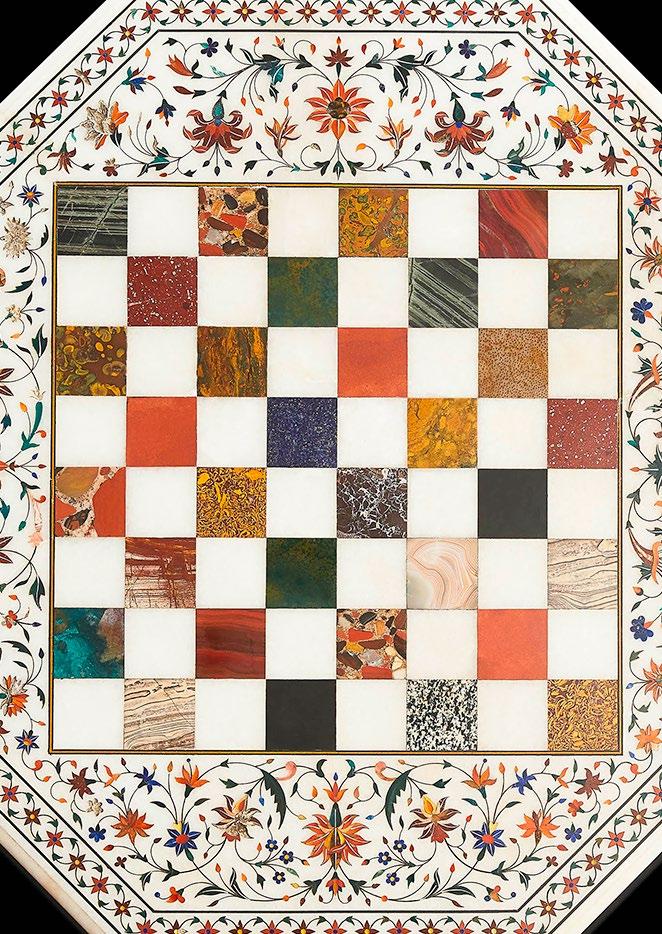

S ONGYE F IGURE
Figure Songye 19th century
Height: 24, 3 cm (on base)
Provenance:
American collection Price on request
O B j ECT P RESENTED BY: james Stephenson
M.: +1 646.644.7156
E: info@stephensonafricanart.com w.: www.stephensonafricanart.com VETTED BY:



B EMBE
F ETISH FIGURE
Figure Bembe
D.R. of the Congo
19th century
Height: 14,6 cm
Provenance: Alain Lecomte
Private collection
Price on request
O B j ECT P RESENTED BY: james Stephaenson
M.: +1 646.644.7156
E.: info@stephensonafricanart.com w.: www.stephensonafricanart.com
VETTED BY:
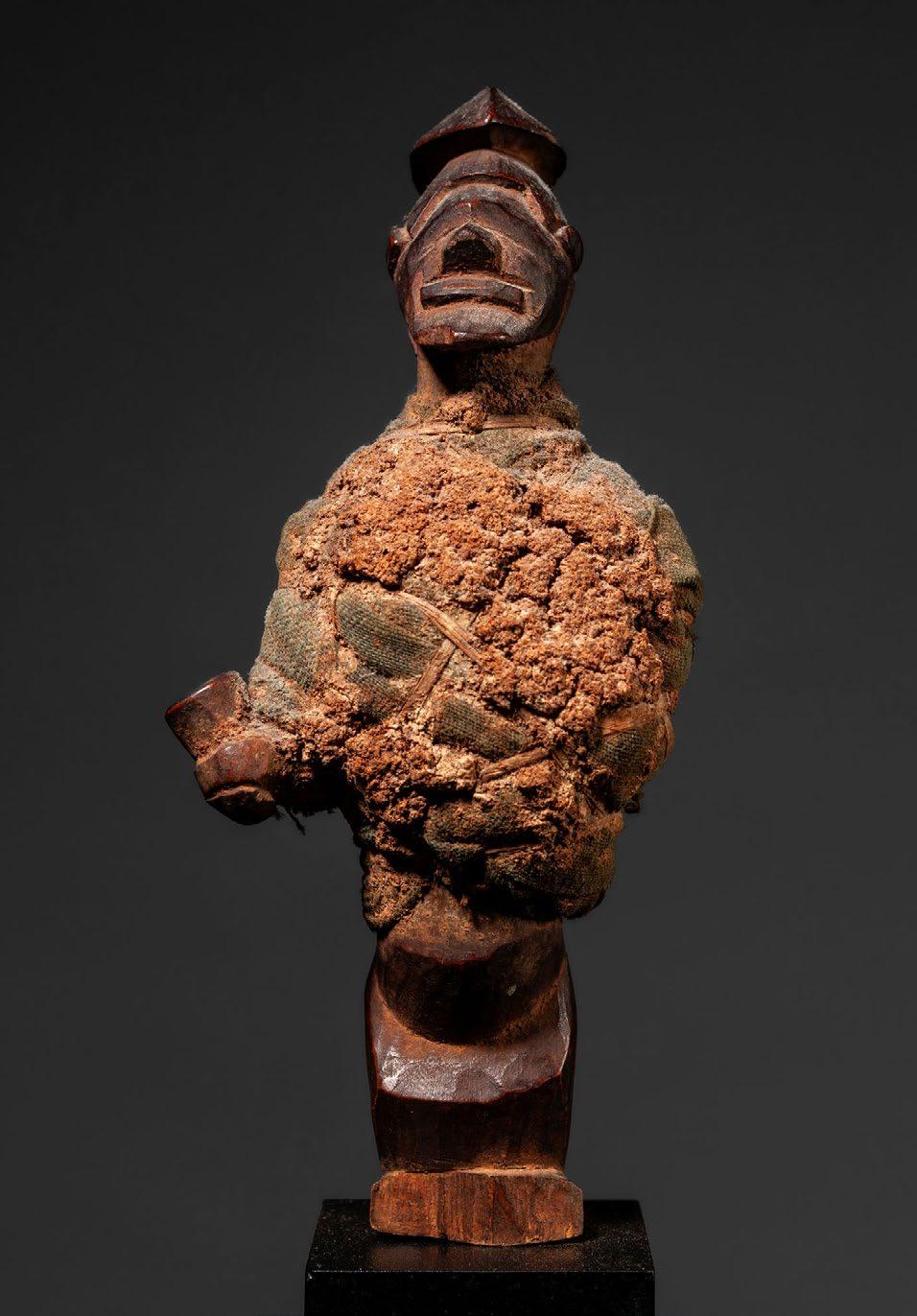

T.: +1 (646) 753-2819 E.: hedwardgallery@gmail.com w.: www.hedwardgallery.com VETTED BY:
Tsherin Sherpa's latest painting reflects his exploration and growth in his practice, embodying his cross-cultural experiences. The composition features a central purple-bodied Himalayan spirit against a gold leaf background, alluding to both sacredness and consumerism. while the head maintains traditional Himalayan style, the body demonstrates Sherpa's departure into more realistic figuration, vibrantly painted in purple. His diverse painting styles embody his embrace of various artistic inspirations. Sherpa skillfully integrates cultural references, combining traditional motifs with a disco pose hinting at pop culture, making the image relatable in a contemporary context. The foreground includes a subtly distorted figure, reminiscent of Sherpa's 'Protector Series', challenging tradition and prompting reflection on unexpected disruptions in life. This intentional abstraction encourages viewers, much like Sherpa's own journey, to embrace change and personal evolution across cultures.


Gourd
Zaramo kwere Tanzania
19th century
Provenance:
Carl and wilma Zabel
Exhibition:
Tenafly, Nj. USA ""The Discerning Eye:The collection of Carl and wilma Zabel."" The African Art Museum of the SMA fathers.june-25 Sep
Publication:
""The Discerning Eye African Art from the collection of Carl and wilma Zabel."" by Bordogna, Charles. Tenafly:The African Art Museum of the SMA fathers 2005, p 34
Price on request
O B j ECT P RESENTED BY: james Stephenson M.: +1 646.644.7156
E: info@stephensonafricanart.com w.: www.stephensonafricanart.com
VETTED BY:

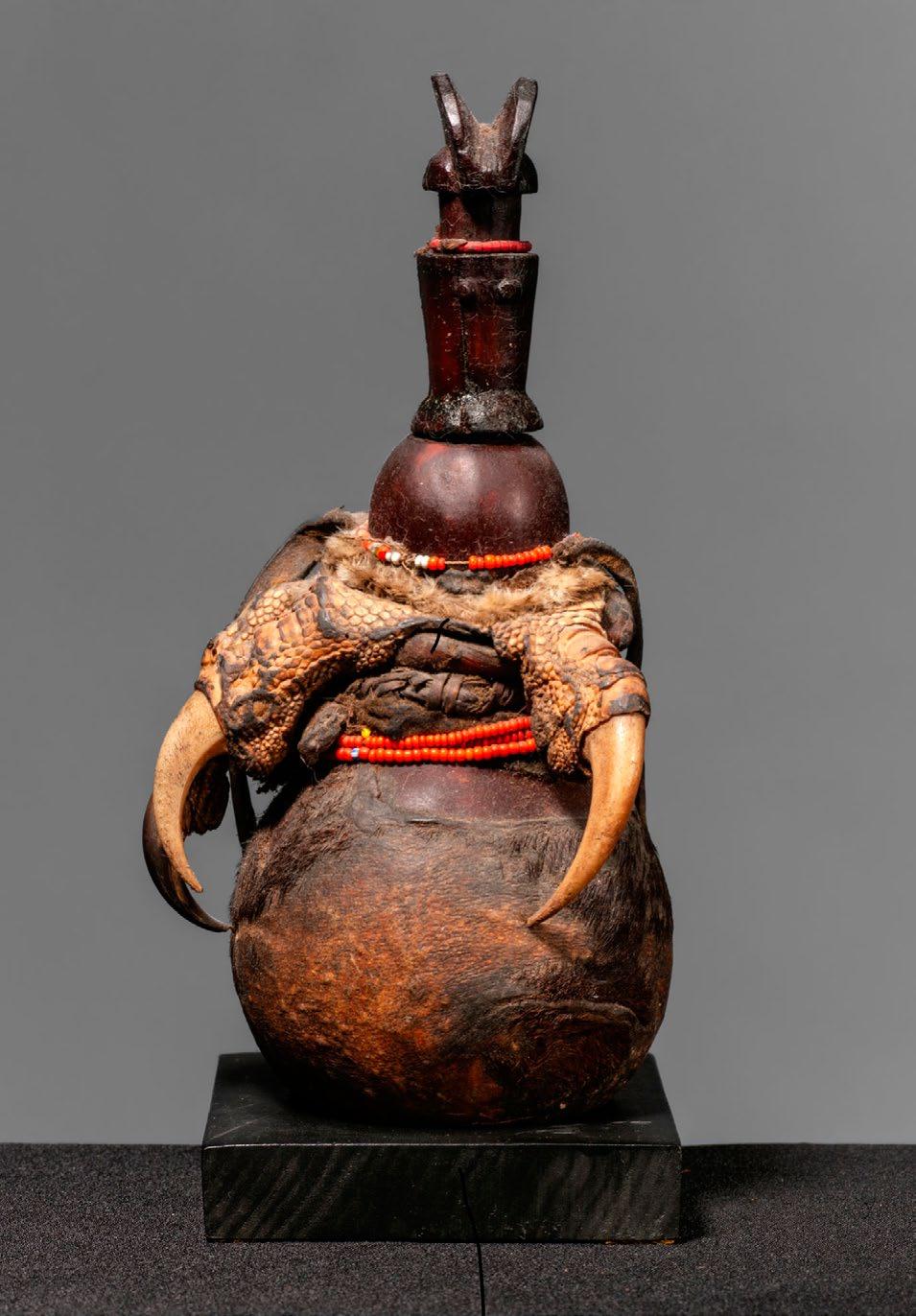
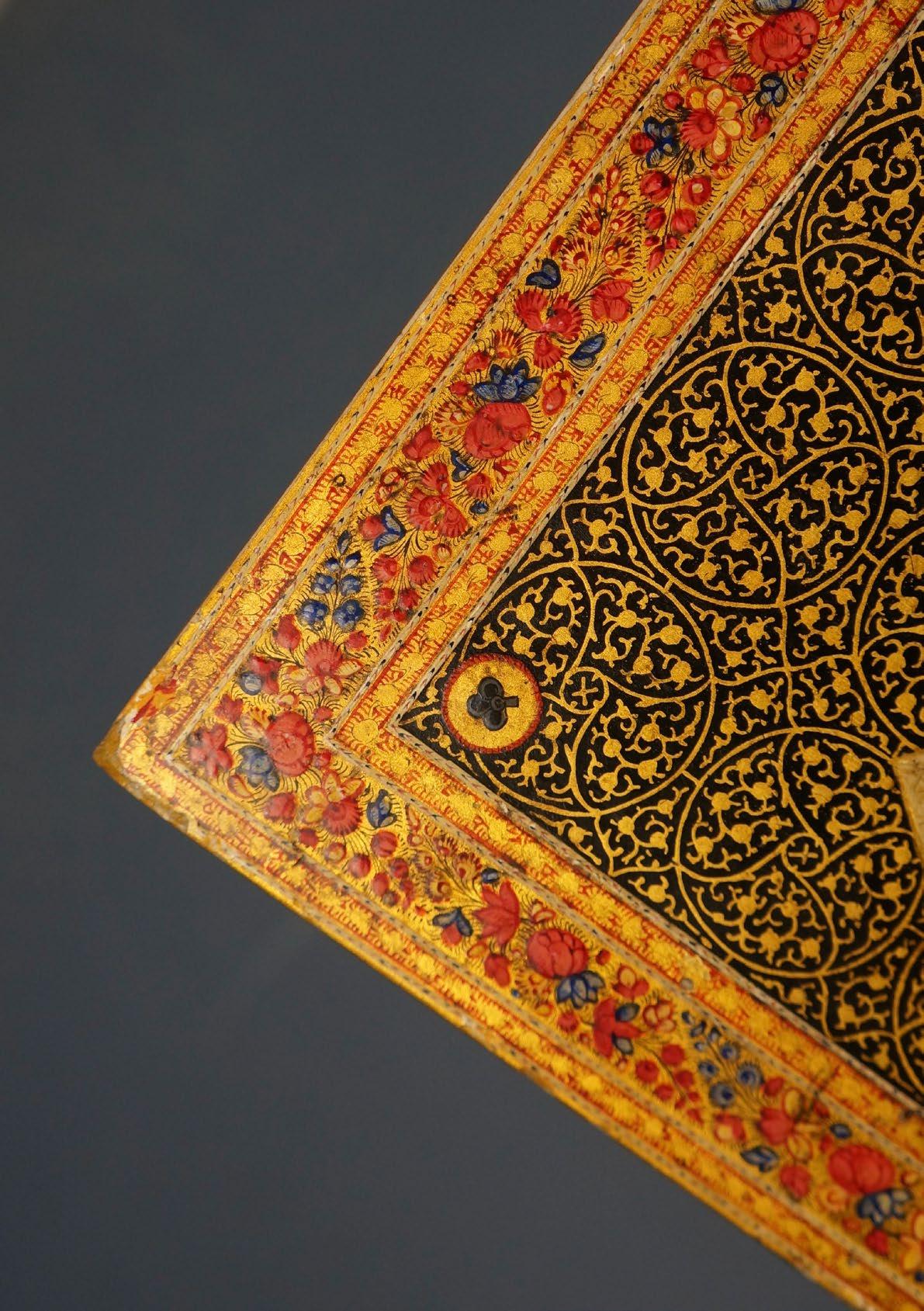
k ashmir 19th century Lacquered paper mache. Profuse handpainted gold decoration with intricate floral borders.
24 cm x 5 cm x 17 cm
Price: 350 euros
O B j ECT P RESENTED BY: Adam Prout
T.: + 44 7725 689 801 E.: adam@adamprout.com w.: www.adamprout.com
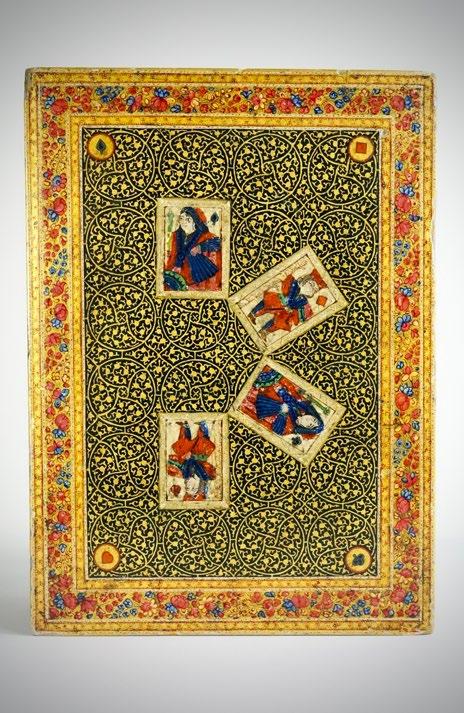
VETTED BY:
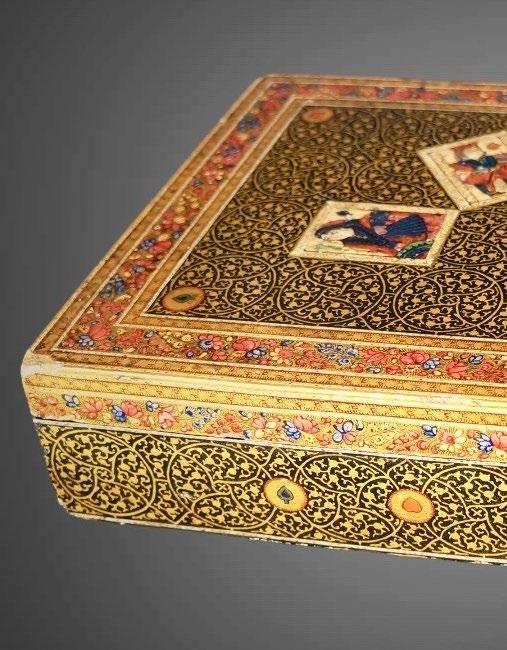

China
Qianlong period (1736-95)
Height: 4,5 cm
Provenance:
Private English collection Price on request
A three-colour Suzhou agate carving of a boy standing on a large gourd covered with a large leaf, a three legged toad perched on his shoulder, the figure holding long cords of cash and attached ruyi sceptre, the details in cash, toad’s eyes and ruyi head picked out in dark-brown and other details in caramel and grey.
O B j ECT P RESENTED BY:
Rasti Fine Art Ltd.
M.:+852 2415 1888
E.: gallery@rastifineart.com w.: www.rastifineart.com
VETTED BY:


China
1850-1947
Height (including original stopper in situ): 6,1 cm
Mouth/lip: 0,4/0,8 cm (square)
Gold with integral cork stopper and original spoon
Provenance:
ko collection
Hugh Moss (Hk ) Ltd, Hong kong 1998
Ruth and Carl Barron, Massachusetts, no. 2612
Christie’s, New York, 12 September 2018, lot 664
Hugh Moss (Hk ) Ltd.
Publication:
jICSBS, 23/1 (Spring 1991), cover jICSBS, Autumn 2007, p. 10, fig. 23/24
Price on request
ART w OR k P RESENTED BY: Pavilion, London
T.: +44 (0) 7523 018239
E.: info@paviliongallery.com w.: www.paviliongallery.com
VETTED BY:
Gold; with a flat lip, foot, and foot rim; chased in varied relief on both main sides with a four-clawed dragon emerging from clouds amidst flickering flames in pursuit of a flaming pearl, the narrow sides with confronting formalized lotus-petal designs framed with bands of parallel lines, the foot inscribed in regular script Qianlong nian zhi
(‘Made in the Qianlong era’), one outer edge of the foot inscribed with the maker’s metalsmith’s mark, ke Tian ji




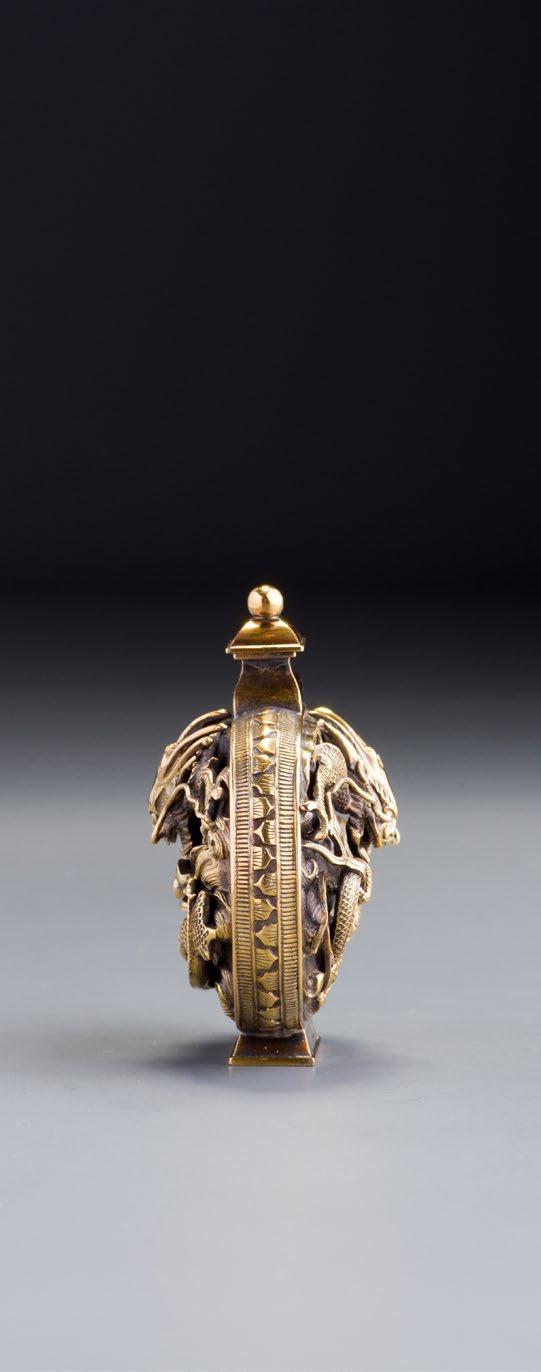

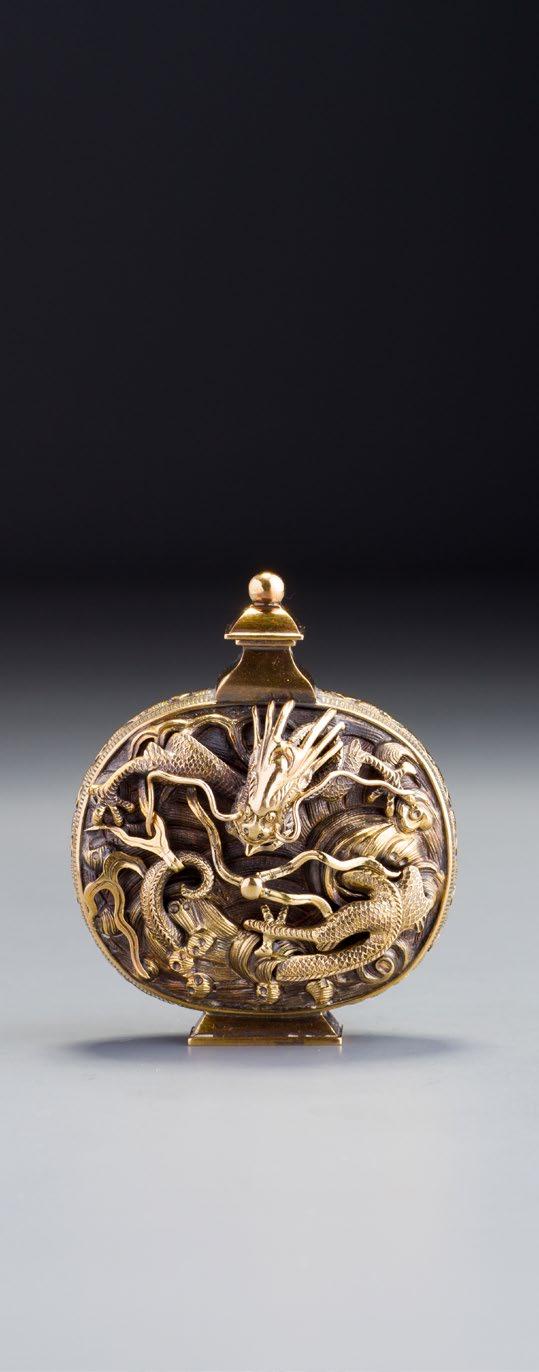
"Gold! Gold! Gold! Gold!
Bright and yellow, hard and cold
Molten, graven, hammered and rolled, Heavy to get and light to hold,
Hoarded, bartered, bought and sold,
Stolen, borrowed, squandered, doled, Spurned by young, but hung by old
To the verge of a church yard mold; Price of many a crime untold …" Thomas Hood
Staff with female figure
Senufo
Ivory Coast
First half of 20th century
Copper alloy, iron
Height: 74 cm
Provenance:
Mamadi Sono, Abidjan (late 1970’s)
Michael Oliver, New York
Price on request
O B j ECT P RESENTED BY: jacaranda Gallery +1 646 251 8528
dori@jacarandatribal.com www.jacarandatribal.com
Tumogani metal staffs appear during an elaborate Senufo ceremony called Nuyo’s which celebrates the climactic finale of the intermediate grade of the poro society. The central performers of this ceremony are the four Master Singers who wear a fiber masquerade, and each holds one of these metal staffs called tumogani (“spirit figures in brass”). These staffs help the Master Singers produce songs that are “clear as light”, lucid, and illuminating. The staffs also refer to land spirits that can be malevolent and dangerous when crossed but also a source of inspiration for creativity and innovation.
The figure surmounting the staff represents a young, strong, beautiful woman just like those depicted on the wooden champion cultivators’ staffs known as tefalipitya.
VETTED BY:


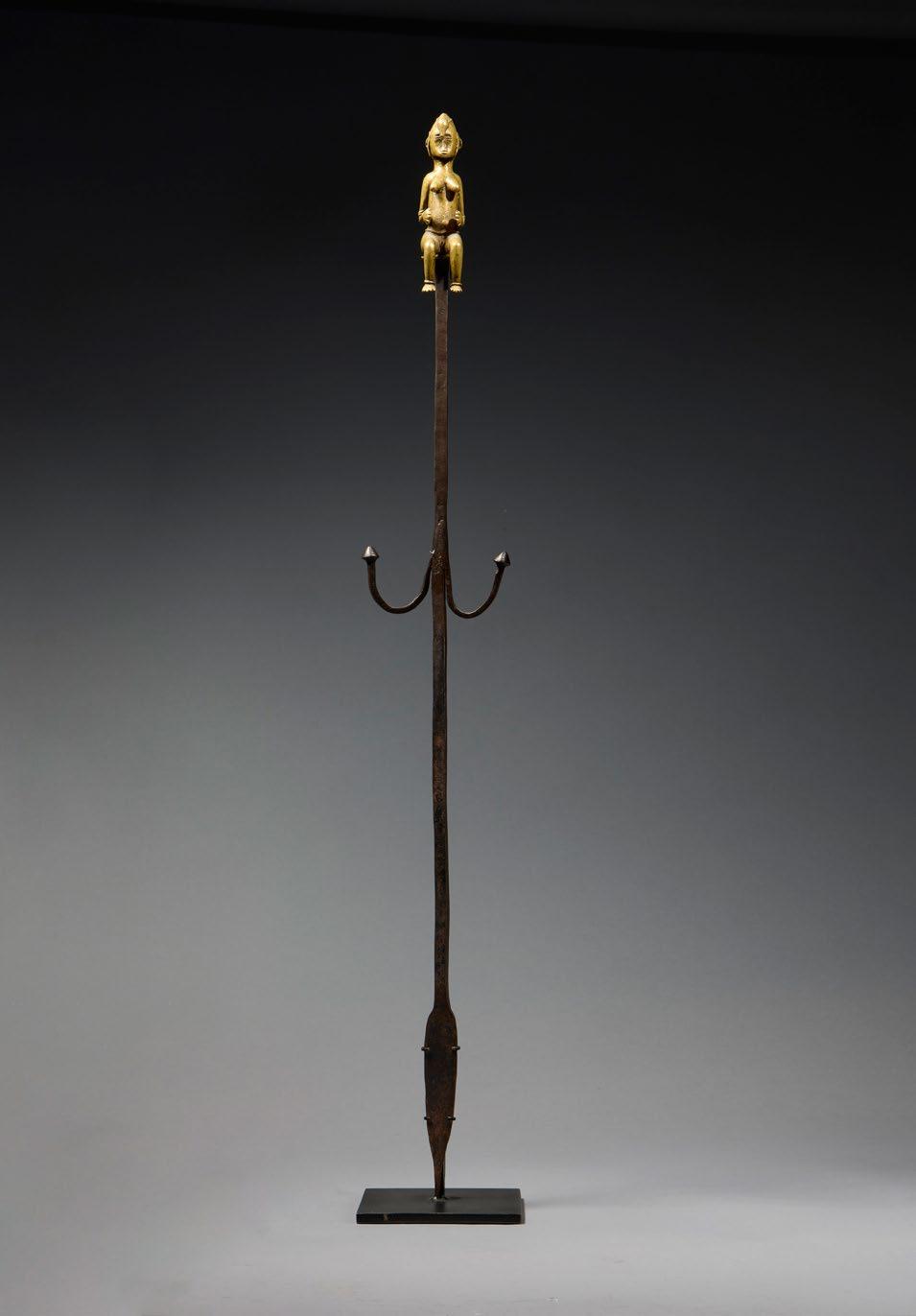
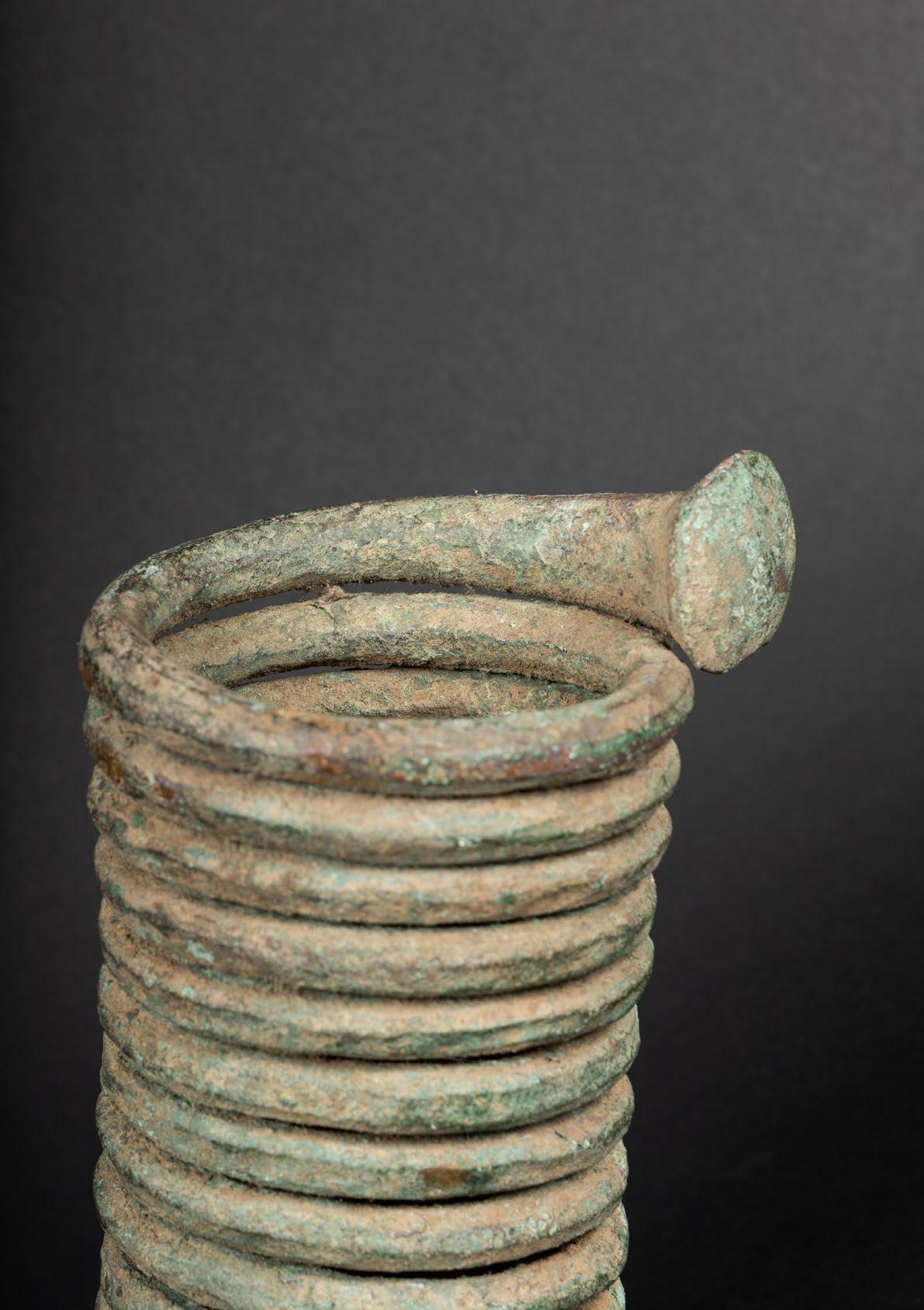
IGBO CURRENCY
Currency
Igbo
Nigeria
Early 20th century
Metal
Height: 22 cm
TAS exclusive price: 800 euros
O B j ECT P RESENTED BY:
julien Flak
M.: +33 6 84 52 81 36
E.: contact@galerieflak.com
w.: www.galerieflak.com
VETTED BY:
As noted by the Minneapolis Institute of Art, in the late 1400s, the Portuguese began trading with Igbo peoples in southeastern Nigeria—buying at first primarily ivory and pepper, and later also humans. The Portuguese bartered for goods with copper, which the Igbo accumulated and transformed over the centuries. The socalled bracelet currency seen here is a heritage of that tradition.
Some Igbo currencies have more or fewer coils, (sixteen coils here) varying the amount of metal and thus the currency’s value.

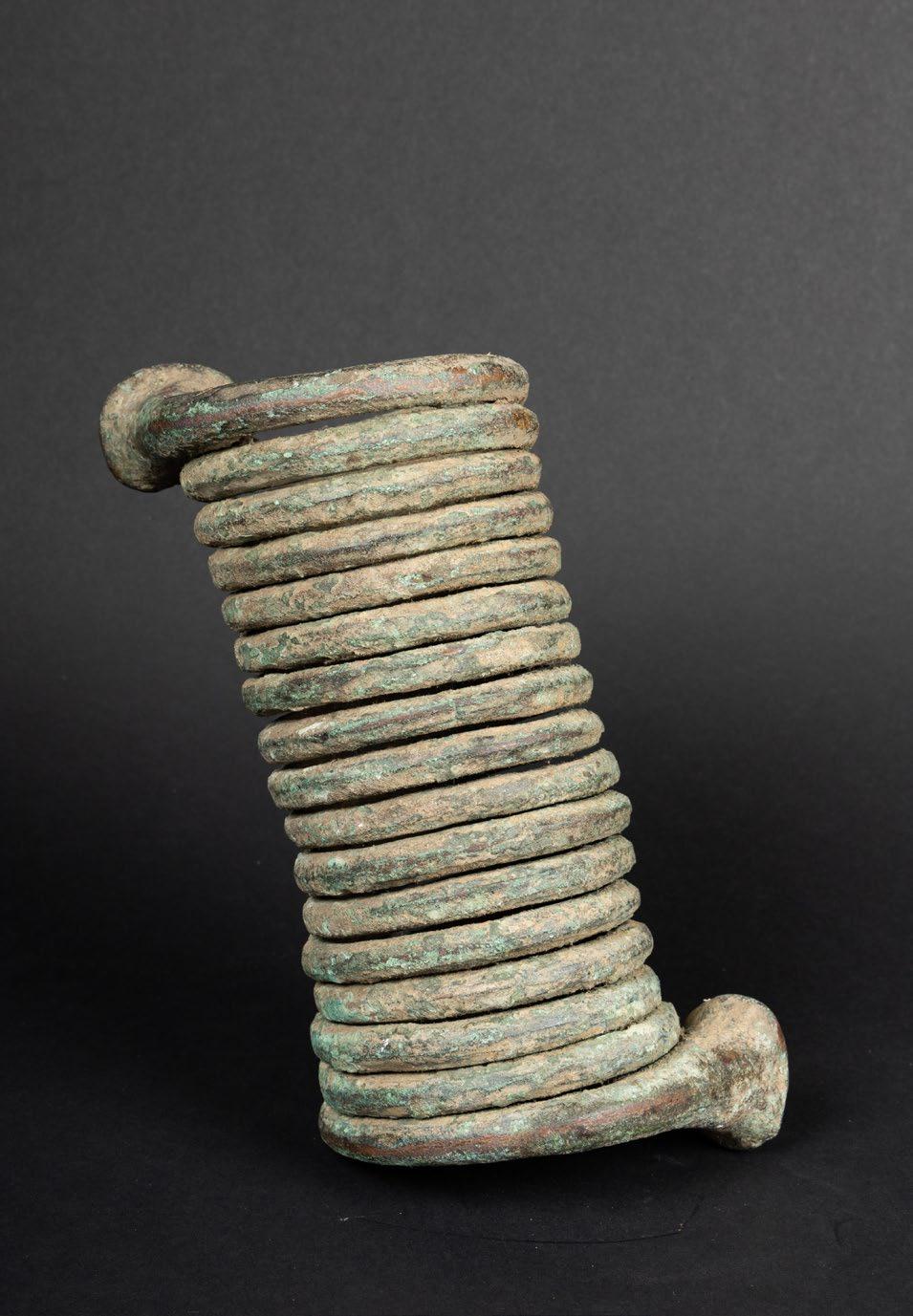
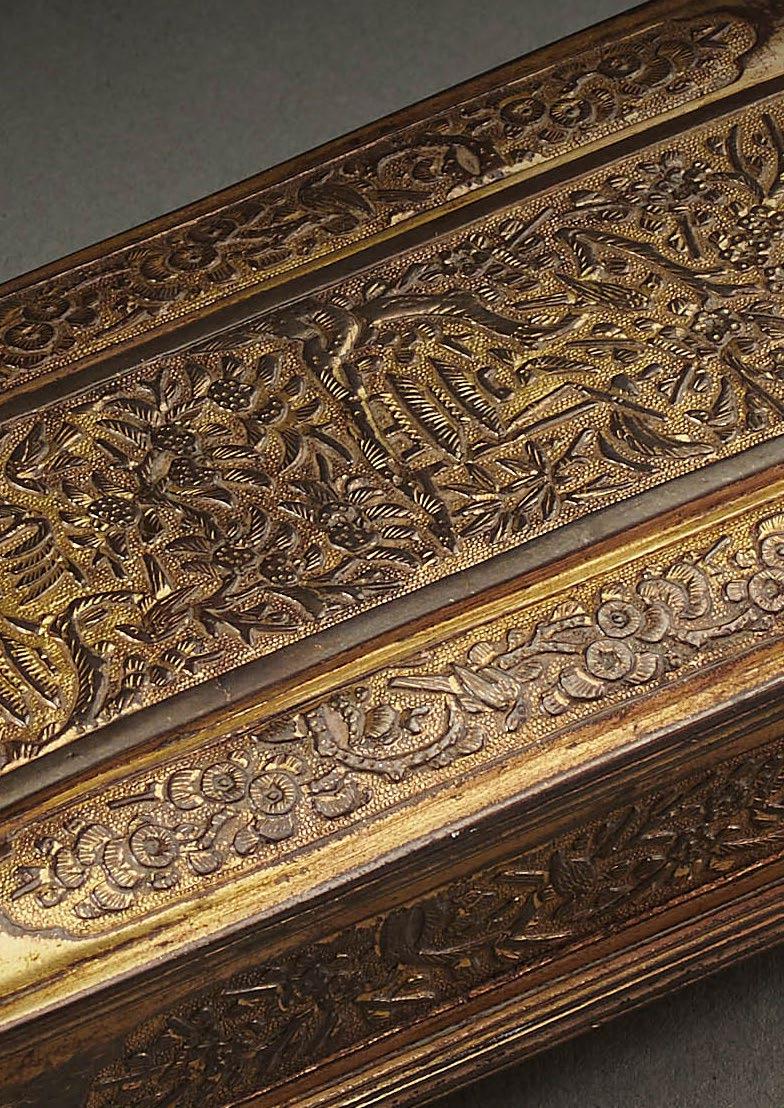
TOBACCO B OX
japan
18th century
13 cm x 6 cm x 3 cm
Price on request
O B j ECT P RESENTED BY:
Brandt Asian Art
M.: +44 (0)7774 989 661
E.: brandt@nildram.co.uk
w.: www.brandtasianart.com
A good gilt copper tobacco box. Lid, base and sides all decorated in relief within cartouches, with temples, garden scenes and finches among pine.
VETTED BY:


Pendant
Veraguas, Panama
800-1500 AD
Gold
Height: 6,6 cm
Length: 5 cm
weight: 74 gr
Provenance:
Galerie Le Corneur – Roudillon, Paris. 1962
jean Marie Talleux, Grand Fort Philippe. 1962
Publication:
Le Corneur Gallery – Roudillon, “Huetar-Brunka”. june 6/july 5, 1962
Price on request
O B j ECT P RESENTED BY:
Laurent Dodier
M.: + 33 6 08 22 68 15
E.: laurentdodier@wanadoo.fr w.: www.laurentdodier.com
VETTED BY:
Pendant representing a male deity. He has his arms outstretched and stands on two strong legs. He wears a large hairstyle, a reminder of which can be found, upside down, under her feet. This deity is masked with an eagle's head, the eagle being associated with the power of chiefs.
This pendant has a bail at the back allowing it to be suspended on the torso of dignitaries during ceremonies.
Export certificate for permanent cultural property no. 173561 of February 18, 2016.
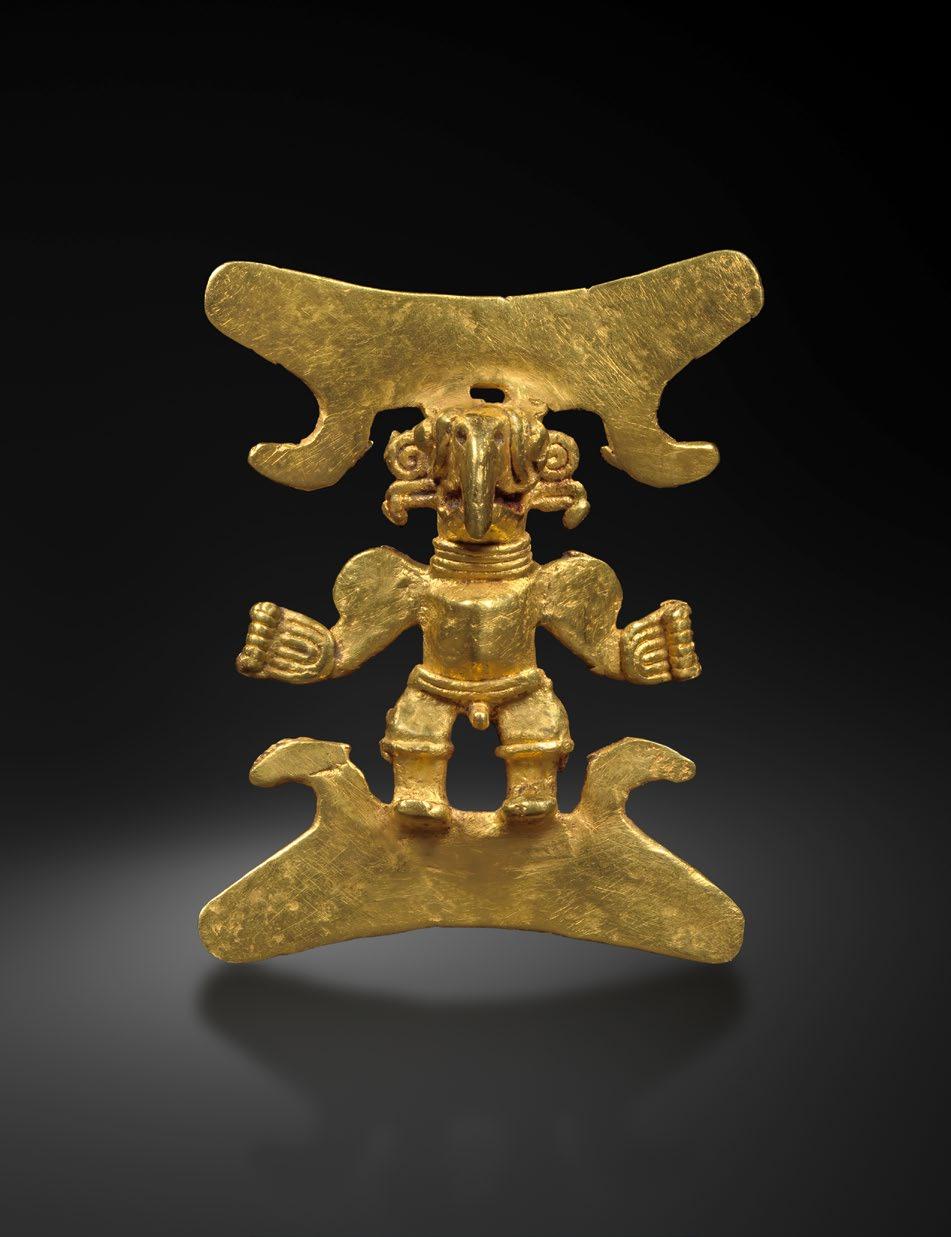

India, Deccan
Late 16th - Early 17th century
Cast and engraved brass
Height: 20 Diam.: 12 cm
Price: 15.000 euros
O B j ECT P RESENTED BY:
Alexis Renard
T.: +33 1 44 07 33 02
E: alexis@alexisrenard.com w.: www.alexisrenard.com
VETTED BY:
Pieces of this shape are very rare and almost always linked to figures of power; they are often depicted in miniatures from the Deccan region, offered as gifts to important figures. A good illustration of this kind of gift figures in the portrait of Sultan Ibrahim 'Adil Shah II painted by 'Ali Reza and now kept in the British Museum (1997,1108,0.1). In this miniature, however, the flared shape of the neck of the piece suggests it may have been a spittoon, unlike this one, more likely to have been used as a perfume burner. Only very few examples of incense burners of this type are known. One of them, of the same period and similar shape to this one, with the addition of spiraled gadroons, is kept in the collections of the Metropolitan Museum (2007.287).
This beautiful and elegantly shaped example is decorated with several registers of rings on the foot and collar, with delicately engraved lines. This piece is a very refined example of the simple yet beautiful design of Indian metalwork.
A perfume burner of this type is also seen in the hands of an attendant in a fine portrait of Ilkhas khan painted by Muhammad khan around 1650, which is now preserved in the Metropolitan Museum (see: Haidar N. N. and Sardar M. (2015), Sultans of Deccan India, 1500-1700: Opulence and Fantasy, New York: The Metropolitan Museum of Art, cat. 60, p. 141).

LOTUS P RIPIH NEC k LACE
Indonesia
Probably Central java 8 - 10th century
Hammered gold width: 50 cm weight: 13,50 g
Price: 22.000 euros
O B j ECT P RESENTED BY: Alexis Renard
T.: +33 1 44 07 33 02
E: alexis@alexisrenard.com w.: www.alexisrenard.com
VETTED BY:
This necklace of striking design is made of hammered gold and composed of circular crescent shaped elements. The central and largest element in the center is a stylized lotus pendant, finely decorated with punched dots.
A small group of related hammered gold pieces from the same region and period, formerly in the Samuel Eilenberg-jonathan P. Rosen Collection of Indonesian Gold, is kept in the collections of the Metropolitan Museum of Art in New York (1998.544.33a– d and 1998.544.40).
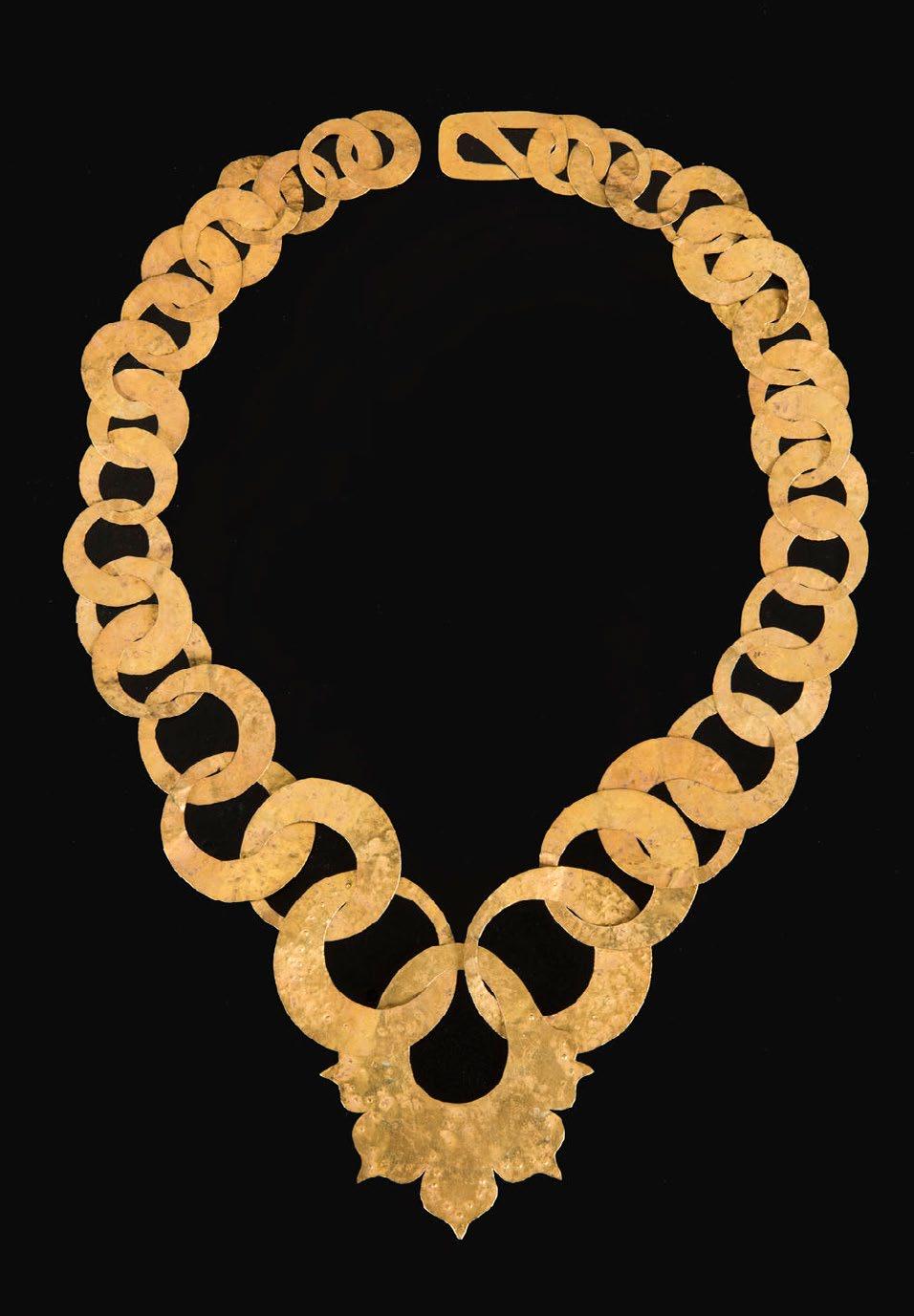
Baboon Skull
Akan
Ghana/Ivory Coast
Bronze width:: 2,2 cm
Length: 3,2 cm
Provenance:
Arnold Newman (1918-2006), photographer, New York.
Christie’s, Paris, Art Africain et Océanien, 7/12/2006, lot 184
Exhibition: “Animalerie”, Le Farinier –Abbaye de Cluny, May-june 2018.
Price on request
O B j ECT P RESENTED BY:
Anthony jP Meyer
M.: + 33 (0) 6 80 10 80 22
E.: ajpmeyer@gmail.com w.: www.meyeroceanic.art
Pendant representing a stylized baboon skull, or kontromfi.
Taking a step to the side away from his normal areas of expertise which are the Oceanic and Arctic cultures, Anthony jP Meyer has decided to unveil his collection of 99 bronze miniatures from Africa. Produced by the lost-wax casting process, these ancient pieces take us on a journey into the multiple cultures and religious beliefs of Africa with statues representing anthropomorphic and zoomorphic figures, deities, musicians, couples, crocodiles, birds, as well as tools and jewelry. This exhibition offers a great opportunity to discover the art and spirituality of bronze work through these remarkable monumental miniatures. Each piece tells a story, evoking the customs, beliefs and traditions of the rich and fascinating cultures of Africa.
Discover the exhibition catalogue here : https://issuu.com/ajpmeyer/docs/catalogue_bronze99_eng_final
VETTED BY:
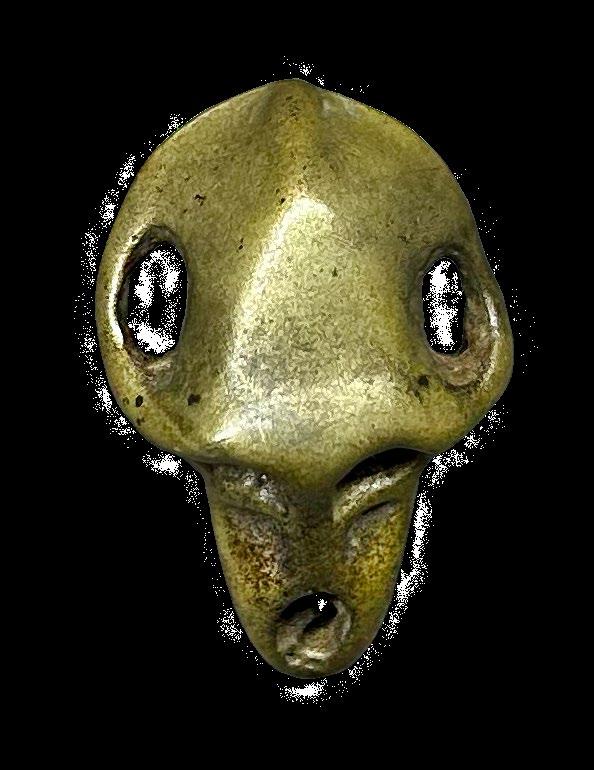

Figure of a woman holding a severed head
Akan
Ivory Coast/Ghana
Bronze
6,8 cm (h); 3,5 cm (w); 4,5 cm (D.)
Provenance:
Charles Ratton (1895-1986)
Galerie Ratton/Ladrière (19842023)
Charles Ratton auction sale, 14 rue de Marignan, Paris, Friday 15 September 2023, Salle 9, Hôtel
Drouot, lot 99
Price on request
O B j ECT P RESENTED BY:
Anthony jP Meyer
M.: + 33 (0) 6 80 10 80 22 E.: ajpmeyer@gmail.com w.: www.meyeroceanic.art
Handwritten description by Charles Ratton in his notebook entitled “Catalogue des Poids Achanti et Baoulé”: “Standing woman, presenting, at eye level, a severed head which she is holding by the hair.”
It is likely that this astonishing figure of a woman displaying a severed head refers more to a historical fact rather than a proverb. The bearded head is thought to be that of an enemy or a person killed as a sacrifice.
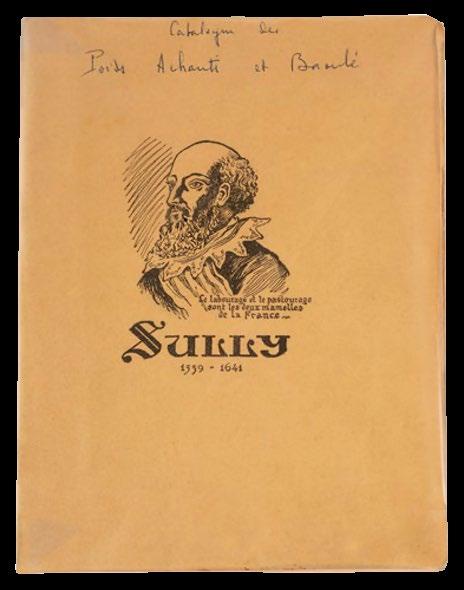
VETTED BY:
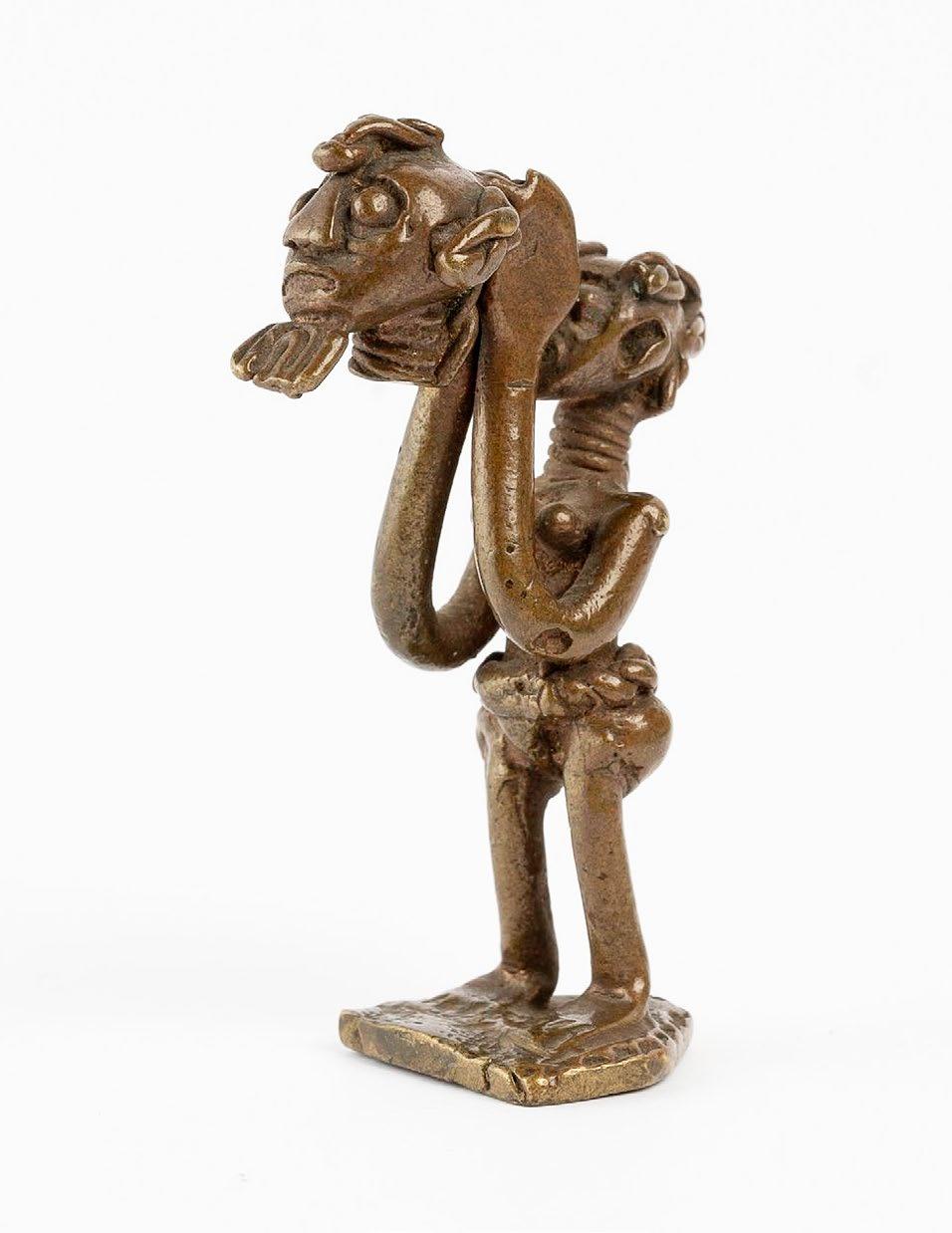

Taking a step to the side away from his normal areas of expertise which are the Oceanic and Arctic cultures, Anthony jP Meyer has decided to unveil his collection of 99 bronze miniatures from Africa. Produced by the lost-wax casting process, these ancient pieces take us on a journey into the multiple cultures and religious beliefs of Africa with statues representing anthropomorphic and zoomorphic figures, deities, musicians, couples, crocodiles, birds, as well as tools and jewelry. This exhibition offers a great opportunity to discover the art and spirituality of bronze work through these remarkable monumental miniatures. Each piece tells a story, evoking the customs, beliefs and traditions of the rich and fascinating cultures of Africa.
Discover the exhibition catalogue here :
https://issuu.com/ajpmeyer/docs/catalogue_bronze99_eng_final
Gold weights
Akan west Africa
20th century or earlier
Cast brass
From 2,9 cm to 9 cm
TAS exclusive price: 1.000 euros for the group
Gold was a key element of the social and political life in the Akan kingdoms and more broadly in west Africa. This currency was essential to the trade around which all the Akan economic life revolved. In precolonial times, gold dust (gold nuggets or fine grains of gold) was the primary form of currency in the region hence the importance of a precise system of measure. By the 17 th century, an elaborate system was put in place, using cast brass weights along with a balance scale and spoon. Many gold-weights, especially those representing animals, objects and people, were associated with aphorisms or proverbs.
Herbert M. Cole and Doran H. Ross, ( The Arts of Ghana, Museum of Cultural History, University of California, 1977, page 80) noted that « all buying and selling activities in Ghana and more widely in west Africa, involve numerous greetings, social banter, haggling and sometimes a playful, indirect sort of discourse in which gold-weights and their associated proverbs may in the past have had a place ».
O B j ECT P RESENTED BY: julien Flak
M.: +33 6 84 52 81 36 E.: contact@galerieflak.com w.: www.galerieflak.com
VETTED BY:

Pendant with human head
Akan
Ivory Coast
First half of the 20th century Gold
Diameter: 6,33 cm
Provenance: Roger Bédiat (1897-1958), Ivory Coast
Noir d'ivoire (Yasmina Chenoufi), Paris (2016)
Publication:
Expo cat.: "" west African Gold Ornaments"", Barcelona: Galeria
David Serra - Fine Tribal Art, 2022:81
Price on request
ART w OR k P RESENTED BY: jacaranda Gallery +1 646 251 8528 dori@jacarandatribal.com www.jacarandatribal.com
VETTED BY:
For most Akan, gold is not just wealth. Gold is imbued with enormous spiritual value, especially within the ranks of leadership. Thus, while the economic function of gold among the Akan has diminished with its demonetization by the British colonial administration in the nineteenth century, gold has retained its fundamental significance in political regalia. Using modest technology–lost-wax casting and smithing–Akan craftspeople have fashioned intriguing and exquisite forms. The use of gold in leadership regalia is rooted in tradition, belief, and intrinsic worth, as is the use of its inferior relatives, silver and brass. It is therefore possible to differentiate among leaders–priests, political functionaries, lowly-ranked and paramount chiefs–simply based on the principal medium of the accoutrements.
Among the diverse kinds of gold jewelry featured in Akan chiefly dress are pendants of different sizes and shapes, including human, animal, and abstract designs. Today these objects, cast by the lost-wax technique, are no longer a royal prerogative. They have been documented in the ornamentation of young women undergoing puberty rites and in the possession of persons of wealth and high status. Their current broad geographical distribution also suggests the influence of twentieth century globalism. Indeed, gold pendants are no longer being manufactured exclusively for use in Africa but are made for sale in tourist shops and galleries, and for export. The motif depicted here is a traditional Akan icon of power.
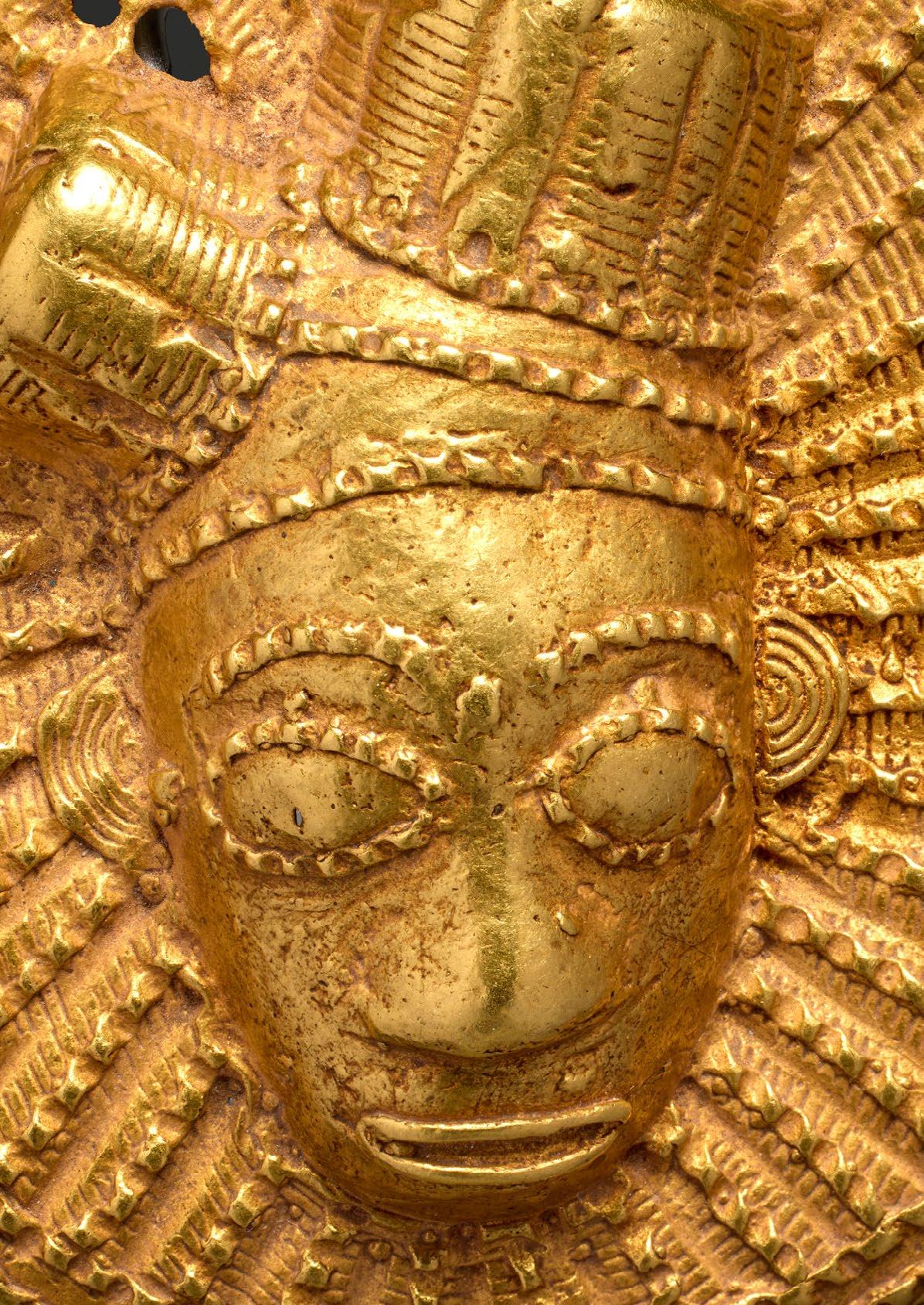

jambi Region, Sumatra, Indonesia
19th century
21 cm x 24,5 cm
weight: 130 gr
Price on request
O B j ECT P RESENTED BY: Sue Ollemans
M.: + 44 (0) 7775 566 356 E.: sue@ollemans.com w.: www.ollemans.com
VETTED BY:

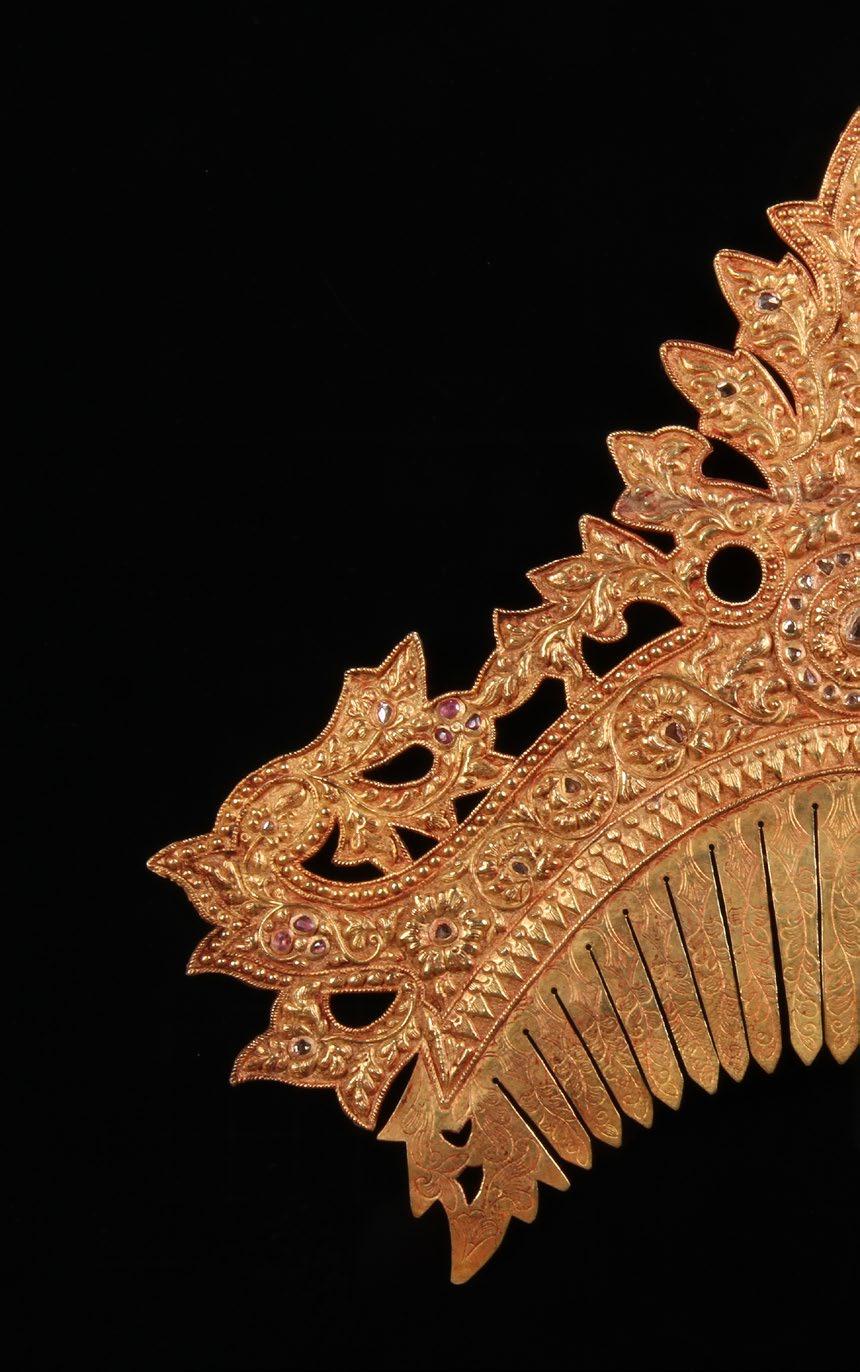
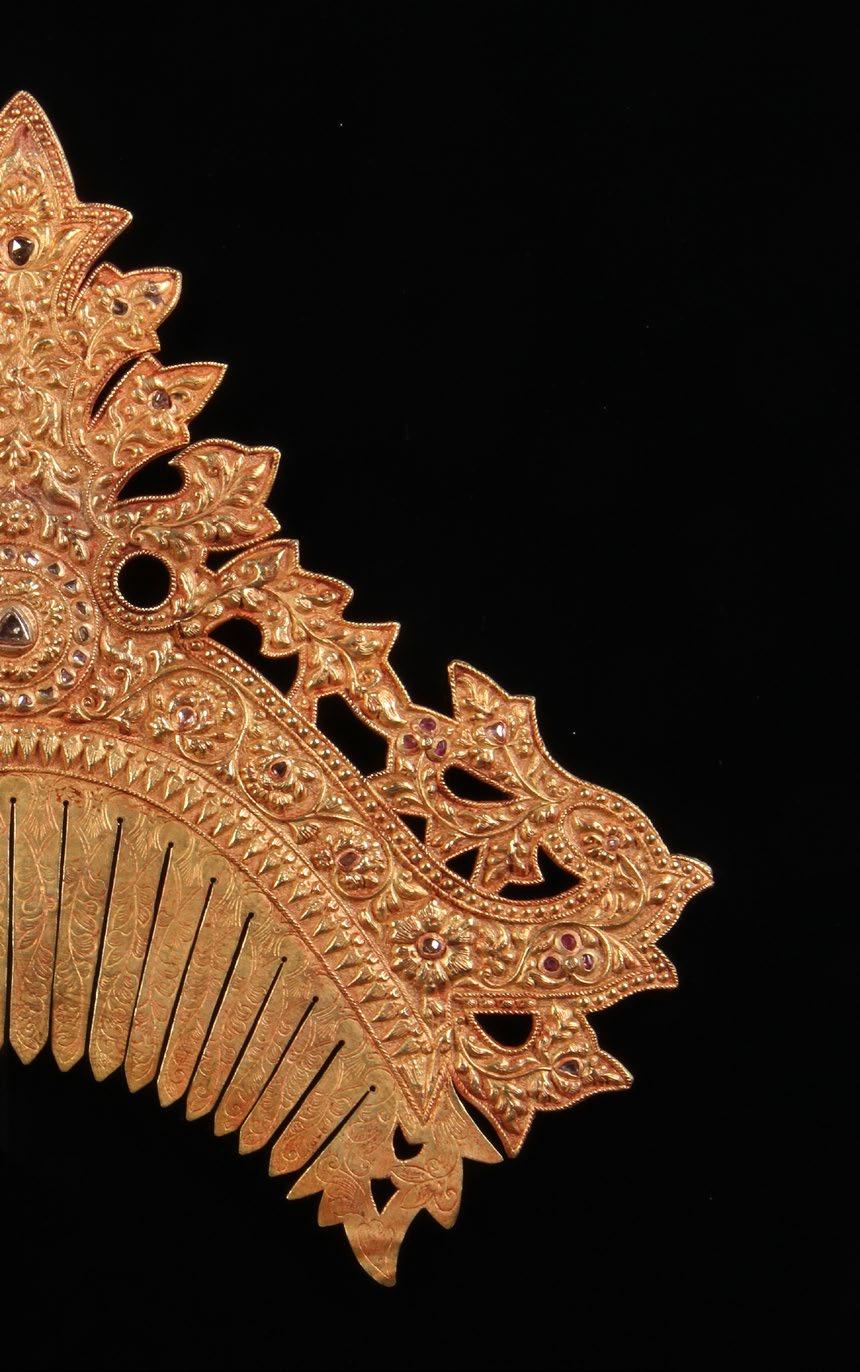
Royal Bracelet with Swirling Motifs
Ashanti/asante
Ghana
First half of 20th century
Gold
Diameter: 11 cm
Provenance:
Constance McCormick Fearing (1926–2019), California
Price on request
O B j ECT P RESENTED BY: jacaranda Gallery +1 646 251 8528
dori@jacarandatribal.com www.jacarandatribal.com
VETTED BY:
For most Akan, gold is not just wealth. Gold is imbued with enormous spiritual value, especially within the ranks of leadership. Thus, while the economic function of gold among the Akan has diminished with its demonetization by the British colonial administration in the nineteenth century, gold has retained its fundamental significance in political regalia. Using modest technology–lost-wax casting and smithing–Akan craftspeople have fashioned intriguing and exquisite forms. The use of gold in leadership regalia is rooted in tradition, belief, and intrinsic worth, as is the use of its inferior relatives, silver and brass. It is therefore possible to differentiate among leaders–priests, political functionaries, lowly-ranked and paramount chiefs–simply based on the principal medium of the accoutrements.
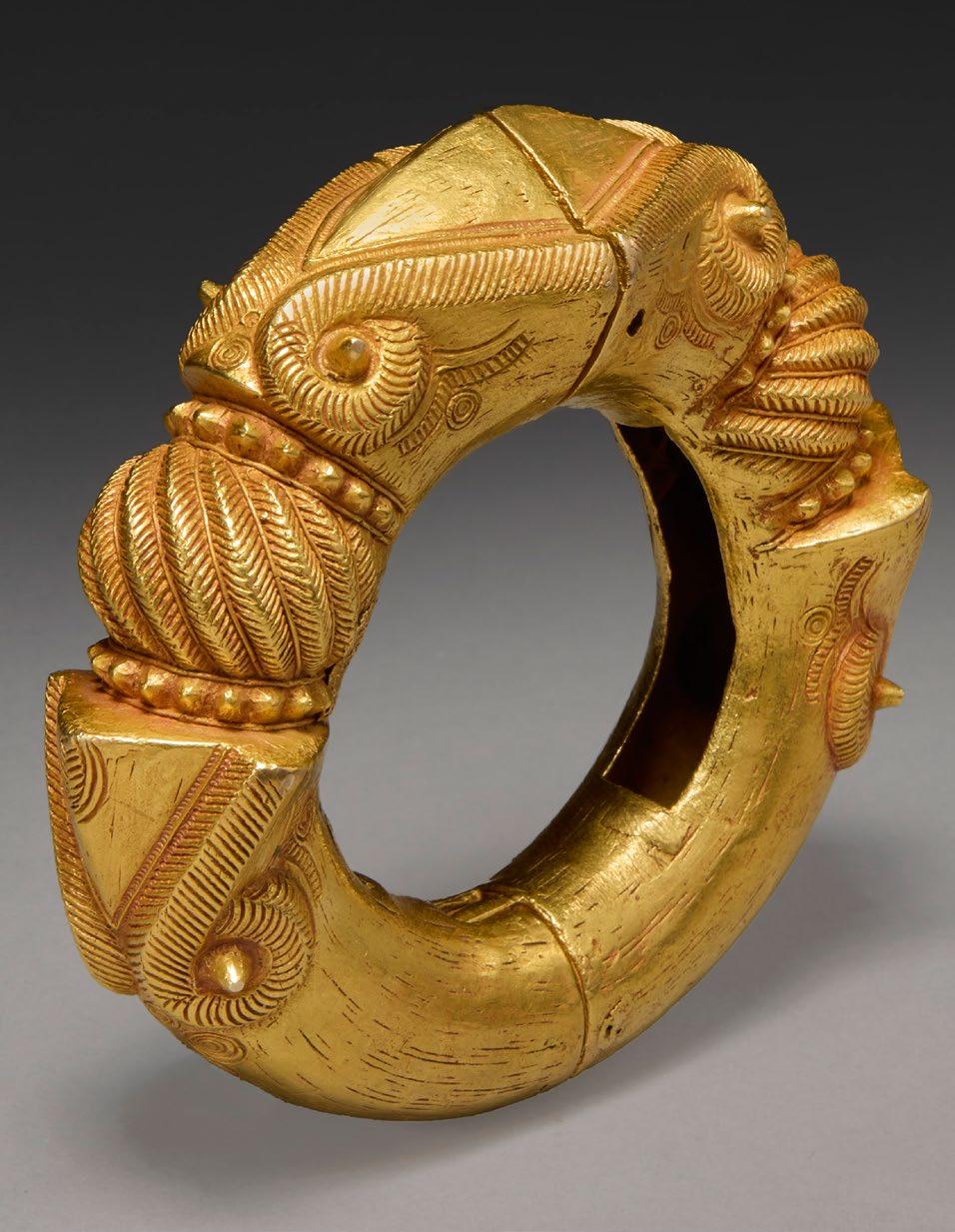

Double Mask
Baule
Ivory Coast Bronze.
Height: 6,2 cm width: 5,2 cm
Provenance:
Paul & Maria wyss, Basel.
Galerie Patrik Fröhlich, Zurich.
Publication:
Fischer, E. & Himmelheber, H.: Das Gold In Der kunst westafrikas. Museum Rietberg, Zurich, 1975, fig. 112, p. 66. Price on request
Superb double mask, possibly representing twins.
Taking a step to the side away from his normal areas of expertise which are the Oceanic and Arctic cultures, Anthony jP Meyer has decided to unveil his collection of 99 bronze miniatures from Africa. Produced by the lost-wax casting process, these ancient pieces take us on a journey into the multiple cultures and religious beliefs of Africa with statues representing anthropomorphic and zoomorphic figures, deities, musicians, couples, crocodiles, birds, as well as tools and jewelry. This exhibition offers a great opportunity to discover the art and spirituality of bronze work through these remarkable monumental miniatures. Each piece tells a story, evoking the customs, beliefs and traditions of the rich and fascinating cultures of Africa.
Discover the exhibition catalogue here : https://issuu.com/ajpmeyer/docs/catalogue_bronze99_eng_final
O B j ECT P RESENTED BY:
Anthony jP Meyer
M.: + 33 (0) 6 80 10 80 22 E.: ajpmeyer@gmail.com w.: www.meyeroceanic.art
VETTED BY:
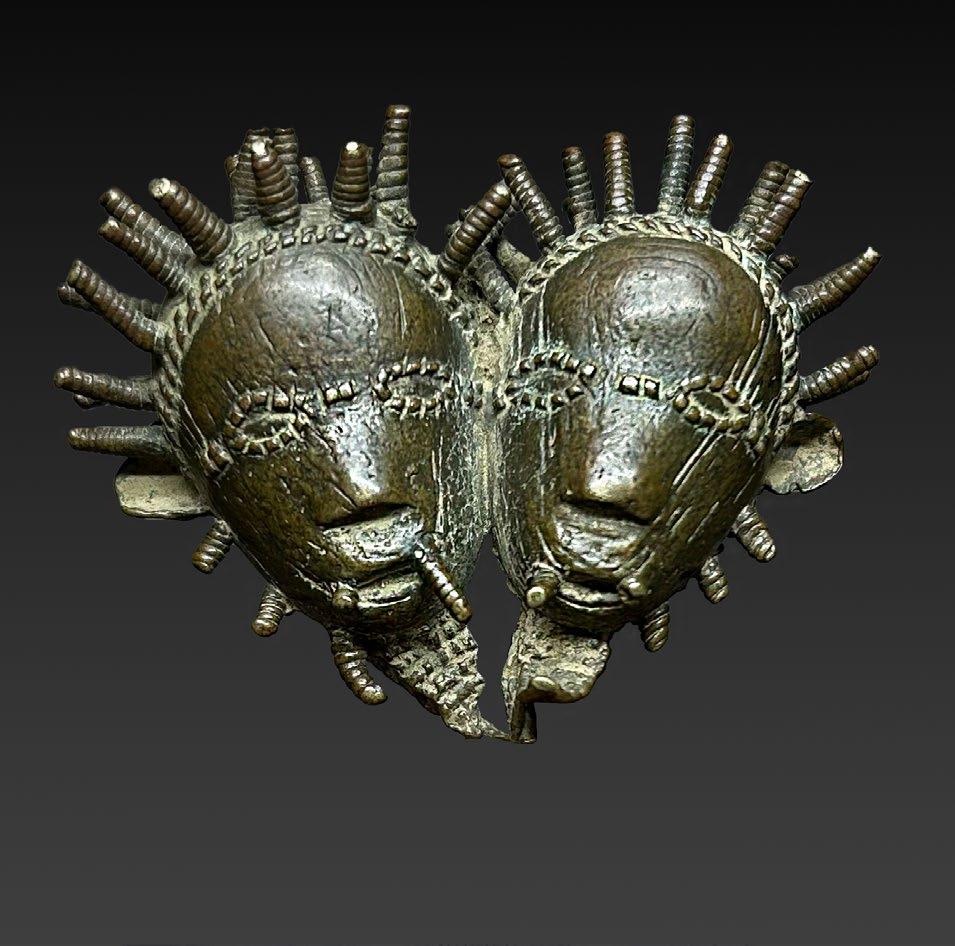

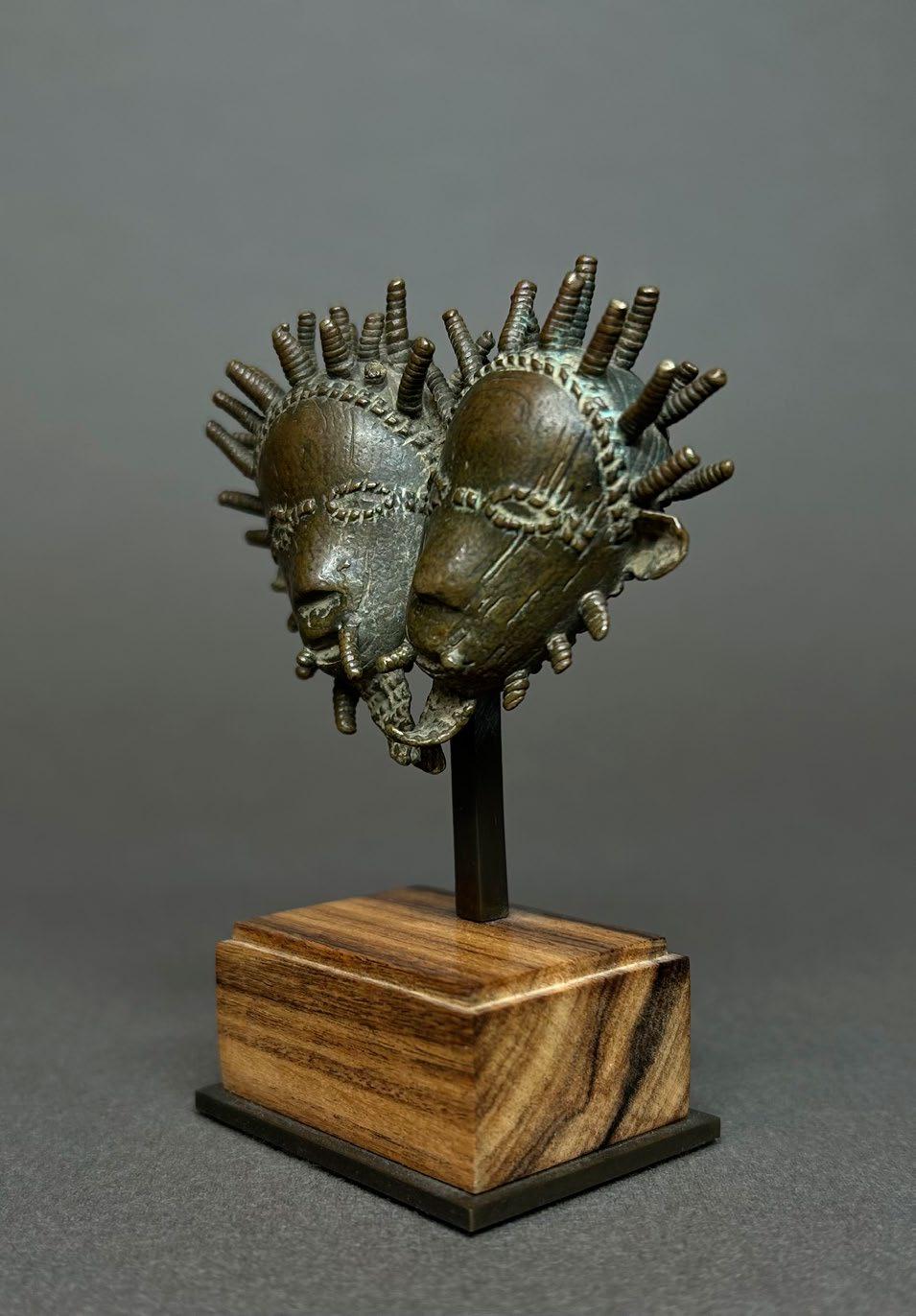
Ornament Baule
Ivory Coast Gold (16/18k )
Height: 10,2 cm
weight 48,6 gr
Provenance:
G.F. Scanzi (1936-2017), Italy
Price: 8.000 euros
ART w OR k P RESENTED BY: David Serra
T.: +34 (0) 667525597
E.: galeria@davidserra.es w.: www.davidserra.es
VETTED BY:

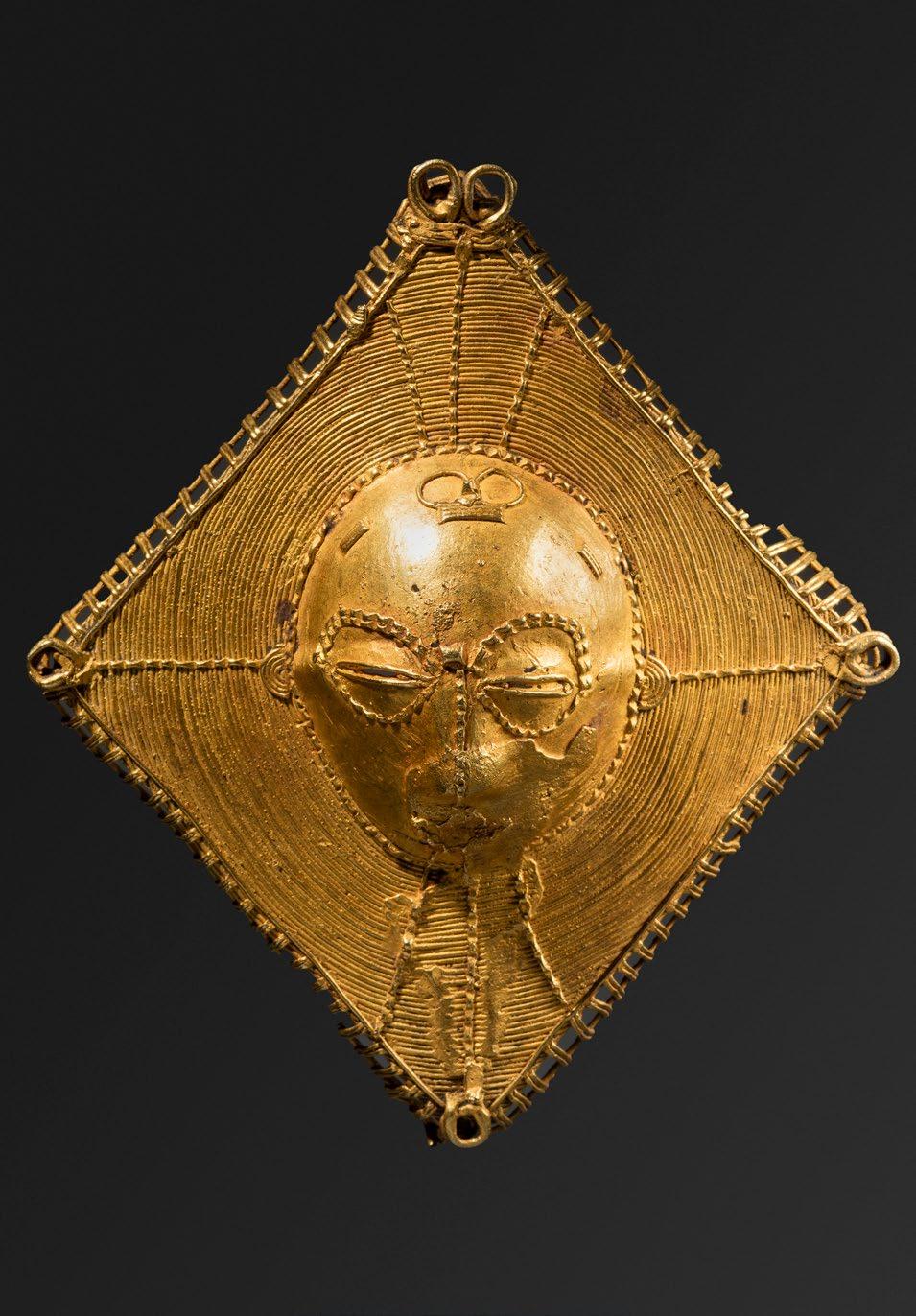
B IRGUI
Lip ornament
Surma
Ethiopia wood Height: 10,5 cm wide 15,5 cm
Provenance: javier Lentini, Spain
Price: 1.500 euros
O B j ECT P RESENTED BY: David Serra
T.: +34 (0) 667525597
E.: galeria@davidserra.es w.: www.davidserra.es
VETTED BY:
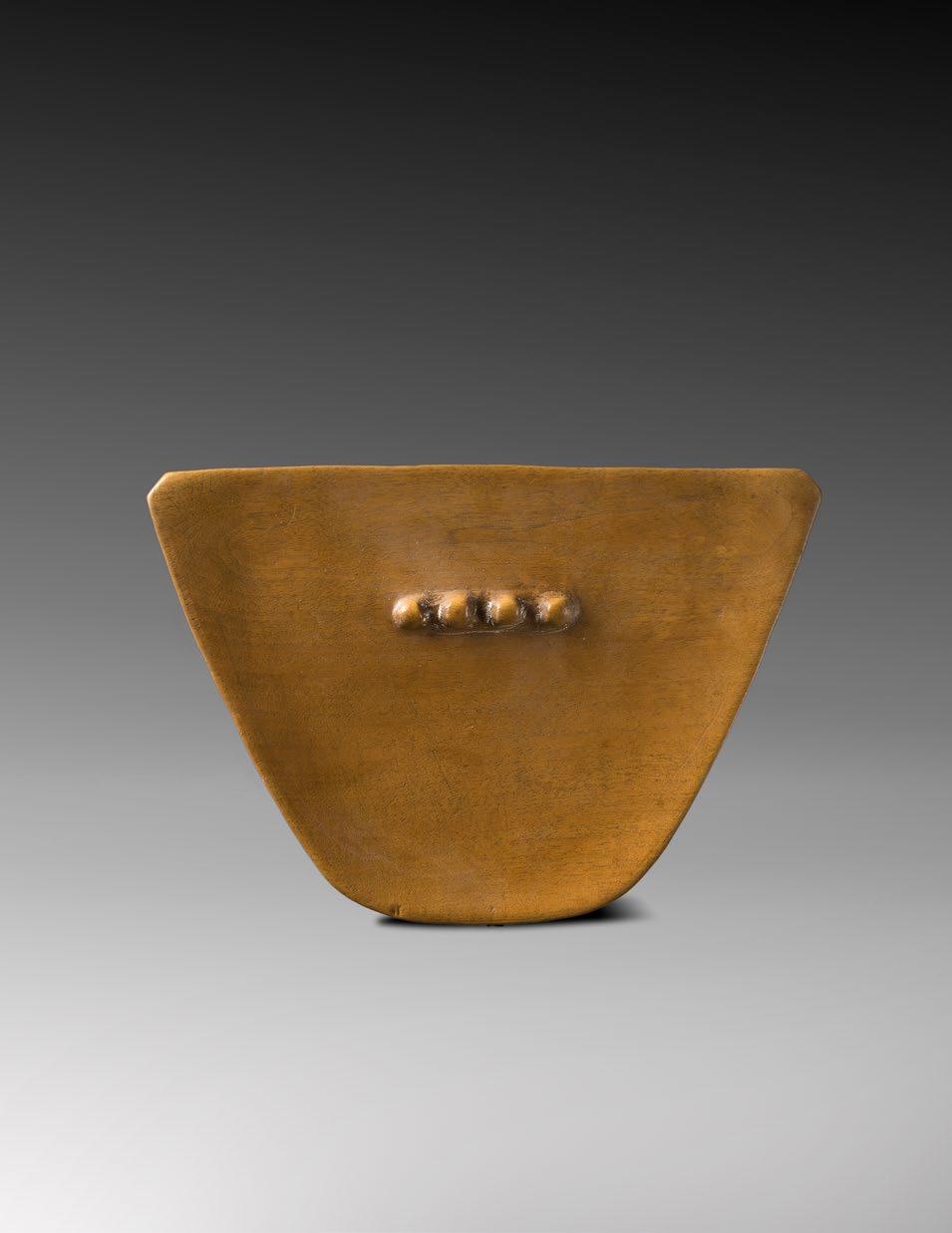
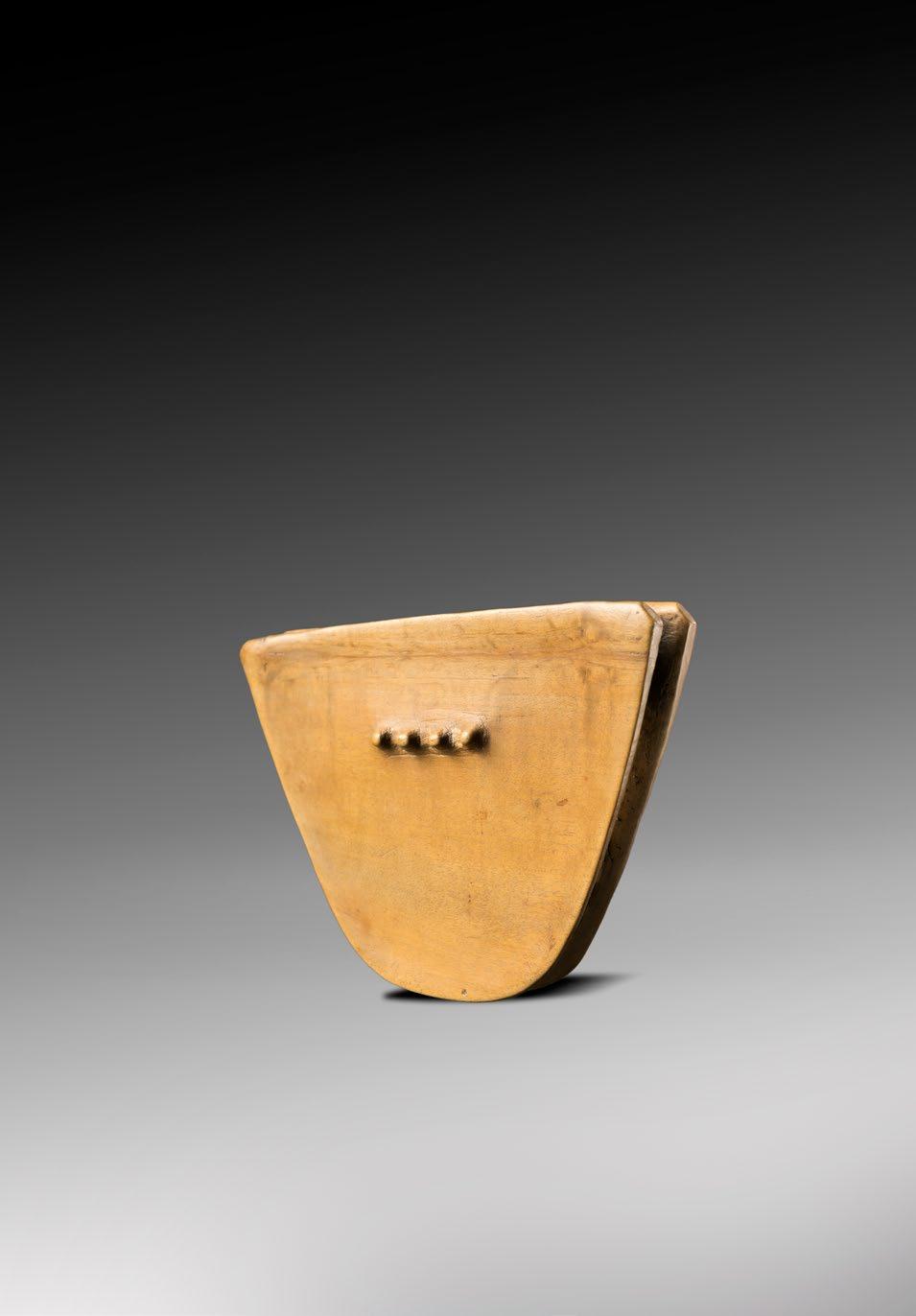
"Golden slumbers kiss your eyes, Smiles awake you when you rise; Sleep, pretty wantons, do not cry, And I will sing a lullaby, Rock them, rock them, lullaby …"
The Beatles
I LLUSTRATION TO A R AGAMALA S ERIES: kA k UBHA R AGINI
jaipur, India
Circa 1800
Opaque watercolor heightened with gold on paper 17 cm x 11 cm
Inscribed: Five lines of Sanksrit in black ink on a bold yellow margin
Provenance:
Private French collection Price on request
O B j ECT P RESENTED BY:
k apoor Galleries
M.: + 1 (212) 794-2300 E.: info@kapoors.com w.: www.kapoors.com
Standing before a carefully maintained garden, the beautiful maiden is shown absentmindedly feeding two peacocks within palace grounds. She looks over her right shoulder and holds a garland of white flowers in her left hand. Her bright yellow ghagra (skirt) and short sleeved choli draws attention to her figure which is finely decorated with a repeated pattern of brilliant gold. Her toes and fingers are tipped in red, with an ombré fade below her bare feet shifting from green to a light blue that is repeated in her halo. The necklaces of jewels and pearls that adorn her neck and fall between her breasts are complemented by her bold earrings and nose ring.
A peahen stands in front of her on the right hand side, while a peacock stands a little way behind to the left, as food falls gracefully from her palm, almost like a stream of pearls. This painting employs various stylistic features that help to identify the work as a later execution in the cannon of Indian miniature paintings. The depth illustrated within this image took multiple centuries to master–the diagonal pathways that appear between garden beds help to shape the composition behind the maiden in order to highlight both her, and the foreground scene, while also directing the eye to the grand architecture rising in the background with its lush garden of flowers.
On the subject of the kakubha Ragini, Dr.
VETTED BY:

Pal writes ""kakubha is a beautiful young woman, suffering lovesickness, leaving her fine palace she enters the forest... Again and again she arouses the peacock's scream, forgetting soul and body in a trance upon her lord.""
For other works on this very subject, see: The Museum of Fine Arts, Boston, acc no. 17.2910, The Brooklyn Museum of Art, acc no. X623.1, The V & A Museum, no. IS.111-1955, IS.158-1952, and IS.48:35-1956, The Harvard Museum of Art, no. 1995.122, The British Museum, no. 1880,0.2156, The Metropolitan Museum of Art, acc no. L.2018.44.5, As well as the Rijksmuseum, no. RP-T-1993-259 and Ak-MAk-1261.

Talipun bride price payment
Boiken, P.N.G.
First part of the 20th century
Plaited face, shell, pigments and feathers
Height: 60 cm
Provenance: Michael kremerskothen, Dortmund
TAS exclusive price: 1.500 euros
The talipun is an important item of ceremonial exchange, particularly in brideprice payments among the Yangoru Boiken and kubalia Boiken (Saussia) peoples of East Sepik Province in Papua New Guinea.
As stated by Ron May in “Talipuns - A Unique Boiken Artifact“ (in “Art of the Boiken”, Michael Hamson, 2011), talipuns and rings were sometimes ritually laid out (“lined”) in a formal pattern which was said to represent the body—arms, legs, head, and torso. Traditionally, up to twenty talipuns might be used in a single brideprice transaction. The accumulated wealth was subsequently distributed amongst the bride’s brothers and other relatives. Talipuns were also used in compensation exchanges following inter-clan or tribal warfare.
The currency presented here was fieldcollected by Michael kremerskothen in Holik village, south of Yangoru in the 1990s.
O B j ECT P RESENTED BY:
julien Flak
M.: +33 6 84 52 81 36 E.: contact@galerieflak.com w.: www.galerieflak.com
VETTED BY:


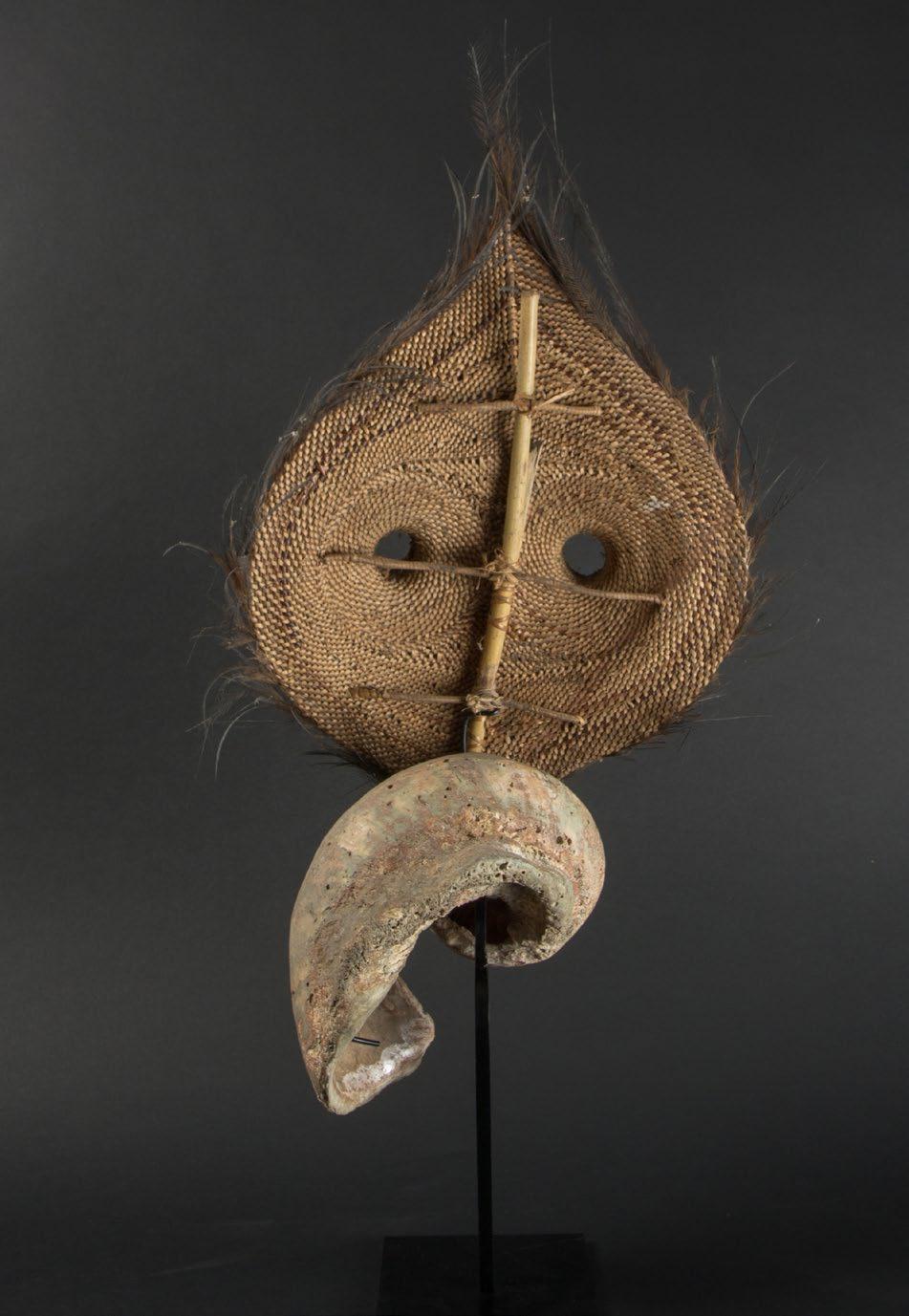
A rare Indonesian tortoiseshell betel box with gold mounts Batavia, jakarta
Early 19th century
5 cm (h) x 18 cm (w) x 13 cm (D.)
Price on request
A superb Indonesian royal gemset gold overlaid silver betel box Sumatra
19th century
Marked with initials HDL
5 cm (h) x 18 cm (w) x 13 cm (D.)
The box is overall overlaid with fine openwork and hammered gold and on the lid it has an applique in the form of a crowned flower surrounded by laurel wreaths, with beneath a crescent moon and initials HDL.
O B j ECT P RESENTED BY:
Zebregs&Röell +31 6 207 43671
dickie@zebregsroell.com www.zebregsroell.com
VETTED BY:

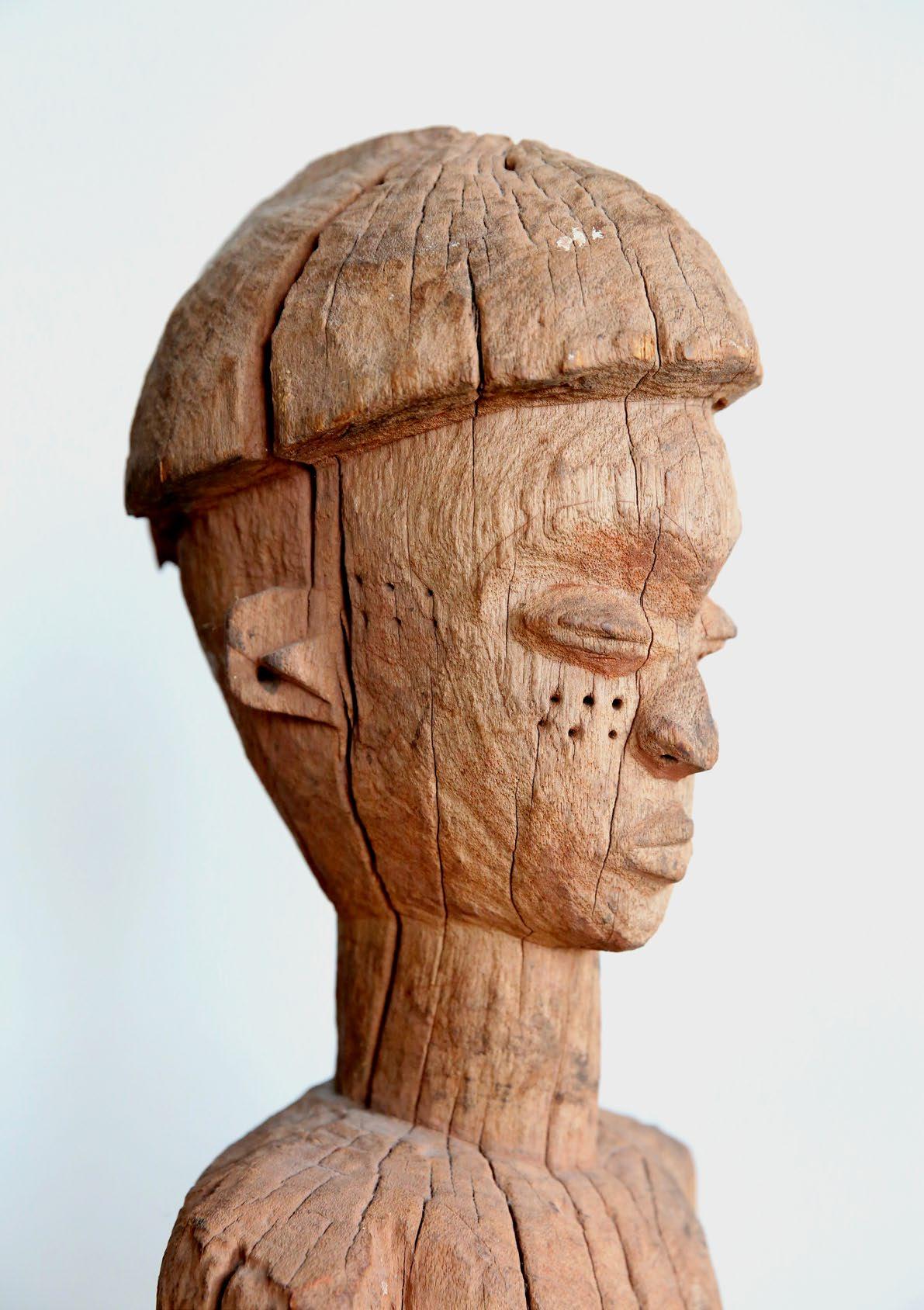
Female bust
Pende
D.R. of the Congo
Early 20th century
wood
Height: 63 cm
Provenance:
Private collection, Belgium
Price on request
ART w OR k P RESENTED BY:
Duende Art Projects
T.:+32 485 98 20 36
E.: bruno@duendeartprojects.com w.: www.duendeartprojects.com
VETTED BY:
The Pende people, numbering more than 500,000 today, have lived in southwestern Congo since the 17th century. They are a relatively decentralized, rural culture with numerous small chiefdoms. Decisionmaking in a village ideally derives from consensus among adult men, while a chief fulfills symbolic and religious roles, often serving as peacemaker and orator to keep the community united. Pende chiefs are responsible for mediating with the ancestors, whose care from beyond the grave is considered to be essential to the well-being of the chiefdom. To properly perform his role, a chief must have a special house where rituals are enacted. This female bust, once a full free standing female statue, once graced the roof top of the chef’s abode among the Eastern Pende. The house’s central pole would support such a rooftop figure. The statue’s head is crowned by the typical helmet-like Pende coiffure. Pierced row of holes under her slit eyes and on the temples mirror local scarification traditions. The figure’s left hand was positioned on the torso, where remnants of the fingers tips still remain.
The right lower arm must once have projected forward, holding an axe in the hand – as can be observed on other surviving Pende statues. The presence of such a weapon originally served as a warning to anyone of evil intent. Visible on the roof-top seen the size and elevated position, such a figure identified the hut as the chief’s abode. known as
“kishikishi”, the statue announced a chief’s
sacred domain and his training in sorcery, skills enabling him to lead and protect his people. The figure’s purpose was to announce the presence of secret powers within the chief’s residence, while at the same time deterring any wouldbe malefactors from the sacred space. The axe-wielding female guarded the secrets of chiefly power contained within this structure, which also served as the chief’s residence. The statue represents a chief’s first wife, who had several ritual duties regarding agriculture, and was a political force (dancing with an axe at the chief’s investiture), as well as was a spiritual emblem of the Pende community. Position on the roof top, such figures were subject to the harsh climatic conditions. Originally painted red, rain and wind would erode the statue’s surface over the years. Additionally, this wooden figure has suffered major deterioration, likely caused
once the chief’s abode collapsed after it became disused after his passing. It should be noted that the Pende deliberately avoid creating such statues out of permanent materials, such as stone or metal, there was not intention to make such powerful objects eternal, as each new chief had to commission his own figures, and people would be fearful to keep too many spirits around. The meditative gaze and eroded surface give this bust a timeless and universal appeal, while it continues to impress new onlookers.
The “kibulu” (ritual house) of Chief komba ornamented with a rooftop finial sculpted by k aseya Tambwe, photographed by Carlo Lamote, ca. 1947 (published in: Strother (Zoë S.), “Pende”, Milan, 5 Continents, 2008:33, fig. 6).


B UDDHIST ROBE ( kesa )
japan
Edo period (1615 – 1868)
First half of the 19th century
Compound weave with flat gilt paper strips as the predominant wefts, silk and gold
Height: 105,4 cm - (45.5 in.)
width: 191,8 cm - (75.5 in.)
Provenance:
Private collection, San Antonio, Texas, USA
Price: 1.500 USD
O B j ECT P RESENTED BY:
Alan kennedy
M.: +1 646 753-4938
E.: kennedyalan@hotmail.com w.: www.alankennedyasianart.com
VETTED BY:
The patchwork tradition in the construction of Buddhist robes dates to the beginnings of Buddhism more than 2,500 years ago, according to ancient texts. Buddhism arrived in japan sometime during the 6th century CE, and extant patchwork Buddhist robes (kesa in japanese) date as early as the 7th century CE.
Compared to other countries where Buddhism is practiced, the kesa of japan are the most varied in terms of textile techniques and designs. This example has motifs of a composite lion-dog and a peony in a roundel format, a type of dragon seen from above with a scalloped edging, and various stylized floral forms. The overall visual effect is quite sumptuous due to the extensive use of flat gilt paper strips, which provides an wide expanse of light-reflecting surface gold.

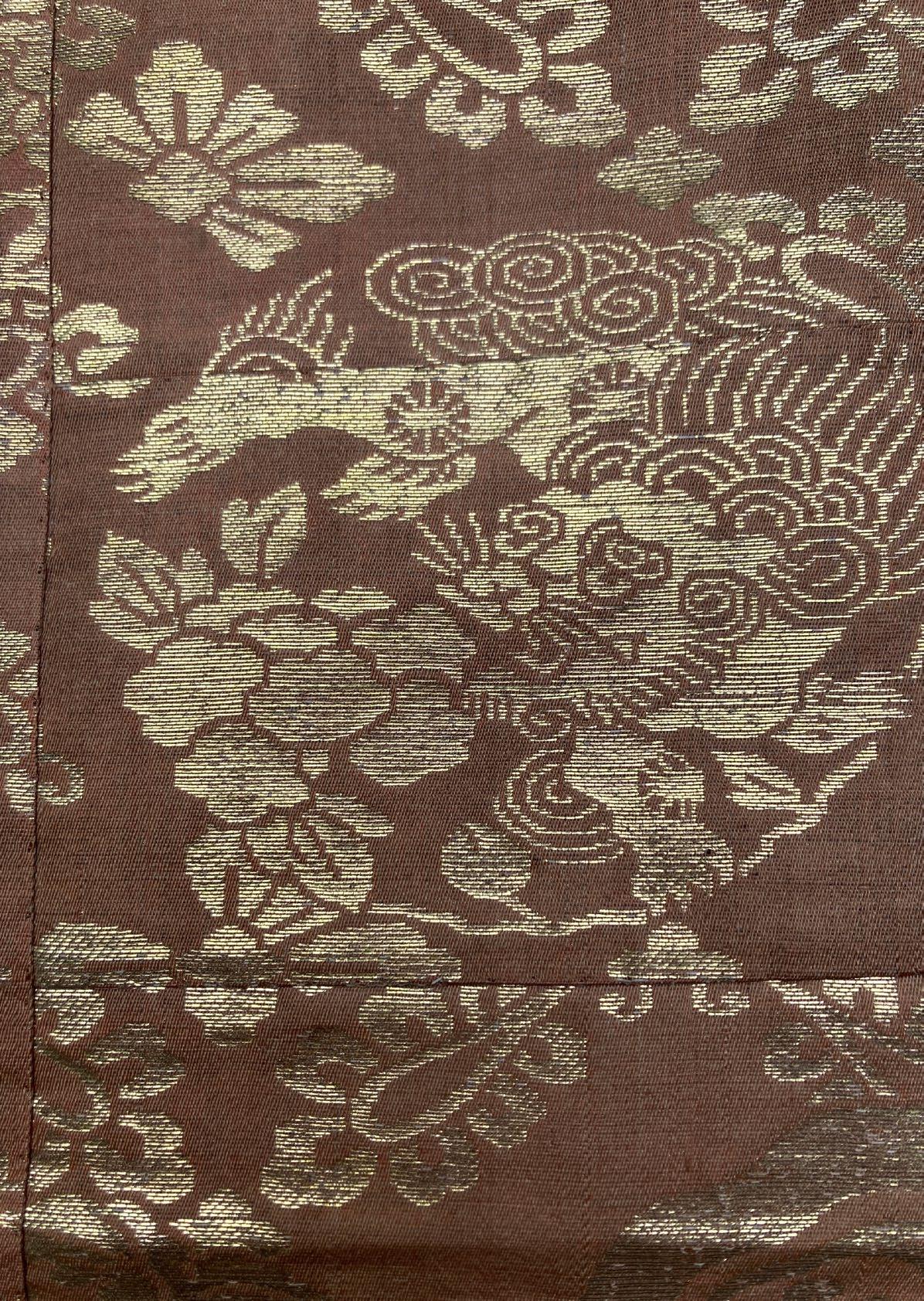
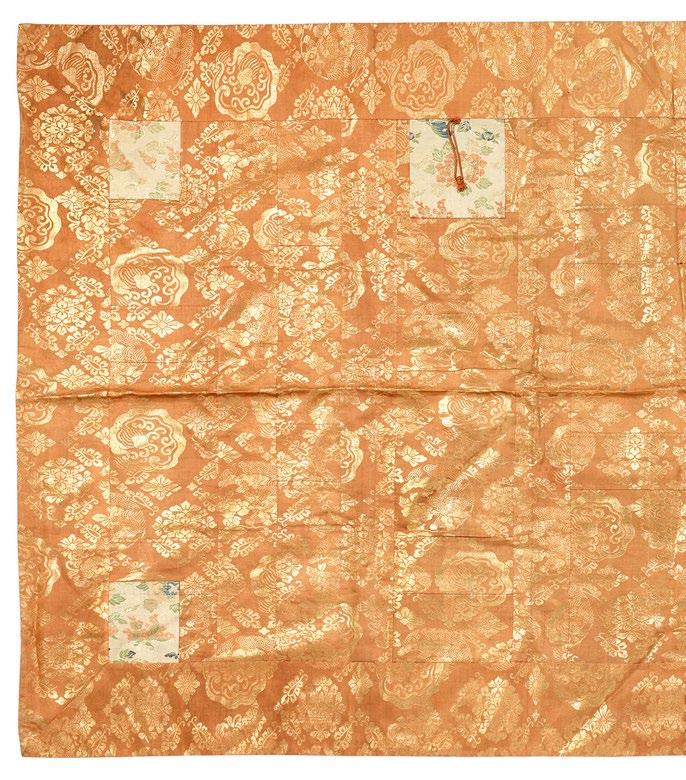
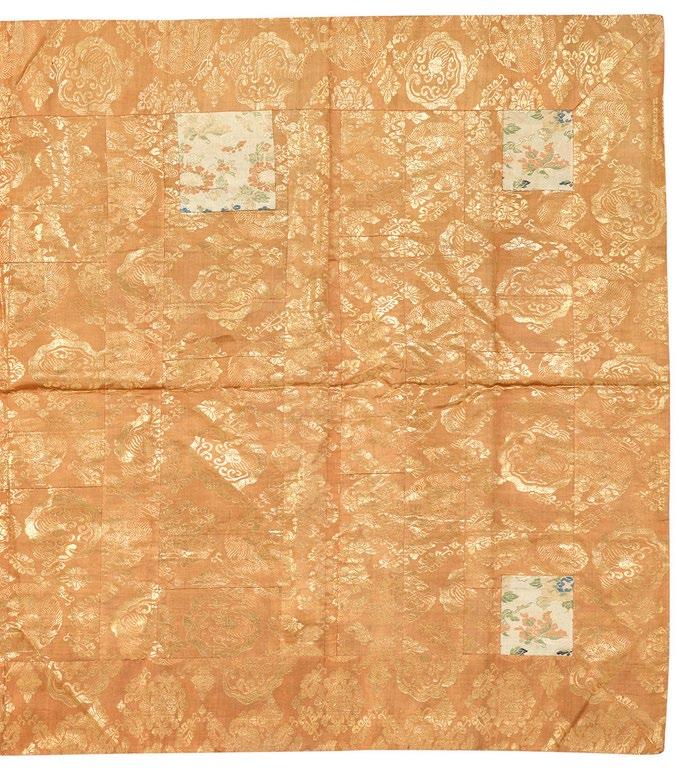
Beadwork Coils
Nguni
South Africa
19th century
Length: the longest is 90 cm
Provenance:
Private U.k . collection
Price: 3.800 euros
O B j ECT P RESENTED BY: Adam Prout
T.: + 44 7725 689 801 E.: adam@adamprout.com w.: www.adamprout.com
An exceptional collection of Southern African beadwork coils gathered over a lifetime. These ornaments would have been worn around the neck or as belts. As well as the obvious purpose of beatification (often during courtship) they would have conveyed the wealth and importance of the owners.
VETTED BY:

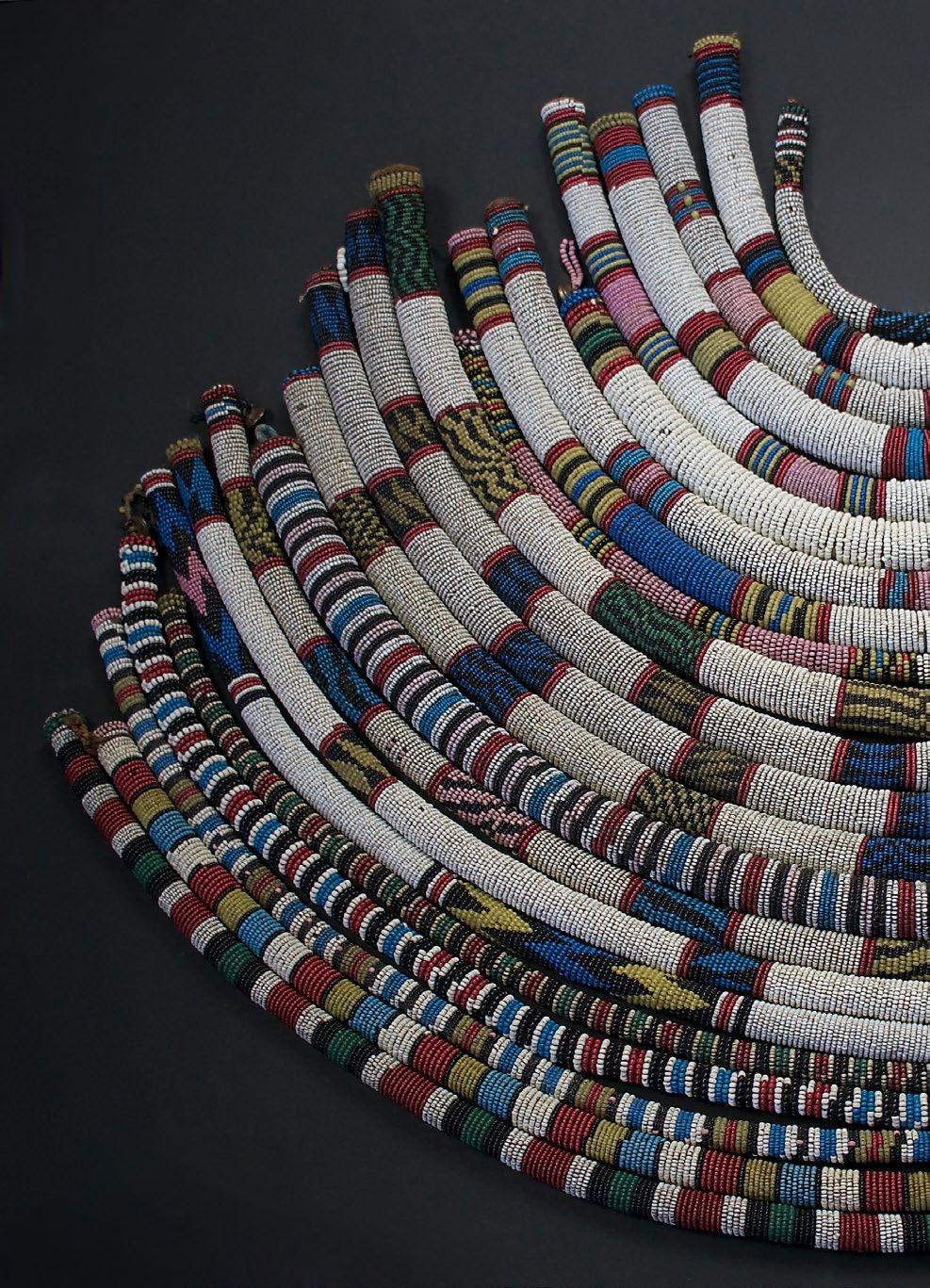
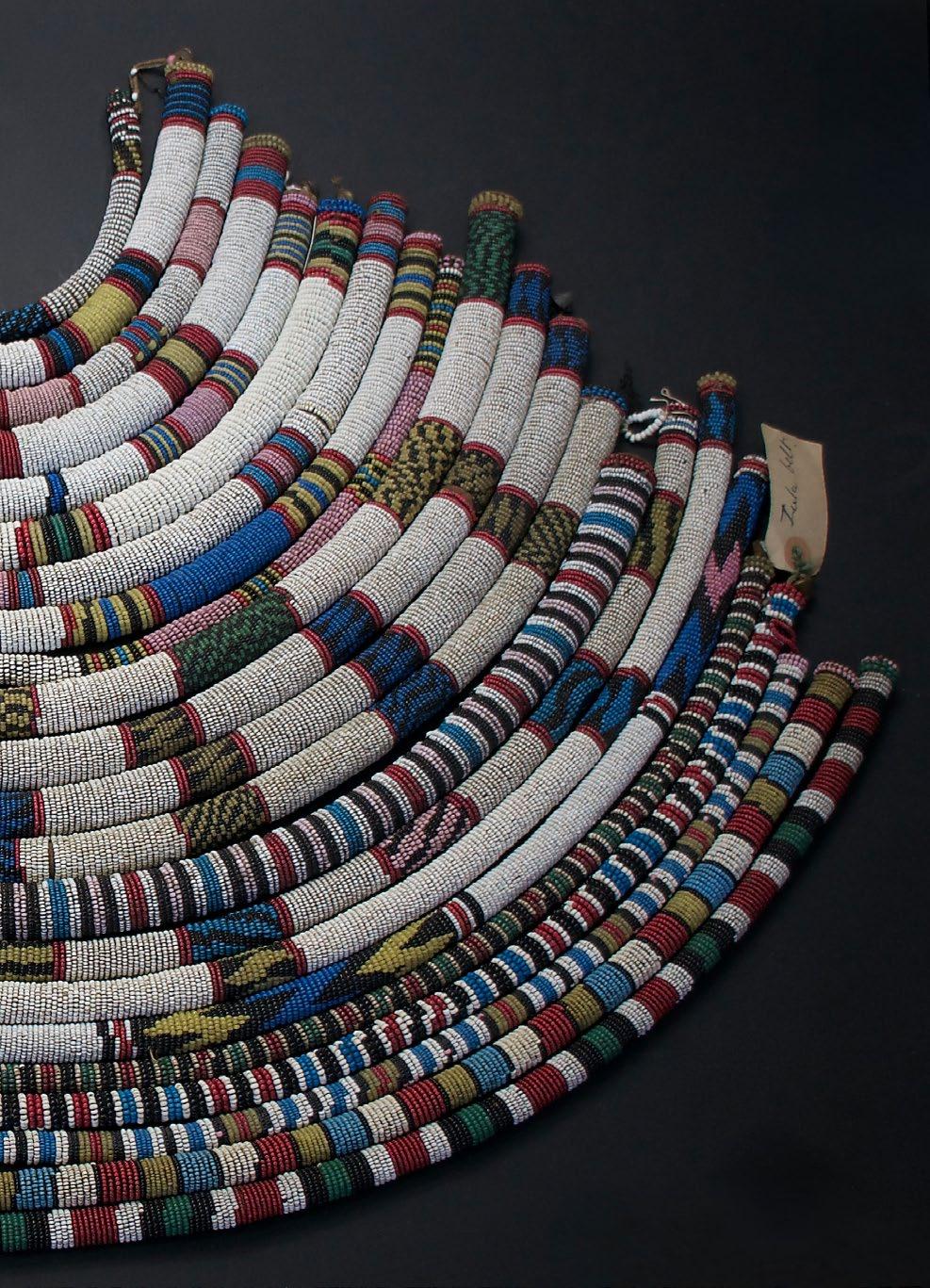
"Don't gain the world and lose your soul; wisdom is better than silver or gold."
Bob Marley
MIDA B UDDHA IN A DELICATELY FLO w ING ROBE STANDING ON A DOUBLE LOTUS BASE
japan
k amakura period 13th century
Gilt-wood
Figure: 80 cm (h) x 27 cm (w) x 20 cm (D.)
Stand: 11 cm (h) x 25,5 cm (w) x 23 cm (D.)
Figure and stand: 90,5 cm (h) x 27 cm (w) x 24 cm (D.)
Price on request
O B j ECT P RESENTED BY:
Gregg Baker Asian Art
M.: +32 (0) 468 00 56 85
E.: info@japanesescreens.com w.: www.japanesescreens.com
VETTED BY:
The right arm is raised and the left arm is extended with the forefinger and thumb of each hand forming a circle, representing the raigōin mudra, welcoming the believer into Amida's Great western Paradise.
The head has gyokugan (inlaid crystal eyes) and is also adorned with crystals representing the byakugō (white spiralling hair) on the forehead and the nikkei-shu (red jewel on the protrusion on top of the Buddha's head).
Belief in Amida as Lord of the western Paradise rose in popularity during the late 10th century. Based primarily on the concept of salvation through faith, it was not only a religion which appealed to a broad range of people, but also a direct assertion of piety against the dogmatic and esoteric ritual of the more traditional Tendai and Shingon sects. In Amida’s western Paradise the faithful are reborn, to progress through various stages of increasing awareness until finally achieving complete enlightenment.
Images of Amida, Lord of the western Paradise, are known in japan from as early as the 7th century. Until the 11th century the deity was most frequently portrayed in a gesture of teaching and was worshiped primarily in memorial rituals for the deceased. However in the last two centuries of the Heian period worshippers started to concentrate more on the ‘Teachings Essential for Rebirth’ written by the Tendai monk Genshin (942-1017). The teachings describe the horrors of Buddhist hell and the

glories of the western Paradise that can be attained through nembutsu, meditation on Amida or the recitation of the deity’s name.
Despite the apparent absence of formal variations in the images themselves, during the latter part of the Heian period important changes did occur in the nature of the rituals held in front of the Lord of the western Paradise. By the twelfth century Image Halls dedicated to Amida were the ritual centres of most complexes. The function of memorial services was expanded so they benefited not only the dead, but the living too. Even rituals with no historical connection to the deity, such as the important services at the start of the New Year, were also held there. Of particular significance were the novel ritual practices that were held to guarantee one’s rebirth in Amida’s western Paradise. Some, such as the re-enactment of the descent of Amida or the passing of one’s last moments before death clutching a cord attached to the hands of the deity, were entirely new whilst others, which included the use of halls dedicated to Amida as temporary places of interment, reflected the fusion of more ancient practices with doctrines of rebirth.
This particular style of Amida Nyorai sculpture is called Annamiyō (Annamistyle), a name which is derived from An-
amidabutsu, a Buddhist title given to k aikei (act. c. 1183-1223). Often compared with another kei-School great master Unkei (d. 1224), k aikei was one of the most important Buddhist sculptors in japanese art history, active in the late-Heian to k amakura periods. k aikei's works are generally known to be graceful, while keeping the reality of the figure. with the rise of the jōdo (Pure Land) Buddhism sect, k aikei, as a devout believer, produced a number of San-jaku Amida (standing Amida figures of approx. 80cm to 1m high) with raigōin, a mudra welcoming believers into the Great western Paradise, throughout his career. Their beautifully proportioned faces are gentle and intellectual, bodies are moderately fleshy and the pictorial robes drape delicately. In his later works, the drapery becomes more complicated, making the figures even more graceful. widely favoured as the ideal embodiment of Amida Nyorai in japan, k aikei’s style was carried on and developed by his followers and later generations. Most standing Amida figures produced during and after the time of k aikei are said to be more or less influenced by his style.
For comparable examples by k aikei, see: Nara National Museum ed., The Buddhist Master Sculptor k aikei: Timeless Beauty from the k amakura Period, (Nara, 2017), no.
83 (13th century, Daienji temple, Osaka); no. 85 (13th century, Enjōji Temple, Shiga); no. 87 (1221, kōrinji temple, Nara, Important Cultural Property); p. 156 (1211, Tōjuin temple, Okayama, Important Cultural Property); p.157 (c. 1221, kōdaiin temple, wakayama, Important Cultural Property)
Asia Society Museum ed., k amakura, Realism and Spirituality in the Sculpture of japan, (New Heaven and London, 2016), p.56-57, no. 4 (c. 1210, kimbell Art Museum, Texas, no. AP 1984.01 a,b,c)
For comparable examples of Amida Nyorai standing on a double lotus base see: Tokyo National Museum ed., Tokubetsuten k amakura-jidai no Chōkoku [Special Exhibition: japanese Sculpture of the k amakura Period], exhibition catalogue, (Tokyo, 1975), no. 61 (dated 1259, by Eisen, Tokyo National Museum, Important Cultural Property);
Nara National Museum ed., The Buddhist Master Sculptor kaikei: Timeless Beauty from the kamakura Period, (Nara, 2017), no. 62 (attributed to Gyokai, 1212, jodo-school, kyoto, Important Cultural Property)
Asia Society Museum ed., k amakura, Realism and Spirituality in the Sculpture of japan, (New Heaven and London, 2016), p.102, no. 25 (mid-late 13th century, Asia Society, New York: Mr and Mrs john D.
Rockefeller 3rd Collection)
For comparable examples in bronze from k amakura period see:
Nara National Museum, Bronze Sculpture of the Heian & k amakura Periods (Special Exhibition), (kyoto, 1976), p. 23, no. 47 (Yakushi Nyorai, Ryūsenji temple, Akita), no. 48 (Yakushi Nyorai, dated 1248, Ryūzen, Obama-city, Fukui), p. 32, no. 74 (Amida Nyorai, dated 1314, kinonesawa, Chiba).
Radio Carbon Dating Ref: RCD-9283
n.b. The right hand and part of the robe beneath it have been re-carved and regilded. The left foot has been re-carved and re-gilded. The right foot has been re-adhered with a small repair to the surrounding area. The tips of both middle fingers of the left hand have been repaired and re-gilded.
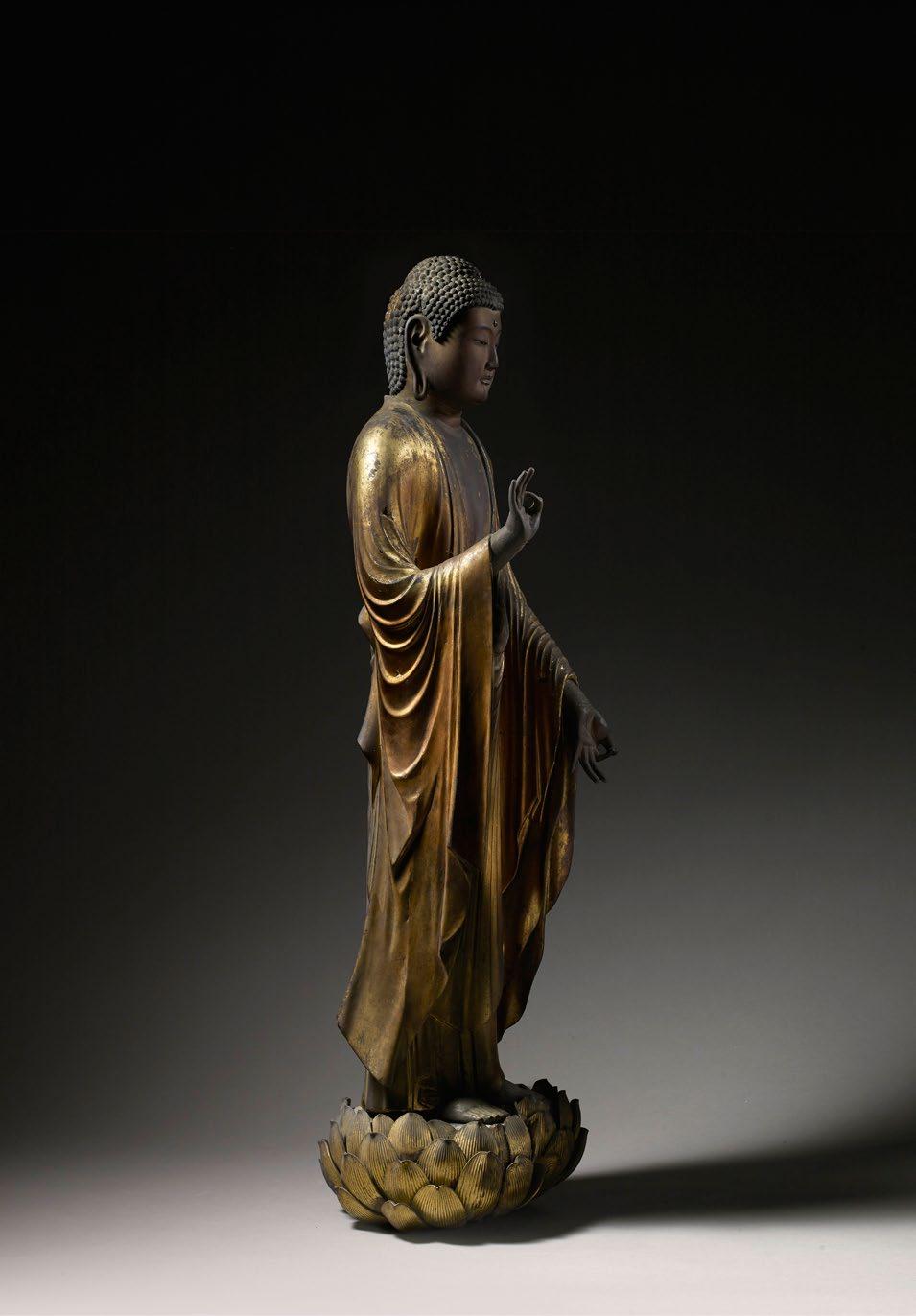

China
1780-1880
Height: 7,8 cm
Mouth/lip: 6/1,75 cm
Coral stopper, gilt-bronze collar
Provenance: Vanessa F. Holden, New York 1997
Ruth and Carl Barron, Massachusetts, no. 2543
Christie’s, New York, 13 September 2017, lot 322
Hugh Moss (Hk ) Ltd
Price on request
ART w OR k P RESENTED BY:
Pavilion, London
T.: +44 (0) 7523 018239
E.: info@paviliongallery.com w.: www.paviliongallery.com
VETTED BY:
Translucent spinach-green nephrite; with a concave lip and foot; engraved on one main side in regular script with the well-known poem by jia Dao (AD 799-843) Seeking but not finding the Master, the script filled with gold pigment.
One translation of the poem reads:
I asked the boy beneath the pines [who replied], ‘My Master’s gone to gather herbs. I only know he’s on this mountain. But the clouds are too deep to know where.’



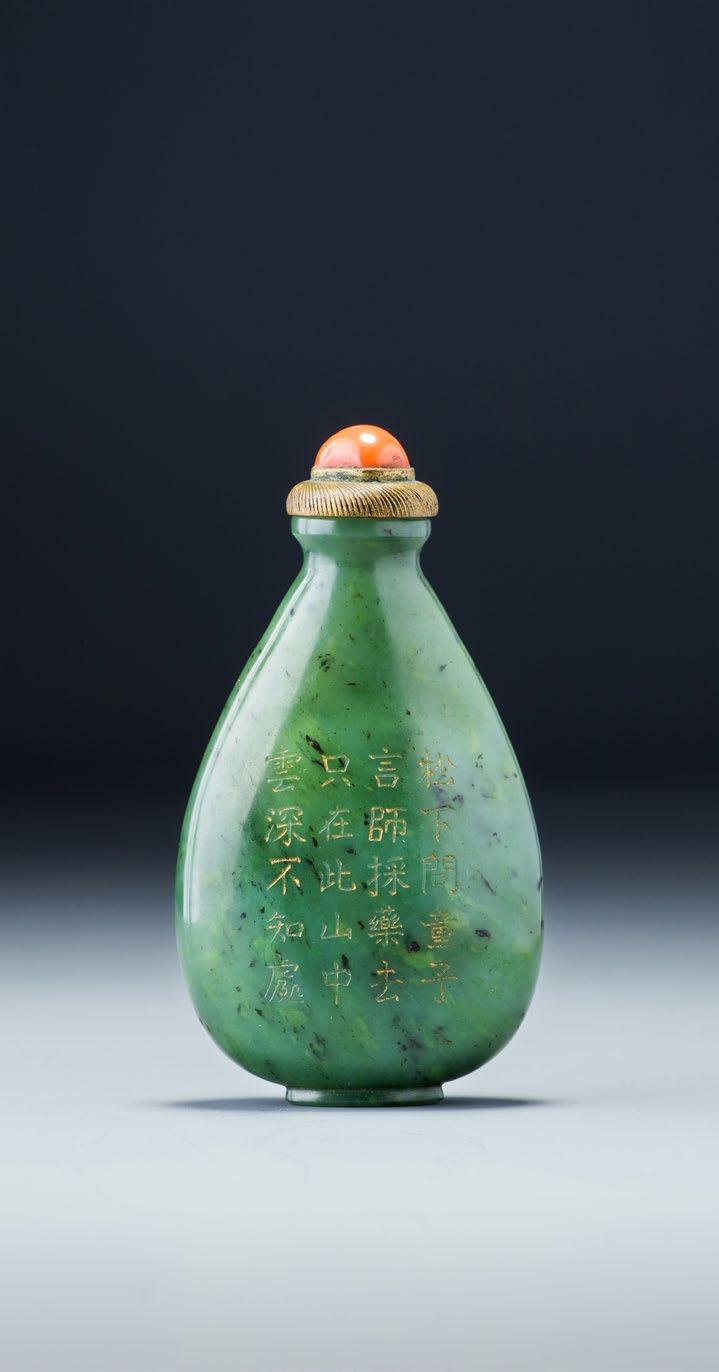



Morita Shiryū (1912-1999), signed, titled and dated 1967 on a label affixed to the reverse, framed japan 1967 En (Circle) aluminum flake pigment in polyvinyl acetate medium and yellow alkyd varnish on paper and wood panel
74,5 cm (h) x 103,5 cm (w) Exhibition:
Seeing Round Corners, Turner Contemporary, Margate, Sat 21 May - Sun 25 Sep 2016 Price on request
ART w OR k P RESENTED BY:
Gregg Baker Asian Art
M.: +32 (0) 468 00 56 85 E.: info@japanesescreens.com w.: www.japanesescreens.com
VETTED BY:
Morita Shiryū was born in Toyooka, Hyogo Prefecture and studied sho (calligraphy) under the influential and ground-breaking calligrapher Ueda Sōkyū (1899-1968). Sōkyū was a charismatic teacher introducing his talented pupils to avant-garde sho and its definition as the art of the line.
Having received numerous awards from important japanese exhibitions such as the 1937 Inten ( japan Art Institute Exhibition) where he won the Tokusen silver award, Morita became more and more fascinated with the performance involved in the writing of sho and the similarities between the expressive calligraphic line and what was developing within the Abstract Expressionist art scene of the west. In 1948 he launched the magazine Shonobi (beauty of calligraphy) under the leadership of his master Ueda Sōkyū with the intention of promoting avant-garde sho.
The notion of abstraction had been part of the practice of East Asian calligraphy for
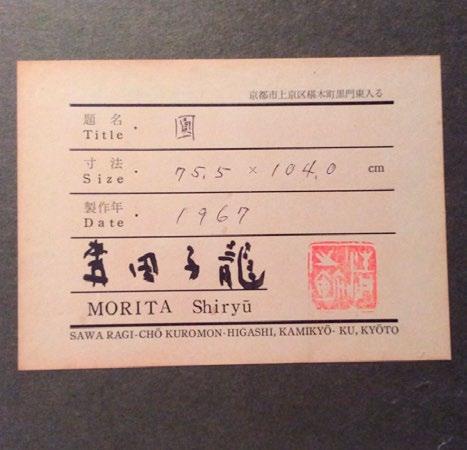

many centuries, and Morita often wrote about the interplay between traditional japanese calligraphy and abstract art in the west. These observations were catalogued in a second journal entitled Bokubi which was first edited and published by Morita in 1951 and featured an image of a calligraphic painting by Franz kline on its cover. Distributed internationally, the journal became extremely influential within the western art world, causing a further interest in the japanese aesthetic followed by an array of collaborations and international exhibitions with European artists of the Abstract Expressionist movement such as Pierre Alechinsky (b.1927) and Georges Mathieu (1921-1912), and American artists Mark Tobey (1890-1976) and Franz kline (1910-1962). with the help of such innovative publications and the possibility of international exposure, modern japanese calligraphers such as Morita and fellow like-minded artist Inoue Yūichi soon became an international sensation.
In 1952, five disciples of Ueda Sōkyū including Morita co-founded the legendary Bokujinkai (Society of Ink People). He joined forces with Inoue Yūichi (1916-1985), Eguchi Sōgen (1919-), Sekiya Yoshimichi (b.1920) and Nakamura Bokushi (dates unknown) and together they further advocated the emancipation of the calligraphic line away from its traditional form and experimented using unorthodox materials. The beauty of the line itself is held as a self-evident attribute and the execution of the writing becomes the focus. Morita placed the performance
of a piece at the centre of his definition of calligraphy. The kanji character is written in one defining moment with confident strokes. The calligrapher penetrates to a deeper level of understanding and the character is understood in a different, more profound way.
In terms of style and format, Morita Shiryū’s works are groundbreaking. He preferred to use an oversized brush, working quickly across the surface. whilst works such as the example presented here may appear to be executed using the rather slow process of japanese lacquer, in actuality the metallic silver paint is applied swiftly onto the surface and later covered with a coat of fast drying yellow varnish achieving a similar effect. Morita’s vigorous style often results in abstract forms which no longer appear to be recognisable characters yet they retain their original essence enhanced with a new vitality.
works by the artist can be found in the collections of: Art Institute of Chicago, kyoto Municipal Museum of Art, Cincinnati Art Museum, Saint Louis Art Museum, Missouri
Selected solo exhibitions:
1963 Sho Modern Calligraphy, Mi Chou Gallery, New York
1964 Yamada Gallery, kyoto
1965 Olaf Hudtwalcker Gallery, Frankfurt
1970 - 1990 Morita Shiryū, National Gallery of Canada, Ottawa (exhibition toured the world)
1986 Morita Shiryū, kyoto Munincipal
Museum of Art, kyoto
1990 Ein japanischer Schreibmeister, klingspor-Museum, Offenbach am Main, Germany
1992 Shiryu Morita and Bokubi, Hyogo
Prefectural Museum of Modern Art, kobe
2013 Modernist Sho Calligraphy – Paintings by Shiryū Morita, john Molloy Gallery, New York
Selected group exhibitions:
1937 2nd Inten Exhibition, Tokyo – Tokusen silver Award
1938 Nichiman Calligraphy Exhibition, Tokyo - Ministry of Education Award
1953 japanese Architecture and Calligraphy, Museum of Modern Art, New York
1954 japanese and American abstraction, National Museum of Modern Art, Tokyo
Abstract japanese Calligraphy, Museum of Modern Art, New York
1958 Carnegie International Exhibitions, Pittsburgh
Modern Abstract japanese Calligraphy, The Museum of Modern Art, New York
Abstract Painting Exhibition, National Museum of Modern Art, Tokyo
1959 São Paulo Art Biennial, São Paulo
1960 japanese calligraphy, Freiburg, Germany
1961 São Paulo Art Biennial, São Paulo
Carnegie International Exhibitions, Pittsburgh
1962 Contemporary japanese Plastic Arts, Tokyo National Museum of Modern Art, Tokyo
1963 Tendency of Contemporary japanese Painting, National Museum of Modern Art, Sydney
Modern Trends, National Museum of Modern Art, kyoto
1964 Contemporary japanese Painting, Corcoran Gallery of Art, washington, D.C.
1966 japanese Art Today, Philadelphia Museum of Art, Philadelphia
1992 Calligraphy and Painting: The Passionate Age: 1945-1969, O Art Museum, Tokyo
1994 japanese Art After 1945: Scream Against the Sky, Yokohama Museum of Art, Yokohama and Guggenheim SoHo, New York
2002 writepainting: Marks in a japanese Vein, Museum of Fine Arts, Gifu
For a pair of panels by the artist treated in a similar manner see: The Collection-kyoto Municipal Museum of Art 1993, p.266, no.30. For a large four-fold screen see: Beyond Golden Clouds japanese screens from The Art Institute of Chicago and the Saint Louis Art Museum, pp. 196/197.
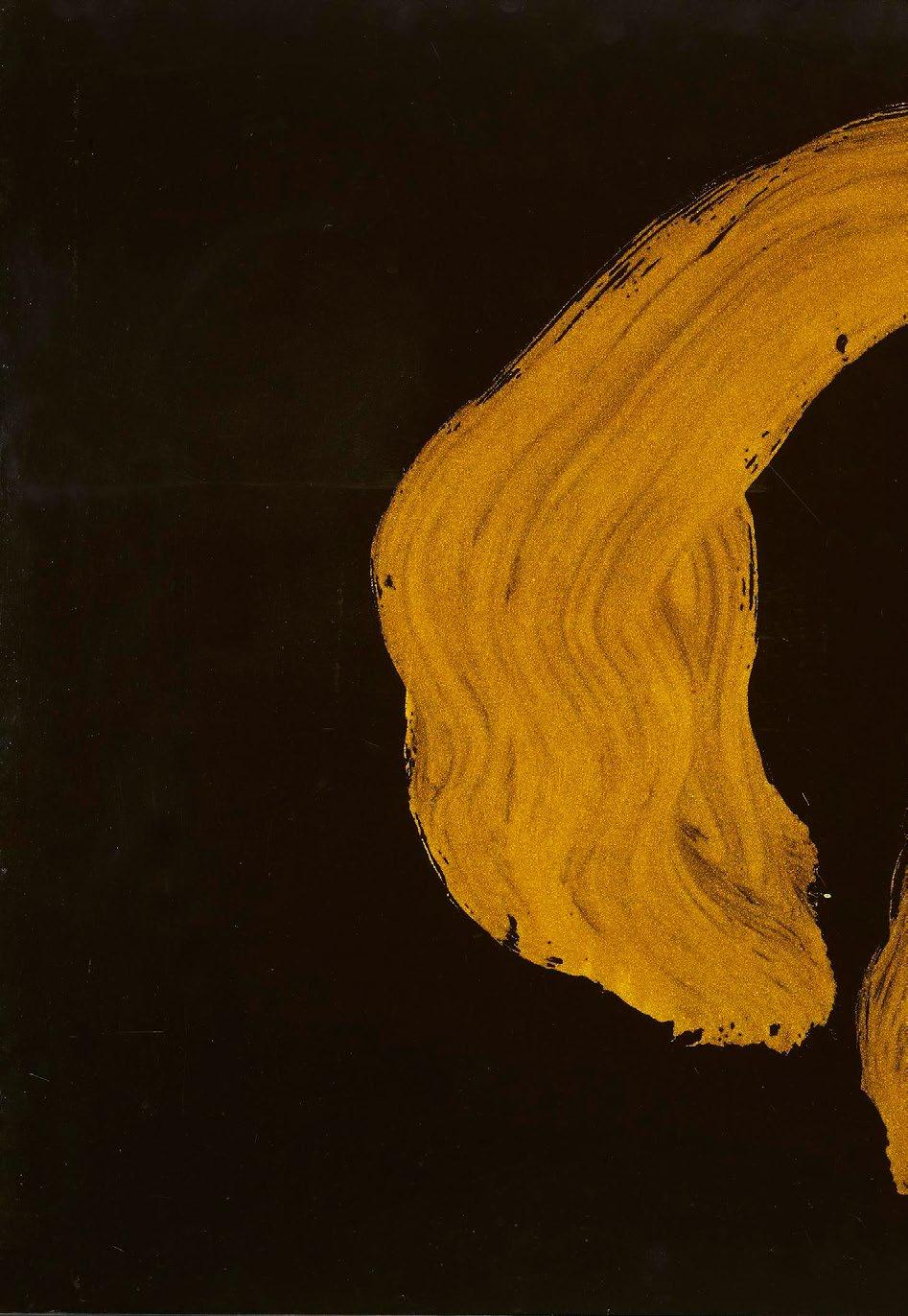

VA j RADHARA
Tibet, India
15th century Gilt-bronze
Height: 24,8 cm
Publication:
Himalayan Art Resources, item no. 8375.
Provenance:
Holger Rosell (1917–2009), Stockholm
The collection of the National Museum Prins Eugens waldemarsudde, Stockholm
Uppsala Auktionskammare, 5 December 2014, lot 1001
Price on request
O B j ECT P RESENTED BY:
k apoor Galleries
M.: + 1 (212) 794-2300
E.: info@kapoors.com w.: www.kapoors.com
VETTED BY:
The present figure represents the primordial buddha Vajradhara. His hands—crossed in front of his heart in vajrahumkara mudra (the gesture of the ‘adamantine sound’) holding a vajra/dorje and ghanta/drilbu (bell)—make him easily recognizable. His elaborate ornaments identify him as a symbolic buddha in bodhisattva appearance.
This lustrous figure of Vajradhara is finely sculpted on a double-lotus base, clad in a dhoti with a shawl draped over his shoulders, flowing down symmetrically on either side of his torso to rest on his seat. An urna of inset turquoise sits below his fiveleaf tiara behind which his hair is pulled into a neat pile surmounted by a half vajra. The complexity of the woven knots within his chignon is revealed from the backside of the sculpture, as is the careful execution of each element, despite the fact that these facets are frequently hidden.
The sculpture is embellished with small turquoise and ruby or garnet cabochons set in bezels to accentuate his crown, necklace, armbands, and belt—a style of inlay more common among Nepalese bronzes than Tibetan ones. However, the square face, the straight slope of the buddha’s nose in profile, the exclusion of a garuda element from the crown, and the festooned design of Vajradhara’s prominent necklace point to a Tibetan origin.
 180
180
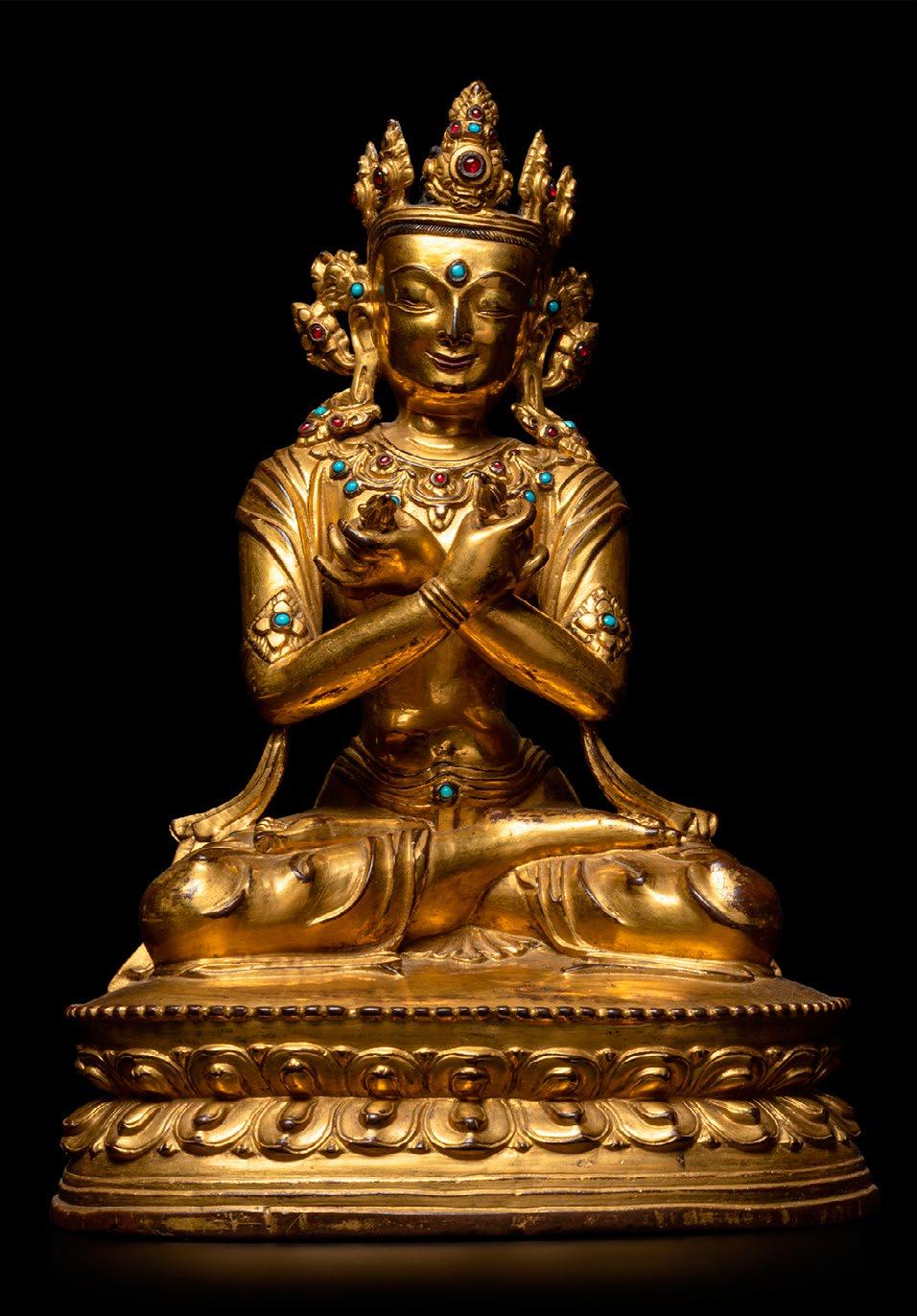
Sri Lanka / Ceylon 18th century
Gilt cast bronze
weight : 11kg
Height: 25 width: 24 cm
Price: 48.000 euros
O B j ECT P RESENTED BY: Alexis Renard
T.: +33 1 44 07 33 02
E: alexis@alexisrenard.com w.: www.alexisrenard.com
VETTED BY:
This beautiful gilt bronze Buddha is a testament to the great refinement of Ceylonese sculpture during the kingdom of k andy. The characteristics of physical perfection (lakshanas) are traditionally conferred on Shakyamuni Buddhas.
This example is represented sitting in the virasana pose, his hands turned up towards the sky in dhyana mudra. Finely engraved circles can be seen on his palms, as well as the sole of his right foot, which also faces the sky. His imposing figure is dressed in a pleated garment that drapes over his left shoulder and covers his legs. The finely carved lines defining the folds of the garment evoke early Buddhistic images from Mathura.
The Buddha’s serene face has fine features, and a delicately engraved spiral-shaped urna on his forehead. His ear lobes are elongated, symbolising his nobility, and his headdress takes the form of a stylised flame. This Buddha is a perfect example of the continuation of the Sinhali tradition of bronzework, which tended to represent the Buddha with a robust body and dressed only in a pleated cloth.
The independent kingdom of k andy, founded in the 15th century, became the main political authority in 17th-century Sri Lanka. It resisted various local invasions until the arrival of the British in 1818. This beautiful solid cast piece is particularly heavy, enhancing its spiritual value.
A standing Buddha of the same period is held at the Metropolitan Museum of New York (Inv. n. 2010.68a, b).

"Nature’s first green is gold, Her hardest hue to hold. Her early leaf’s a flower; But only so an hour. Then leaf subsides to leaf. So Eden sank to grief, So dawn goes down to day. Nothing gold can stay."
Robert FrostThese rare mask elements were sewn down on a cloth that would cover the face of a deceased aristocrat in burial.
Philippines 10th - 15th century Gold
Provenance: william Beyer
Hilburg
on request
VETTED BY:

Thailand
Sukhothai period
14th century AD (dated by test)
Olive-green glazed celadon
Height: 22 cm
Provenance: Private Suisse collection
TL-Analysis (Laboratory R.kotalla) no. 03090907 dated 11.09.2007
Price on request
O B j ECT P RESENTED BY:
Farah Massart
M.:+32 495 289 100
E.: art@famarte.be w.: www.famarte.com
Most probably this vessel was made at the kilns in Si Satchanalai, where glazed celadon was produced from the 14th to the 16th centuries. These kilns were situated on the river Yom in north-central Thailand, north to the town of Sawankhalok. Sawankhalok was the name used to describe the highfired stoneware that is now known to originate from Si Satchanalai. The centre of production was under the cultural direction of Sukhothai kingdom.
This olive-green glazed celadon with animal design and elaborate figures is executed with a lot of detail. The elephant with three heads could be the mythical elephant Airavata or the so called Erawan in Thailand, carrying three drivers. The elephant’s trunks hang downwards. The ear hole is presumably to allow the hot air to escape during the firing. The content of the receptacle could have been of a sacred nature.
Si Satchanalai wares were important Thai export products that have been discovered from shipwrecks around the Strait of Malacca, Gulf of Thailand and South China Sea and probably exported on maritime trade route to Southeast Asian and African markets.
VETTED BY:

japan
Meiji period
19th century
Painted in ink and colour on a gold ground with red and white chrysanthemums behind a brushwood fence, both rendered in moriage (raised design)
170 cm (h) x 188 cm (w)
Price on request
By the Heian period (794-1185), chrysanthemums or kiku were cultivated as ornamentals in japan while the plant's medicinal qualities have been celebrated since pre-Nara period (pre-710). The Edo period (1603-1868) was a time when gardening boomed and from the early Edo period, as enthusiasm for gardening grew, various species of chrysanthemums were produced and the flower shows for new types of chrysanthemums called kikuawase (chrysanthemum matching) were also held amongst the people.
japanese interest in chrysanthemum as a theme for poetry also developed during the Heian period. At that time, with the evolution of a native artistic sensibility heavily influenced by the passing seasons, the flower gained its place as one of the premier symbols of autumn. In many instances, the flower appears in ensemble motifs with all or some of the Seven Grasses of Autumn, and it is sometimes included in enumerations of this group.
The first use of chrysanthemum as a symbol
O B j ECT P RESENTED BY:
Gregg Baker Asian Art
M.: +32 (0) 468 00 56 85
E.: info@japanesescreens.com w.: www.japanesescreens.com
VETTED BY:
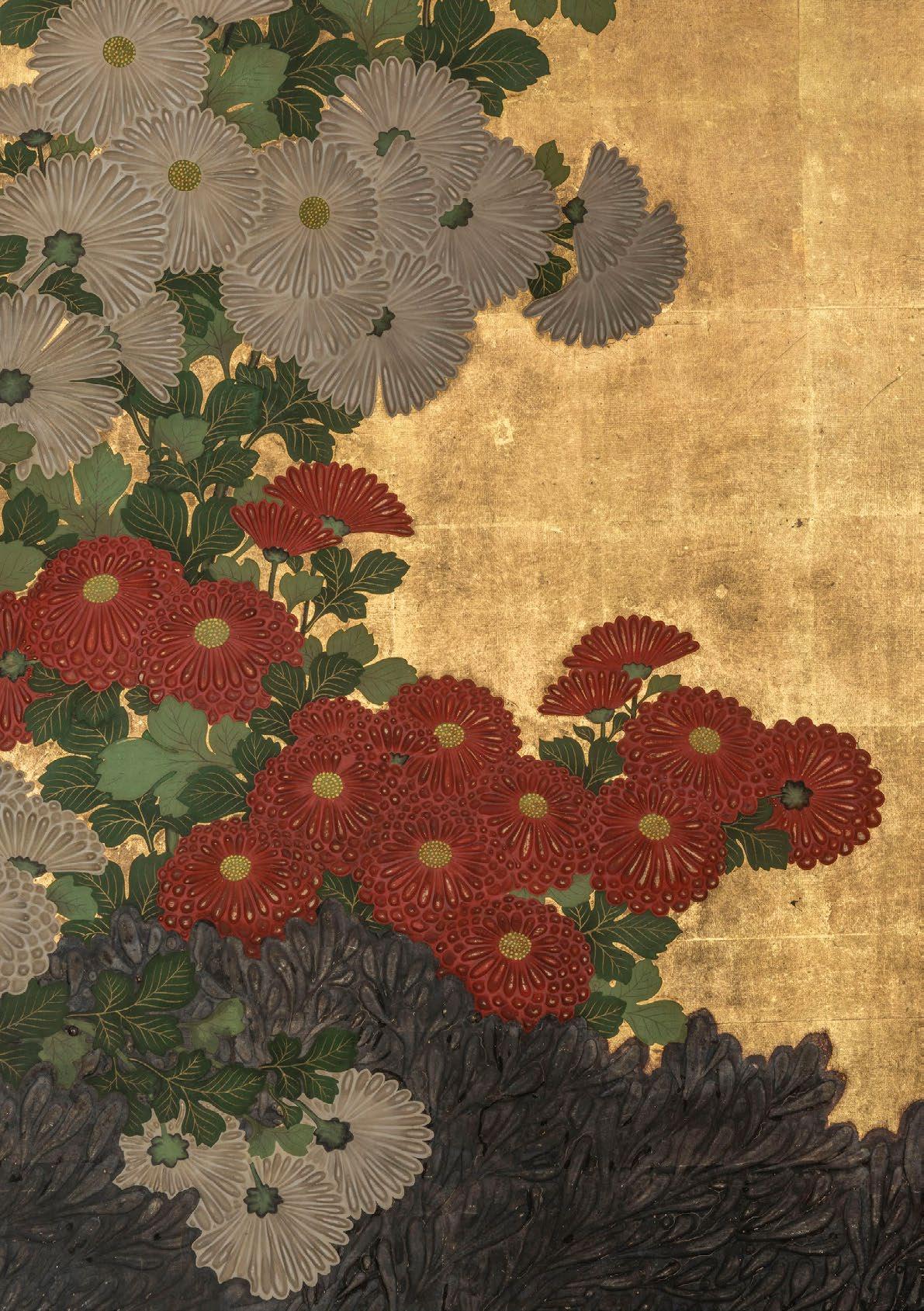
of the japanese Emperor and the Imperial family occurred in the thirteenth century when Emperor Go-Daigo adopted the flower as a crest and it was continued by successive Emperors. Later many commoners also used chrysanthemum as a family crest, and a Matsuya store catalogue of 1913 included 95 crest designs based on this flower.
n.b There is repair to a small tear at the bottom of the left-hand panel near the hinge and there is a small dark mark just to the left of this area. There are two further small tears near the hinge at the top of the screen and throughout the screen there are small marks and imperfections commensurate with age.

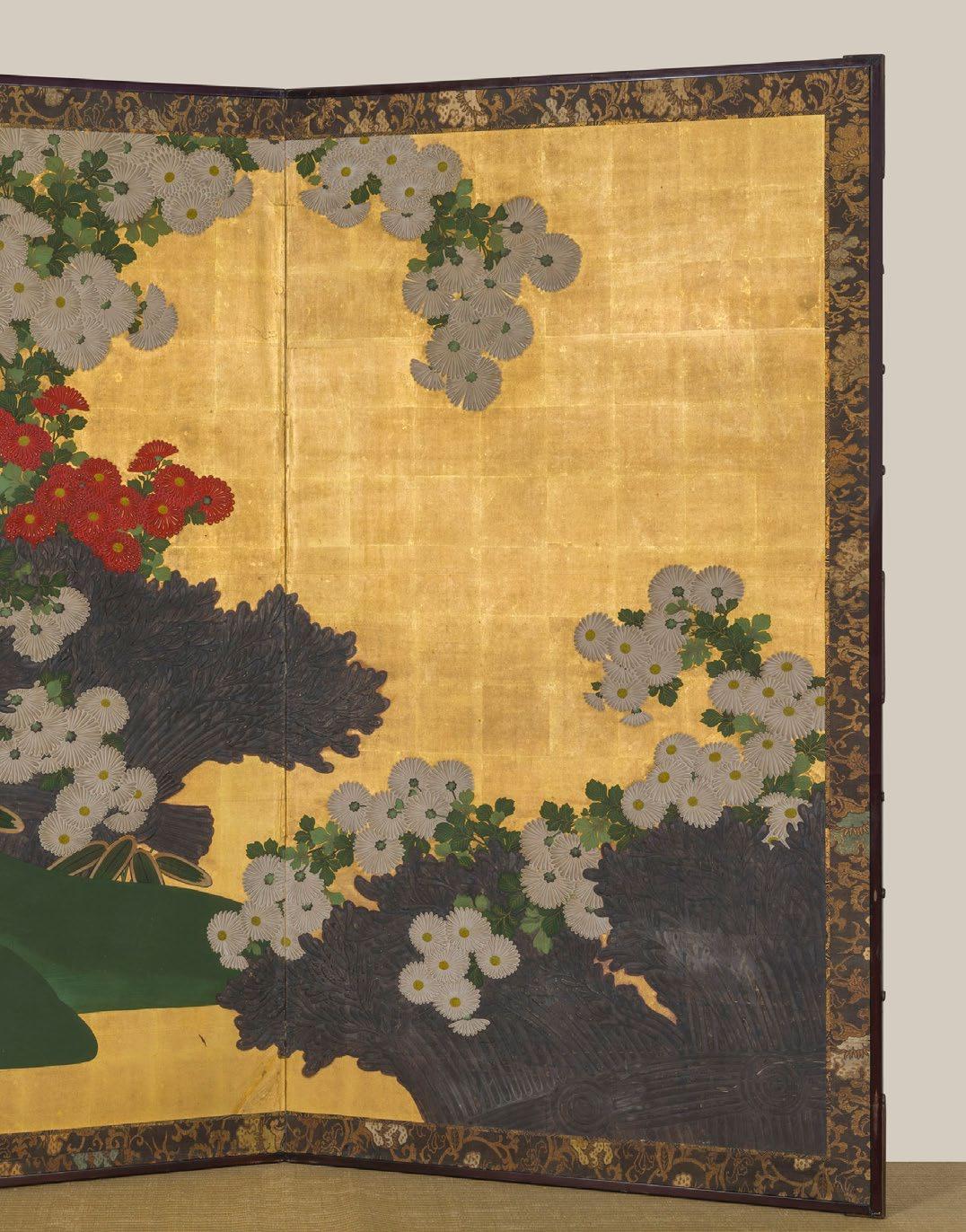
Guangzhou, China 18th century
265 cm x 215 cm
Price on request
O B j ECT P RESENTED BY:
Brandt Asian Art
M.: +44 (0)7774 989 661
E.: brandt@nildram.co.uk w.: www.brandtasianart.com
A large and spectacular coverlet embroidered in coloured silks on an imperial yellow ground. The central medallion with a large, stylised chrysanthemum surrounded with exotic rococo floral swags. The inner corners decorated with shields entwined with further floral designs, the matching boarder with further meandering flowers.
VETTED BY:
 196
196

Grave post
Giryama kenya
Early 20th century wood
Height:182 cm
Provenance:
Acquired in situ by jean-Pierre jernander (1939-2015), Brussels, 1974
Private collection, Belgium
Private collection, Antwerp
Price on request
O B j ECT P RESENTED BY:
Duende Art Projects
T.:+32 485 98 20 36
E.: bruno@duendeartprojects.com w.: www.duendeartprojects.com
The Giryama people of the kenyan coast are known for their long- standing tradition of carved wooden funeral posts. “Vigango” were carved and installed exclusively by and for members of the Gohu society, a semi-secret, fraternal organization whose members were male elders who had been elected for their wisdom and experience, and were able to pay the substantial membership fees. Shortly following the death of a Gohu member, his family would commission the local Gohu society to carve a kigango in his honor and host a feast to accompany its installation. These grave posts then served a number of functions.
Beside their primary function as grave markers, they also fulfilled an important role as mediators between the world of the living and the ancestral realm. “Vigango” honored the power and presence of the ancestor spirits (known as koma). They served as a locus to which an ancestor’s spirit could be called to be propitiated and asked to secure the favorable disposition of more powerful spirits to undertakings such as a risky journey or the cure of an illness. At the base of each “kigango” a cup (often made of a coconut shell) was placed, into which members of the deceased’s family put small offerings of palm-wine, food, snuff, etc. when they wished to gain the attention and help of their representative in the ancestor world. The iconography of these grave posts
VETTED BY:

intended to be naturalistic. They are characterized by an abstract rendering of the head and facial features combined with a symmetric handling of simple geometric decoration on the pole-like body. The head portion of the post takes the shape of a circle and includes simplified representations of human features such as eyes, a nose, and occasionally a mouth. The rectangular neck connects the head to the long rectangular torso. The arms and lower limbs are never represented.
As the “kigango” was intended to stand erect at the head of a grave for a long time, its body was trimmed down to a narrow, flat form that could penetrate the earth sufficiently for it to be held securely. This stela-like body fulfilled an aesthetic function as it served as a field of decoration. Its front surface was divided into carefully planned, symmetrical frames containing an assortment of dentate bands, concentric circles, serpentine lines, and lozenges. The exact significance of these patterns is not known; they likely have multiple interpretations. The back of the figure was only minimally decorated, in a style identical to that on the front. The geometrical designs originally were filled with red ocher, white ash or charcoal, all of these mixed with the latex of euphoria to a
texture with hardened like enamel, and thus impairing an inlaid effect. Such a cloisonnélike technique is seldomly encountered in classical African art. It should be noted these grave markers were not permanent memorials. They were only taken care of as long as the commemorated individual was remembered. “Vigango” thus came to be abandoned within a few generations of their installation. Carved of nzizi wood, an extremely hard wood resistant to insect deterioration, these grave markers were traditionally allowed to stand until they naturally decomposed. “Vigango” could only be moved once and were then left behind as the village relocated a second time. They were substituted at subsequent village locations by a replacement post known as a “kibao” (plural: “vibao”), thereby transferring away whatever spiritual power was thought to remain from the original “kigango”. This was a natural result of the Giryama’s centuries old practice of slash and burn agriculture and, subsequently, the periodic changing of village locations. Burn marks can be observed at the lower half of this post, and the wood’s deep erosion indicates its old age.
